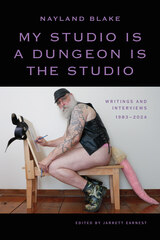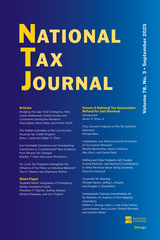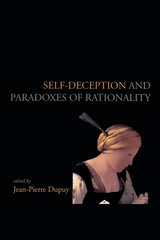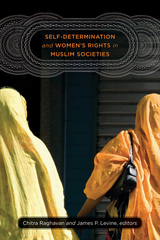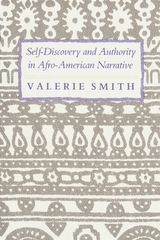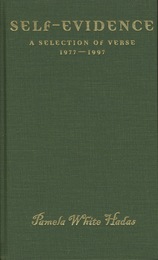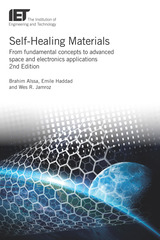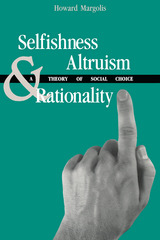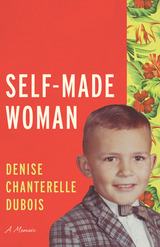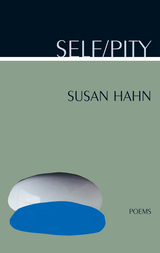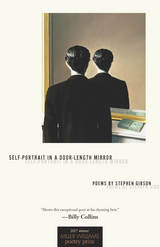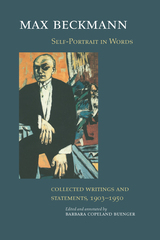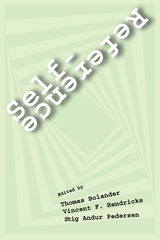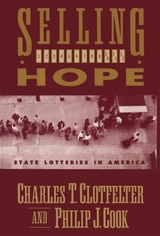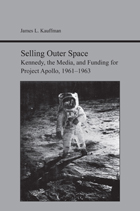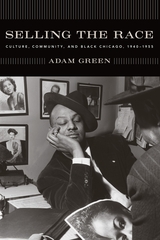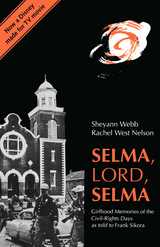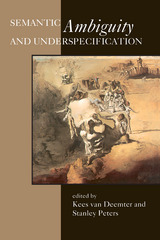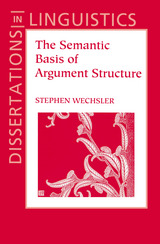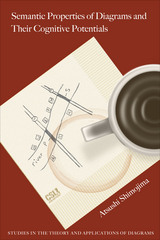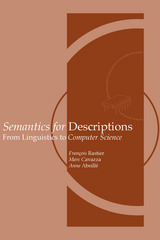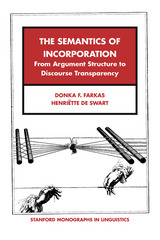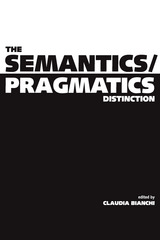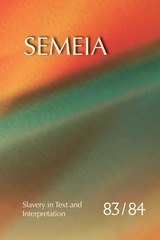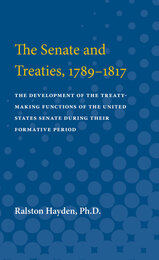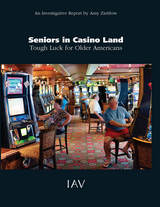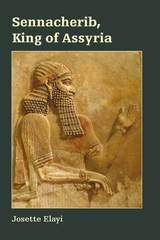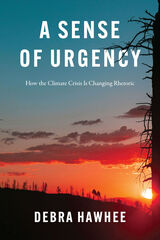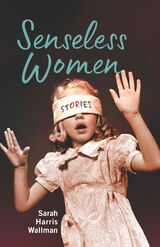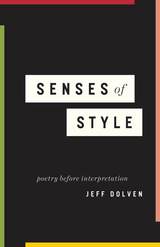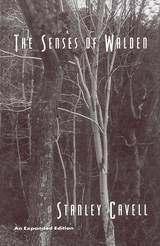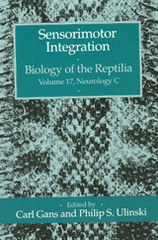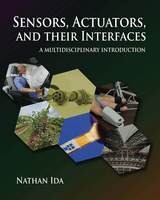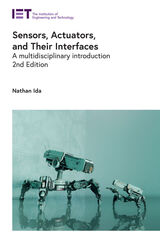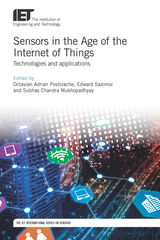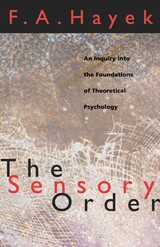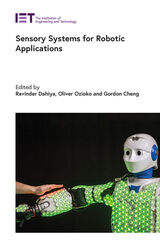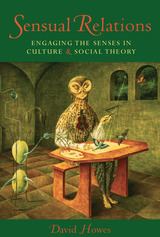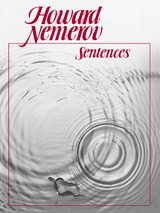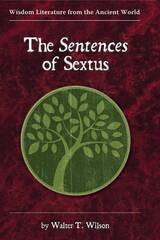 Self-Consciousness and Objectivity: An Introduction to Absolute Idealism
Sebastian Rödl
Harvard University Press, 2018 Self-Consciousness and Objectivity undermines a foundational dogma of contemporary philosophy: that knowledge, in order to be objective, must be knowledge of something that is as it is, independent of being known to be so. Sebastian Rödl revives the thought—as ancient as philosophy but largely forgotten today—that knowledge, precisely on account of being objective, is self-knowledge: knowledge knowing itself. Thus he intervenes in a discussion that runs through the work of Bernard Williams, Thomas Nagel, Adrian Moore, and others, who seek to comprehend the claim to objectivity we raise in making judgments. While these authors think that the quest for objectivity demands that we transcend the first person, Rödl argues that it is through the first-person thought contained in every judgment that our judgments possess the objectivity that defines knowledge.
Self-Consciousness and Objectivity can be read as an introduction to absolute idealism, for it dismantles a stubborn obstacle to absolute idealism’s reception: the notion that it is a species of idealism, which is understood to be the assertion that the world depends upon the mind. As Rödl brings out, absolute idealism is the resolute rejection of that idea.
The implications of this work are profound. It undercuts a number of contemporary presumptions, such as that judgment is a propositional attitude, that inference is a mental process, and that there is an empirical science of the capacity for objective knowledge. All of these presumptions flow from the erroneous notion that the objectivity of knowledge stands opposed to its first-person character.
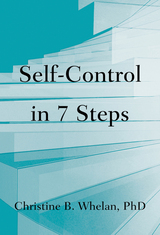 Self-Control in Seven Steps
Christine B. Whelan
Templeton Press, 2012 When you want to get up for an early flight, what do you do? You set an alarm. If you want to benchpress your body weight, how do you start? You slowly build up your muscles so you can achieve your goal. And when you’ve got a big deadline looming, what’s the best way to handle it? Plan out your time. If you’re like most people, you know all these things are true, but at some point or another, you’ve dropped the ball: You’ve missed a flight because you cut it too close, you’ve overestimated what you can physically do, hurting yourself in the process, or you’ve tried to cram in a month’s worth of work into a frantic forty-eight-hour panic fest. Yes? You’re not alone. Even Aristotle knew this when he said, “I count him braver who overcomes his desires than him who conquers his enemies; for the hardest victory is over self.” You want the secret to success. You want to take control of your life and achieve your goals. We all do. Since research has repeatedly shown that self-control is like a muscle, think of this book as your personal trainer to build up your skills and strength. Self-Control in 7 Steps offers the proven mental tricks, organizational strategies, and tools to transform the bored, unfocused, and lazy in all of us.
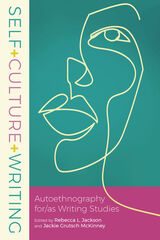 Self+Culture+Writing: Autoethnography for/as Writing Studies
Rebecca Jackson
Utah State University Press, 2021 Literally translated as “self-culture-writing,” autoethnography—as both process and product—holds great promise for scholars and researchers in writings studies who endeavor to describe, understand, analyze, and critique the ways in which selves, cultures, writing, and representation intersect. Self+Culture+Writing foregrounds the possibility of autoethnography as a viable methodological approach and provides researchers and instructors with ways of understanding, crafting, and teaching autoethnography within writing studies.
Interest in autoethnography is growing among writing studies scholars, who see clear connections to well-known disciplinary conversations about personal narrative, as well as to the narrative turn in general and social justice efforts in particular. Contributions by authors from diverse backgrounds and institutional settings are organized into three parts: a section of writing studies autoethnographies, a section on how to teach autoethnography, and a section on how ideas about autoethnography in writing studies are evolving.
Self+Culture+Writing discusses the use of autoethnography in the writing classroom as both a research method and a legitimate way of knowing, providing examples of the genre and theoretical discussions that highlight the usefulness and limitations of these methods.
Contributors: Leslie Akst, Melissa Atienza, Ross Atkinson, Alison Cardinal, Sue Doe, Will Duffy, John Gagnon, Elena Garcia, Guadalupe Garcia, Caleb Gonzalez, Lilly Halboth, Rebecca Hallman Martini, Kirsten Higgins, Shereen Inayatulla, Aliyah Jones, Autumn Laws, Soyeon Lee, Louis M. Maraj, Kira Marshall-McKelvey, Jennifer Owen, Tiffany Rainey, Marcie Sims, Amanda Sladek, Trixie Smith, Anthony Warnke
Self-Deception and Paradoxes of Rationality
Edited by Jean-Pierre Dupuy
CSLI, 1998 Self-deception is one of the topics that lends itself best to the task of exploring the possibilities of cross-fertilization between 'continental philosophy' and 'analytic philosophy'. Fifty years ago, in Being and Nothingness, Sartre defined the core notion of 'Bad Faith' as lying to oneself. On the other side of the Atlantic, self-deception has become one of the most exciting puzzles in the philosophy of mind, and a number of paradoxes encountered by the theory of rational choice involve that very same notion. One of the objectives is to show that bridges can be thrown over the gap between the two traditions, but also that both of them make self-deception too intrapsychic and suffer from a serious individualistic bias. The conference was intended to explore the intersubjective and social dimensions of self-deception.
 Self-Defense: A Myth-Busting Guide to Immune Health
Daniel M. Davis
University of Chicago Press, 2025 “Utterly absorbing. Nearly every paragraph brings a revelation.”—Bill Bryson • “Wise, and beautifully written. . . . It will change the way you think about your body and live your life.”—Chris van Tulleken • “This great book from a world expert offers practical tips and dispels many myths.”—Tim Spector
A world-renowned scientist offers a much-needed analysis of what it takes to have good immune health—helping readers navigate what can really help, what is a complete myth, and why.
Does orange juice help ward off colds? And how does our age affect our ability to recover from one? When it comes to immunity, are we really what we eat? Or how much we eat? We are surrounded by big questions and big claims about enhancing our immune systems, so how do we tell the fiction from the facts? And, ultimately, what can we do to reduce our chances of getting sick?
World-leading immunologist Daniel M. Davis offers answers in this authoritative, highly accessible, myth-busting guide to the effects of stress, age, exercise, weight, nutrition, sleep, vaccines, and mental health on our immune health. Taking us to the cutting edge of immunology research and explaining both what we know and how we know it, Self-Defense helps readers spot phony claims and make informed choices. Davis shows us that everyone’s immune system is entirely unique, and that’s why we should be wary of one-size-fits-all “cures.” We learn how exercise, for example, has all sorts of different, even opposing, short- and long-term effects on our immune health. And while our gut microbes are vitally important, it’s unlikely that yogurt drinks can really boost your immune system to stop you getting ill.
An eye-opening window into some of the astonishing possibilities for the future, when it comes to distinguishing bogus and beneficial health claims about everything from vitamin D to inflammation and cancer therapies, Davis’s book may be your best self-defense.
 Self-Defense: A Myth-Busting Guide to Immune Health
Daniel M. Davis
University of Chicago Press, 2025 This is an audiobook version of this book.
A world-renowned scientist offers a much-needed analysis of what it takes to have good immune health—helping readers navigate what can really help, what is a complete myth, and why.
Does orange juice help ward off colds? And how does our age affect our ability to recover from one? When it comes to immunity, are we really what we eat? Or how much we eat? We are surrounded by big questions and big claims about enhancing our immune systems, so how do we tell the fiction from the facts? And, ultimately, what can we do to reduce our chances of getting sick?
World-leading immunologist Daniel M. Davis offers answers in this authoritative, highly accessible, myth-busting guide to the effects of stress, age, exercise, weight, nutrition, sleep, vaccines, and mental health on our immune health. Taking us to the cutting edge of immunology research and explaining both what we know and how we know it, Self-Defense helps readers spot phony claims and make informed choices. Davis shows us that everyone’s immune system is entirely unique, and that’s why we should be wary of one-size-fits-all “cures.” We learn how exercise, for example, has all sorts of different, even opposing, short- and long-term effects on our immune health. And while our gut microbes are vitally important, it’s unlikely that yogurt drinks can really boost your immune system to stop you getting ill.
An eye-opening window into some of the astonishing possibilities for the future, when it comes to distinguishing bogus and beneficial health claims about everything from vitamin D to inflammation and cancer therapies, Davis’s book may be your best self-defense.
Self-Determination and Women’s Rights in Muslim Societies
Edited by Chitra Raghavan and James P. Levine
Brandeis University Press, 2012 Contradicting the views commonly held by westerners, many Muslim countries in fact engage in a wide spectrum of reform, with the status of women as a central dimension. This anthology counters the myth that Islam and feminism are always or necessarily in opposition. A multidisciplinary group of scholars examine ideology, practice, and reform efforts in the areas of marriage, divorce, abortion, violence against women, inheritance, and female circumcision across the Islamic world, illuminating how religious and cultural prescriptions interact with legal norms, affecting change in sometimes surprising ways.
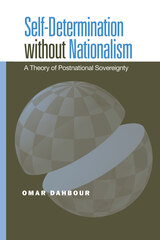 Self-Determination without Nationalism: A Theory of Postnational Sovereignty
Omar Dahbour
Temple University Press, 2014 How do groups—be they religious or ethnic—achieve sovereignty in a postnationalist world? In Self-Determination without Nationalism, noted philosopher Omar Dahbour insists that the existing ethics of international relations, dominated by the rival notions of liberal nationalism and political cosmopolitanism, no longer suffice. Dahbour notes that political communities are an ethically desirable and historically inevitable feature of collective life. The ethical principles that govern them, however—especially self-determination and sovereignty—require reformulation in light of globalization and the economic and environmental challenges of the twenty-first century.
Arguing that nation-states violate the principle of self-determination, Dahbour then develops a detailed new theory of self-determination that he calls "ecosovereignty.” Ecosovereignty defines political community in a way that can protect and further the rights of indigenous peoples as well as the needs of ecological regions for a sustainable form of development and security from environmental destruction.
In the series Global Ethics and Politics, edited by Carol Gould.
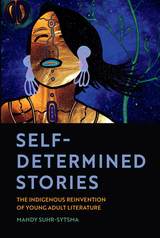 Self-Determined Stories: The Indigenous Reinvention of Young Adult Literature
Mandy Suhr-Sytsma
Michigan State University Press, 2018 The first book of its kind, Self-Determined Stories: The Indigenous Reinvention of Young Adult Literature reads Indigenous-authored YA—from school stories to speculative fiction— not only as a vital challenge to stereotypes but also as a rich intellectual resource for theorizing Indigenous sovereignty in the contemporary era. Building on scholarship from Indigenous studies, children’s literature, and cultural studies, Suhr-Sytsma delves deep in close readings of works by Sherman Alexie, Jeannette Armstrong, Joseph Bruchac, Drew Hayden Taylor, Susan Power, Cynthia Leitich Smith, and Melissa Tantaquidgeon Zobel. Together, Suhr-Sytsma contends, these works constitute a unique Indigenous YA genre. This genre radically revises typical YA conventions while offering a fresh portrayal of Indigenous self-determination and a fresh critique of multiculturalism, heteropatriarchy, and hybridity. This literature, moreover, imagines compelling alternative ways to navigate cultural dynamism, intersectionality, and alliance-formation. Self-Determined Stories invites readers from a range of contexts to engage with Indigenous YA and convincingly demonstrates the centrality of Indigenous stories, Indigenous knowledge, and Indigenous people to the flourishing of everyone in every place.
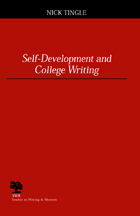 Self-Development and College Writing
Nick Tingle
Southern Illinois University Press, 2004 Nick Tingle investigates the psychoanalytic dimensions of composition instruction in Self-Development and College Writing to boldly illustrate that mastering academic prose requires students to develop psychologically as well as cognitively. Asserting that writing instruction should be an engaging, developmental process for both teachers and students, he urges reaching for new levels of consciousness in the classroom to aid students in realigning their subjective relationships with knowledge and truth. Drawing on psychoanalytic theory and twenty years of experience as a teacher, Tingle outlines the importance of moving beyond usual ways of thinking, abandoning the common sense of everyday reality, and coming to understand beliefs as beliefs and not absolutes. These developmental moves must be accompanied, Tingle says, by a new attitude towards language—not as something that points to things, but as a series of concepts that arrange the very things one points to. And this development is necessary not just in order to perform well in the writing class, but also to fully participate in and reap the academic rewards of structured, university life. Self-Development and College Writing calls attention to the psychological destabilization this method may produce for students. Tingle explains that, if writing instructors are to respond to this destabilization, they must conceive of the classroom as a transitional space, or a kind of holding environment. They must also become aware of their psychological allegiances to particular theories of writing if they are to construct such environments. But the goal of the transitional environment is worth pursuing, Tingle argues, contending that university education fails to address students’ developmental needs. With purposeful writing and deft analyses, Tingle shows that this goal also affords a means by which to place writing courses at the center of the educational curriculum. Conceived as a transitional space, the writing class may support and stabilize students in their developmental passage, thereby fostering an improved understanding of their academic work and, more importantly, an increased intellectual understanding of themselves and the complex world in which they live.
 Self-Development Ethics and Politics in China Today: A Keyword Approach
Gil Hizi
Amsterdam University Press, 2024 This volume takes readers on a journey into a central aspect of life in China, so-called “self-development.” Whether prompted by the cultural values of educational success, capitalist competition for wealth, or the Chinese Communist Party’s prescriptions for “good” citizenship, few people in China are immune to the impetus to “improve” themselves and thus bring about a better future. Contributors to this volume, interdisciplinary sinologists, draw on materials from practices in education, labor, and self-help as they spotlight “keywords” by which individuals make sense of their self-development journeys – including new forms of resistance to social norms. Rather than simply classify self-development by different activities or groups, the chapters map together ethical features that cut across Chinese society. Contributors explore the nuanced and ambivalent attitudes towards self-development of individuals navigating various requirements and pursuing more complete forms of existence. In so doing, they offer a snapshot of China that intersects with timely global concerns.
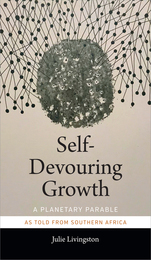 Self-Devouring Growth: A Planetary Parable as Told from Southern Africa
Julie Livingston
Duke University Press, 2019 Under capitalism, economic growth is seen as the key to collective well-being. In Self-Devouring Growth Julie Livingston upends this notion, showing that while consumption-driven growth may seem to benefit a particular locale, it produces a number of unacknowledged, negative consequences that ripple throughout the wider world. Structuring the book as a parable in which the example of Botswana has lessons for the rest of the globe, Livingston shows how fundamental needs for water, food, and transportation become harnessed to what she calls self-devouring growth: an unchecked and unsustainable global pursuit of economic growth that threatens catastrophic environmental destruction. As Livingston notes, improved technology alone cannot stave off such destruction; what is required is a greater accounting of the web of relationships between humans, nonhuman beings, plants, and minerals that growth entails. Livingston contends that by failing to understand these relationships and the consequences of self-devouring growth, we may be unknowingly consuming our future.
Self-Discovery and Authority in Afro-American Narrative
Valerie Smith
Harvard University Press, 1987 In this perceptive exploration of the relationship between autobiography and fiction in African-American writing, Valerie Smith argues that black writers—from the authors of nineteenth-century slave narratives to contemporary novelists—affirm and legitimize their psychological autonomy by telling the stories of their lives. Focusing on autobiographies by Olaudah Equiano, Frederick Douglass, and Harriet Jacobs and on the fiction of James Weldon Johnson, Richard Wright, Ralph Ellison, and Toni Morrison, Smith demonstrates the ways in which the act of narrating constitutes an act of self-fashioning that must be understood in the context of the African-American experience. Hers is a fertile investigation, attuned to the differences in male and female sensibilities, and attentive to the importance of oral traditions.
Self-Evidence: A Selection of Verse, 1977-1997
Pamela White Hadas
Northwestern University Press, 1997 Finalist, 1998 National Book Critics Circle Awards
A Library Journal Best Poetry of 1998 Selection
Pamela White Hadas won enthusiastic recognition for her early books of poetry, Designing Women and Beside Herself. In Self-Evidence, she selects the best of her published work and combines it with poems never before collected. This collection contains legendary, mythic, historical, and imaginary characters--Lilith, Pocahontas, Simone Weil, the wives of Watergate, a circus performer, and others. With playful originality and virtuoso voicing, Hadas weaves breathtaking tapestries of women's loves and labors.
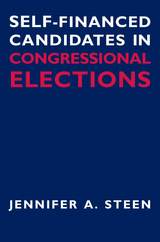 Self-Financed Candidates in Congressional Elections
Jennifer A. Steen
University of Michigan Press, 2006 Are our elections for sale? Americans have long asked this question in the face of skyrocketing campaign spending by candidates and parties. Then, in the 1990s, came a wave of wealthy individuals whose deep pockets seemed to be buying political offices across the country. Our worst suspicions were confirmed. Or were they? What effect do self-financers really have on electoral outcomes? Jennifer Steen's authoritative empirical study of self-financed candidates is a landmark in American politics. Steen thoroughly dispels the notion that self-funded candidates can buy legislative seats, proving that the vast majority of self-financers do not win their elections. Her book gives us a truer understanding of self-financers' actual influence on campaign competition and rhetoric. Jennifer A. Steen is Assistant Professor of Political Science at Boston College and a former political consultant. She is one of the nation's leading authorities on self-financed candidates.
 Self-Financing Genocide: The Gold Train, the Becher Case and the Wealth of Hungarian Jews
Gábor Kádár
Central European University Press, 2004 Discusses the process of the economic annihilation of the Jews in Hungary, who– from the economic point of view – were more influential than any other Jewish community in Europe. Following the German occupation in March 1944 the collaborating Hungarian government attempted to assert its claim concerning the complete confiscation of Jewish assets at all stages of the road leading to the extermination camps. The cooperation with the Germans proved to be the most problematic in this area. The story of the Jewish Gold Train is a relatively small but all the more emblematic chapter of the economic annihilation. The circumstances of the freight’s assembling, the German-Hungarian conflicts concerning the train, the looting attempts, the fate of the assets seized by the Allies (double victimization of the survivors) provide the reader with an insight into the history of the repeated looting of the Hungarian Jewry The book analyzes the role played by SS-Obersturmbannführer Kurt Becher, one of the most controversial and mysterious figures in the Hungarian and universal history of the Holocaust. Becher, delegated to Hungary by Himmler, administered and benefited from the confiscation of an enormous amount of Jewish assets.
Self-Healing Materials: From fundamental concepts to advanced space and electronics applications
Brahim Aïssa
The Institution of Engineering and Technology, 2019 Self-healing materials are an emerging class of smart materials that are capable of repairing themselves from damage, either spontaneously or under a stimulus such as light, heat, or the application of a solvent. Intended for an audience of researchers in academia and industry, this book addresses a wide range of self-healing materials and processes, with emphasis on their performance in the space environment.
 Self-Help Books: Why Americans Keep Reading Them
Sandra K. Dolby
University of Illinois Press, 2004 Understanding instead of lamenting the popularity of self-help books Based on a reading of more than three hundred self-help books, Sandra K. Dolby examines this remarkably popular genre to define "self-help" in a way that's compelling to academics and lay readers alike. Self-Help Books also offers an interpretation of why these books are so popular, arguing that they continue the well-established American penchant for self-education, they articulate problems of daily life and their supposed solutions, and that they present their content in a form and style that is accessible rather than arcane. Using tools associated with folklore studies, Dolby then examines how the genre makes use of stories, aphorisms, and a worldview that is at once traditional and contemporary. The overarching premise of the study is that self-help books, much like fairy tales, take traditional materials, especially stories and ideas, and recast them into extended essays that people happily read, think about, try to apply, and then set aside when a new embodiment of the genre comes along.
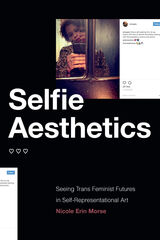 Selfie Aesthetics: Seeing Trans Feminist Futures in Self-Representational Art
Nicole Erin Morse
Duke University Press, 2022 In Selfie Aesthetics Nicole Erin Morse examines how trans feminine artists use selfies and self-representational art to explore transition, selfhood, and relationality. Morse contends that rather than being understood as shallow emblems of a narcissistic age, selfies can produce politically meaningful encounters between creators and viewers. Through close readings of selfies and other digital artworks by trans feminist artists, Morse details a set of formal strategies they call selfie aesthetics: doubling, improvisation, seriality, and nonlinear temporality. Morse traces these strategies in the work of Zackary Drucker, Vivek Shraya, Tourmaline, Alok Vaid-Menon, Zinnia Jones, and Natalie Wynn, showing how these artists present improvisational identities and new modes of performative resistance by conveying the materialities of trans life. Morse shows how the interaction between selfie creators and viewers constructs collective modes of being and belonging in ways that envision trans feminist futures. By demonstrating the aesthetic depth and political potential of selfie creation, distribution, and reception, Morse deepens understandings of gender performativity and trans experience.
 Self-Interest and Universal Health Care: Why Well-Insured Americans Should Support Coverage for Everyone
Larry R. Churchill
Harvard University Press, 1994 “I’m covered—why should I foot the bill for somebody who isn’t?”
This question, unspoken but simmering at the center of the debate over universal health care coverage, comes in for a thoughtful hearing—and, perhaps, gentle corrective—in Larry Churchill’s timely book. Churchill, whose Rationing Health Care in America put the nation’s health care crisis into perspective, here does the same for our crisis of conscience over health care coverage. As Clinton and Congress spar over the financing and organization of a national health system, the true debate, this book reveals, is about moral and political values, about the meaning and ethics of health care reform.
Churchill begins by cutting through the confused discussion about rationing health care. Concerns about rationing, with all the moral and political questions they raise, deflect our attention from a more important issue, which this book brings into focus. Arguing that care is already rationed by ability to pay, Churchill suggests that the proper question is not whether to ration but how to do so fairly, and that answering requires a clear sense of the aims of a health care system. In pursuit of this necessary understanding, Churchill explores values and concepts such as security and solidarity, self-interest and social affinity, rights and responsibilities. Drawing on philosophical ideas of justice and individual responsibility, rendered here with remarkable clarity, he shows that universal care is morally as well as economically comprehensible and that a truly inclusive health care system should be seen as a common civic purpose rather than as a supply of services to be consumed. Accessible, deeply felt, and cogently argued, this book should revise the terms of the national debate over health care reform.
Selfishness, Altruism, and Rationality
Howard Margolis
University of Chicago Press, 1984 Why do we volunteer time? Why do we contribute money? Why, even, do we vote, if the effect of a single vote is negligible? Rationality-based microeconomic models are hard-pressed to explain such social behavior, but Howard Margolis proposes a solution. He suggests that within each person there are two selves, one selfish and the other group-oriented, and that the individual follows a Darwinian rule for allocating resources between those two selves.
"Howard Margolis's intriguing ideas . . . provide an alternative to the crude models of rational choice that have dominated economics and political science for too long."—Times Literary Supplement
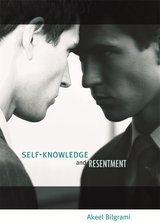 Self-Knowledge and Resentment
Akeel Bilgrami
Harvard University Press, 2012 In Self-Knowledge and Resentment, Akeel Bilgrami argues that self-knowledge of our intentional states is special among all the knowledges we have because it is not an epistemological notion in the standard sense of that term, but instead is a fallout of the radically normative nature of thought and agency.
Four themes or questions are brought together into an integrated philosophical position: What makes self-knowledge different from other forms of knowledge? What makes for freedom and agency in a deterministic universe? What makes intentional states of a subject irreducible to its physical and functional states? And what makes values irreducible to the states of nature as the natural sciences study them? This integration of themes into a single and systematic picture of thought, value, agency, and self-knowledge is essential to the book's aspiration and argument. Once this integrated position is fully in place, the book closes with a postscript on how one might fruitfully view the kind of self-knowledge that is pursued in psychoanalysis.
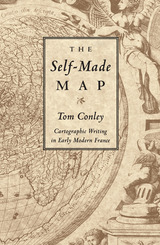 The Self-Made Map: Cartographic Writing in Early Modern France
Tom Conley
University of Minnesota Press, 2011 The Self-Made Map argues that during the Renaissance in France a "new cartographic impulse" affected both the "graphic and imaginary forms of literature." In this wide-ranging and fascinating work, Tom Conley demonstrates that as new maps were plotted during this period, a new sense of self emerged, one defined in part by the relationship of the self to space.
Conley traces the explosion of interest in mapmaking that occurred with the discovery of the New World, and discusses the commensurate rise of what he defines as cartographic writing-writing that "holds, penetrates, delineates, and explores space." Considering the works of such writers as Rabelais, Montaigne, and Descartes, Conley provides a "navigation" through the printed page, revealing the emerging values of Renaissance France. In his examination of the placing of words, letters, and graphic elements in books, he exposes the playful and sometimes enigmatic relation between spatial organization and text.
Conley also exposes the ideological exercise inherent in mapmaking, arguing that Renaissance cartography is inseparably bound up with the politics of the era. He undertakes close readings of maps and illustrations, discussing the necessity of viewing Renaissance maps in the context of their typographic layout, graphic reproduction, and literary and ideological import.
Richly illustrated throughout, The Self-Made Map combines studies of art, geography, history, literature, and printing to show a clear historical transformation, along the way linking geographical discoveries, printing processes, and political awareness. Conley's provocative analysis discloses how early modern printed literature and cartography worked together to crystallize broader issues engaging the then emergent status of cultural identity, nation, and individuality.
 Self-Made Men: Identity and Embodiment among Transsexual Men
Henry Rubin
Vanderbilt University Press, 2003 In Self-Made Men, Henry Rubin explores the production of male identities in the lives of twenty-two FTM transsexuals--people who have changed their sex from female to male. The author relates the compelling personal narratives of his subjects to the historical emergence of FTM as an identity category. In the interviews that form the heart of the book, the FTMs speak about their struggles to define themselves and their diverse experiences, from the pressures of gender conformity in adolescence to being mistaken for "butch lesbians," from hormone treatments and surgeries to relationships with families, partners, and acquaintances. Their stories of feeling betrayed by their bodies and of undergoing a "second puberty" are vivid and thought-provoking. Throughout the interviews, the subjects' claims to having "core male identities" are remarkably consistent and thus challenge anti-essentialist assumptions in current theories of gender, embodiment, and identity. Rubin uses two key methods to analyze and interpret his findings. Adapting Foucault's notions of genealogy, he highlights the social construction of gender categories and identities. His account of the history of endocrinology and medical technologies for transforming bodies demonstrates that the "family resemblance" between transsexuals and intersexuals was a necessary postulate for medical intervention into the lives of the emerging FTMs. The book also explores the historical emergence of the category of FTM transsexual as distinguished from the category of lesbian woman and the resultant "border disputes" over identity between the two groups. Rubin complements this approach with phenomenological concepts that stress the importance of lived experience and the individual's capacity for knowledge and action. An important contribution to several fields, including sociology of the body, gender and masculinity, human development, and the history of science, Self-Made Me will be of interest to anyone who has seriously pondered what it means to be a man and how men become men.
Self-Made Woman: A Memoir
Denise Chanterelle DuBois
University of Wisconsin Press, 2017 Denise Chanterelle DuBois's transformation into a woman wasn't easy. Born as a boy into a working-class Polish American Milwaukee family, she faced daunting hurdles: a domineering father, a gritty 1960s neighborhood with no understanding of gender nonconformity, trouble in school, and a childhood so haunted by deprivation that neckbone soup was a staple. Terrified of revealing her inner self, DuBois lurched through alcoholism, drug dealing and addiction, car crashes, dangerous sex, and prison time. Dennis barreled from Wisconsin to California, Oregon, Canada, Costa Rica, New York, Bangkok, and Hawaii on a joyless ride.
Defying all expectations, DuBois didn't crash and burn. Embracing her identity as a woman, she remade herself. Writing with resolute honesty and humor, she confronts both her past and her present to tell an American story of self-discovery.
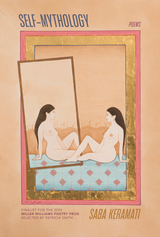 Self-Mythology: Poems
Saba Keramati
University of Arkansas Press, 2024 Winner, 2025 Nossrat Yassini Poetry Prize In the search for a true home, what does it mean to be confronted instead by an insurmountable sense of otherness? This question dwells at the center of Saba Keramati’s Self-Mythology, which explores multiraciality and the legacy of exile alongside the poet’s uniquely American origin as the only child of political refugees from China and Iran. Keramati navigates her ancestral past while asking what language and poetry can offer to those who exist on the margins of contemporary society. Constantly scanning her world for some likeness that would help her feel less of an outsider, the poet writes, “You could cut me in half. Send the left side with my mother, / right with my father. Shape what’s missing out of clay // from their lands and still I would not belong.” Blending the personal and the political, Self-Mythology considers the futurity of diaspora in America while revealing its possibilities.
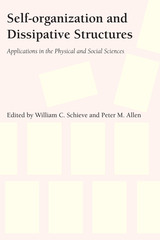 Self-Organization and Dissipative Structures: Applications in the Physical and Social Sciences
Edited by William C. Schieve and Peter M. Allen
University of Texas Press, 1982 The contributions to this volume attempt to apply different aspects of Ilya Prigogine's Nobel-prize-winning work on dissipative structures to nonchemical systems as a way of linking the natural and social sciences. They address both the mathematical methods for description of pattern and form as they evolve in biological systems and the mechanisms of the evolution of social systems, containing many variables responding to subjective, qualitative stimuli. The mathematical modeling of human systems, especially those far from thermodynamic equilibrium, must involve both chance and determinism, aspects both quantitative and qualitative. Such systems (and the physical states of matter which they resemble) are referred to as self-organized or dissipative structures in order to emphasize their dependence on the flows of matter and energy to and from their surroundings. Some such systems evolve along lines of inevitable change, but there occur instances of choice, or bifurcation, when chance is an important factor in the qualitative modification of structure. Such systems suggest that evolution is not a system moving toward equilibrium but instead is one which most aptly evokes the patterns of the living world. The volume is truly interdisciplinary and should appeal to researchers in both the physical and social sciences. Based on a workshop on dissipative structures held in 1978 at the University of Texas, contributors include Prigogine, A. G. Wilson, Andre de Palma, D. Kahn, J. L. Deneubourgh, J. W. Stucki, Richard N. Adams, and Erick Jantsch. The papers presented include Allen, "Self-Organization in the Urban System"; Robert Herman, "Remarks on Traffic Flow Theories and the Characterization of Traffic in Cities"; W. H. Zurek and Schieve, "Nucleation Paradigm: Survival Threshold in Population Dynamics"; De Palma et al., "Boolean Equations with Temporal Delays"; Nicholas Georgescu-Roegin, "Energy Analysis and Technology Assessment"; Magoroh Maruyama, "Four Different Causal Meta-types in Biological and Social Sciences"; and Jantsch, "From Self-Reference to Self-Transcendence: The Evolution of Self-Organization Dynamics."
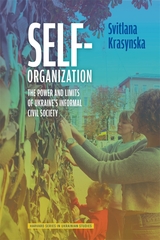 Self-Organization: The Power and Limits of Ukraine's Informal Civil Society
Svitlana Krasynska
Harvard University Press Using Ukraine as a case-in-point, Svitlana Krasynska engages diverse bodies of literature and rich empirical data to reveal the vital role and unique potential of below-the-radar civic engagement in contexts where informal practices abound—a phenomenon largely neglected by scholars of civil society who traditionally focus on formal civic organizations.
Civil society in Eastern Europe has long been labeled weak based on a general lack of citizen participation in formal civil society organizations—a key criterion for assessing civic engagement in comparative studies. However, such assessment of civil society fails to recognize the role and impact of informal civic engagement in contexts where informality permeates economic, political, and social spheres. Ukraine offers a valuable counterargument of the importance of informal civil society in Eastern Europe, especially in the post-Soviet countries.
Krasynska convincingly shows that informality constitutes an essential component of civil society, shaping popular approaches to addressing social, economic, and political issues. The trailblazing findings in Self-Organization will be of interest to scholars of democratization, informality, and area studies, and they will aid development practitioners and policy makers in determining a more effective approach to helping fledgling democracies around the world.
Self-Organizing Dynamic Agents for the Operation of Decentralized Smart Grids
Alfredo Vaccaro
The Institution of Engineering and Technology, 2024 Integrating intermittent distributed generation, distributed storage systems, electric vehicles, and flexible loads will present security, stability, and power quality challenges in future smart grids. The amount of data to be processed to face these issues can overwhelm grid operation tools and conventional IT-based applications, limiting situational awareness and decision support. Decentralized and self-organizing technologies can help with that problem. In a self-organizing system, information processing is based on local interactions of its elementary parts (dynamic agents), enabling the cooperative solution of complex decision-making problems by only requiring local information exchange without needing a fusion center for data collection and processing.
Self/Pity
Susan Hahn
Northwestern University Press, 2005 Drawing on history, myth, folk rhymes, human physiology, and the psyche's crevices, Susan Hahn's Self/Pity is a relentless journey of the self through time, into the labyrinth of the present with its own stimuli and despairs. She strikes a delicate balance of contrast and collision between the various linked poems in this collection, which all deal with birth, the body, and the soul.
As with her previous collections, the poems in Self/Pity can be read as a cohesive whole.
From the simple prayer "To Jacob Four Months In The Womb" to the complex territory of the poem sequence "The Pornography of Pity," in which Mother Goose, the Marquis de Sade, Godot, Lewis Carroll's Alice, The Cat and the Fiddle, Zeus, and many others are called upon, Hahn creates a tour-de-force exploration of the book's central themes.
Self-Portrait in a Door-Length Mirror: Poems
Stephen Gibson
University of Arkansas Press, 2017 Winner of the 2017 Miller Williams Poetry Prize, edited by Billy Collins “Shows this exceptional poet at his rhyming best.” —Billy Collins Self-Portrait in a Door-Length Mirror presents the mirror that reflects not always what is, but what is desired, or not desired. In the opening poem, the speaker, Diane Arbus, looks at her very early pregnant self and asks, “Why would I bring you into this world?” This book answers that question, or tries to: the world is what it is as we try to live as our best selves in that world. But that knowledge of the world is hard and has consequences, and not in the abstract, as Gibson’s poetry dynamically shows. Employing new formalism, Self-Portrait in a Door-Length Mirror examines historical, familial, and personal pasts as those pasts continue into the present, reminding us, as Faulkner wrote, “The past is never dead. It’s not even past.”
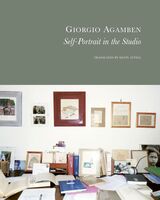 Self-Portrait in the Studio
Giorgio Agamben
Seagull Books, 2024 A rare autobiographical glimpse into the life and influences of one of Europe's greatest living philosophers.
This book’s title, Self-Portrait in the Studio—a familiar iconographic subject in the history of painting—is intended to be taken literally: the book is a self-portrait, but one that comes into view for the reader only by way of patient scrutiny of the images, photographs, objects, and paintings present in the studios where the writer has worked and still works. That is to say, Giorgio Agamben’s wager is to speak of himself solely and uniquely by speaking of others: the poets, philosophers, painters, musicians, friends, passions—in short, the meetings and encounters that have shaped his life, thought, and writing, from Martin Heidegger to Elsa Morante, from Herman Melville to Walter Benjamin, from Giorgio Caproni to Giovanni Urbani. For this reason, images are an integral part of the book, images that—like those in a rebus that together form another, larger image—ultimately combine with the written text in one of the most unusual self-portraits that any writer has left of himself: not an autobiography, but a faithful and timeless auto-heterography.
Self-Portrait in Words: Collected Writings and Statements, 1903-1950
Max Beckmann
University of Chicago Press, 1997 One of the most important German artists of the twentieth century, Max Beckmann is known for the depth and sensuous force of his works, but little is known about his personal life. Self-Portrait in Words reveals Beckmann's experience of life from the first years of his career in Berlin and Paris through his final years in the United States. This collection of Beckmann's writings serves as a companion to his art and a testament to the complexities of his life.
"Barbara Copeland Buenger . . . has done an excellent job of editing and annotating Beckmann's voluminous private and public writings."—Andrea Barnet, New York Times Book Review
Self-Reference
Thomas Bolander, Vincent F. Hendricks, and Stig Andur Pedersen
CSLI, 2006 An anthology of previously unpublished essays from some of the most outstanding scholars working in philosophy, mathematics, and computer science today, Self-Reference reexamines the latest theories of self-reference, including those that attempt to explain and resolve the semantic and set-theoretic paradoxes. With a thorough introduction that contextualizes the subject for students, this book will be important reading for anyone interested in the general area of self-reference and philosophy.
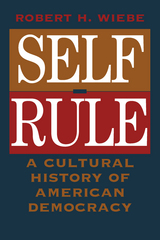 Self-Rule: A Cultural History of American Democracy
Robert H. Wiebe
University of Chicago Press, 1995 Something profoundly important occurred in early 19th century America that came to be called democracy. Since then hundreds of millions of people worldwide have operated on the assumption that democracy exists. Yet definitions of democracy are surprisingly vague and remarkably few reckon with its history. In Self-Rule, Robert Wiebe suggests that only in appreciating that history can we recognize how breathtaking democracy's arrival was, how extraordinary its spread has been, and how uncertain its prospects are.
American democracy arrived abruptly in the 19th century; it changed just as dramatically early in the 20th. Hence, Self-Rule divides the history of American democracy into two halves: a 19th century half covering the 1820s to the present, and a 20th century half, with a major transition from the 1890s to the 1920s between them. As Wiebe explains why the original democracy of the early 19th century represented a sharp break from the past, he recreates in vivid detail the way European visitors contrasted the radical character of American democracy with their own societies. He then discusses the operation of various 19th century democratic publics, including a nationwide public, the People. Finally, he places democracy's white fraternal world of equals in a larger environment where other Americans who differed by class, race, and gender, developed their own relations to democracy.
Wiebe then picks up the history of democracy in the 1920s and carries it to the present. Individualism, once integrated with collective self-governance in the 19th century, becomes the driving force behind 20th century democracy. During those same years, other ways of defining good government and sound public policy shunt majoritarian practices to one side. Late in the 20th century, these two great themes in the history of American democracy—individualism and majoritarianism—turn on one another in modern democracy's war on itself.
Finally, Self-Rule assesses the polarized state of contemporary American democracy. Putting the judgments of sixty-odd commentators from Kevin Phillips and E.J. Dionne to Robert Bellah and Benjamin Barber to the test of history, Wiebe offers his own suggestions on the meaning and direction of today's democracy. This sweeping work explains how the history of American democracy has brought us here and how that same history invites us to create a different future.
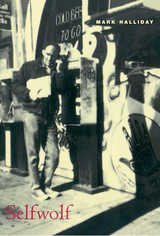 Selfwolf
Mark Halliday
University of Chicago Press, 1998 In his third book of poems, Mark Halliday grapples with the endless struggle between self-concern and awareness of the rights of others. Through humor, ironic twists, and refreshing candor, these poems confront a variety of situations—death, divorce, artistic egotism and envy, personal relationships—where the very idea of self is under siege.
"If Selfwolf were a pop music CD, it would be hailed as Mark Halliday's breakthrough album. . . . This third collection of poems teems with unsparing confessions of misdirected lust, lost faith, regret and a winningly goofy cheerfulness in the face of all that bad stuff. . . . The informal, conversational quality of Halliday's work almost hides its artfulness, which seems to be precisely his intention."—Ken Tucker, New York Times Book Review
"With unflinching, often comic honesty about how 'ego-fetid, hostile, grasping' we are, Halliday exposes the self's wolfish hungers and weaknesses."—Andrew Epstein, Boston Review
"Mark Halliday's new book offers more of his trademark riffs on self-consciousness. His subversive, surprising, hugely enjoyable poems will make you laugh out loud, squirm in uncomfortable recognition, and appreciate anew the comedy of our daily battles for self-preservation. . . reading Halliday is pure delight. . . . I love the daring and intelligence with which Halliday skates along the shifting boundary between self within and world outside. Selfwolf slows down our habitual negotiations between 'in here' and 'out there,' exposing the edgy comedy of how we survive."—Damaris Moore, Express Books
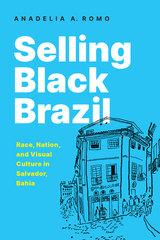 Selling Black Brazil: Race, Nation, and Visual Culture in Salvador, Bahia
Anadelia Romo
University of Texas Press, 2022 2023 Honorable Mention, Brazil Section Humanities Book Prize, Latin American Studies Association (LASA)
This book explores visual portrayals of blackness in Brazil to reveal the integral role of visual culture in crafting race and nation across Latin America.
In the early twentieth century, Brazil shifted from a nation intent on whitening its population to one billing itself as a racial democracy. Anadelia Romo shows that this shift centered in Salvador, Bahia, where throughout the 1950s, modernist artists and intellectuals forged critical alliances with Afro-Brazilian religious communities of Candomblé to promote their culture and their city. These efforts combined with a growing promotion of tourism to transform what had been one of the busiest slaving depots in the Americas into a popular tourist enclave celebrated for its rich Afro-Brazilian culture. Vibrant illustrations and texts by the likes of Jorge Amado, Pierre Verger, and others contributed to a distinctive iconography of the city, with Afro-Bahians at its center. But these optimistic visions of inclusion, Romo reveals, concealed deep racial inequalities. Illustrating how these visual archetypes laid the foundation for Salvador’s modern racial landscape, this book unveils the ways ethnic and racial populations have been both included and excluded not only in Brazil but in Latin America as a whole.
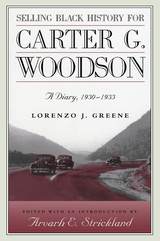 Selling Black History for Carter G. Woodson: A Diary, 1930-1933
Lorenzo J. Greene, Edited & Intro by Arvarh E. Strickland
University of Missouri Press, 1996 In the summer of 1930, Lorenzo Johnston Greene, a graduate of Howard University and a doctoral candidate at Columbia University, became a book agent for the man with the undisputed title of "Father of Negro History," Carter G. Woodson. With little more than determination, Greene, along with four Howard University students, traveled throughout the South and Southeast selling books published by Woodson's Associated Publishers. Their dual purpose was to provide needed funds for the Association for the Study of Negro Life and History and to promote the study of African American history. Greene returned east by way of Chicago, and, for a time, he settled in Philadelphia, selling books there and in the nearby cities of Delaware and New Jersey. He left Philadelphia in 1931 to conduct a survey in Washington, D.C., of firms employing and not employing black workers. From 1930 until 1933, when Greene began teaching at Lincoln University in Jefferson City, Missouri, Selling Black History for Carter G. Woodson provides a unique firsthand account of conditions in African American communities during the Great Depression. Greene describes in the diary, often in lyrical terms, the places and people he visited. He provides poignant descriptions of what was happening to black professional and business people, plus working-class people, along with details of high school facilities, churches, black business enterprises, housing, and general conditions in communities. Greene also gives revealing accounts of how the black colleges were faring in 1930. Selling Black History for Carter G. Woodson offers important glimpses into the private thoughts of a young man of the 1930s, a developing intellectual and scholar. Greene's diary also provides invaluable insights into the personality of Carter Woodson that are not otherwise available. This fascinating and comprehensive view of black America during the early thirties will be a welcome addition to African American studies.
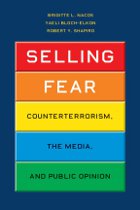 Selling Fear: Counterterrorism, the Media, and Public Opinion
Brigitte L. Nacos, Yaeli Bloch-Elkon, Robert Y. Shapiro
University of Chicago Press, 2011 While we’ve long known that the strategies of terrorism rely heavily on media coverage of attacks, Selling Fear is the first detailed look at the role played by media in counterterrorism—and the ways that, in the wake of 9/11, the Bush administration manipulated coverage to maintain a climate of fear.
Drawing on in-depth analysis of counterterrorism in the years after 9/11—including the issuance of terror alerts and the decision to invade Iraq—the authors present a compelling case that the Bush administration hyped fear, while obscuring civil liberties abuses and concrete issues of preparedness. The media, meanwhile, largely abdicated its watchdog role, choosing to amplify the administration’s message while downplaying issues that might have called the administration’s statements and strategies into question. The book extends through Hurricane Katrina, and the more skeptical coverage that followed, then the first year of the Obama administration, when an increasingly partisan political environment presented the media, and the public, with new problems of reporting and interpretation.
Selling Fear is a hard-hitting analysis of the intertwined failures of government and media—and their costs to our nation.
Selling Free Enterprise: The Business Assault on Labor and Liberalism, 1945-60
Elizabeth A. Fones-Wolf
University of Illinois Press, 1994 The post-World War II years in the United States were marked by the business community's efforts to discredit New Deal liberalism and undermine the power and legitimacy of organized labor. In Selling Free Enterprise, Elizabeth Fones-Wolf describes how conservative business leaders strove to reorient workers away from their loyalties to organized labor and government, teaching that prosperity could be achieved through reliance on individual initiative, increased productivity, and the protection of personal liberty. Based on research in a wide variety of business and labor sources, this detailed account shows how business permeated every aspect of American life, including factories, schools, churches, and community institutions.
Selling Hope: State Lotteries in America
Charles Clotfelter and Philip J. Cook
Harvard University Press, 1989 With its huge jackpots and heartwarming rags-to-riches stories, the lottery has become the hope and dream of millions of Americans—and the fastest-growing source of state revenue. Despite its popularity, however, there remains much controversy over whether this is an appropriate business for state government and, if so, how this business should be conducted.
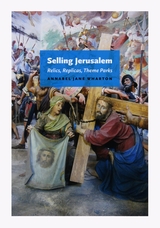 Selling Jerusalem: Relics, Replicas, Theme Parks
Annabel Jane Wharton
University of Chicago Press, 2006 Jerusalem currently stands at the center of a violent controversy that threatens the stability of both the Middle East and the world. This volatility, observes Annabel Jane Wharton, is only the most recent manifestation of a centuries-old obsession with the control of the Holy City—military occupation and pilgrimage being two familiar forms of “ownership.” Wharton makes the innovative argument here that the West has also sought to possess Jerusalem by acquiring its representations.
From relics of the True Cross and Templar replicas of the Holy Sepulchre to Franciscan recreations of the Passion to nineteenth-century mass-produced prints and contemporary theme parks, Wharton describes the evolving forms by which the city has been possessed in the West. She also maps those changing embodiments of the Holy City against shifts in the western market. From the gift-and-barter economy of the early Middle Ages to contemporary globalization, both money and the representations of Jerusalem have become progressively incorporeal, abstract, illusionistic, and virtual.
Selling Jerusalem offers a penetrating introduction to the explosive combination of piety and capital at work in religious objects and global politics. It is sure to interest students and scholars of art history, economic history, popular culture, religion, and architecture, as well as those who want to better understand Jerusalem’s problematic place in history.
 Selling Modernity: Advertising in Twentieth-Century Germany
Pamela E. Swett, S. Jonathan Wiesen, and Jonathan R. Zatlin, eds.
Duke University Press, 2007 The sheer intensity and violence of Germany’s twentieth century—through the end of an empire, two world wars, two democracies, and two dictatorships—provide a unique opportunity to assess the power and endurance of commercial imagery in the most extreme circumstances. Selling Modernity places advertising and advertisements in this tumultuous historical setting, exploring such themes as the relationship between advertising and propaganda in Nazi Germany, the influence of the United States on German advertising, the use of advertising to promote mass consumption in West Germany, and the ideological uses and eventual prohibition of advertising in East Germany. While the essays are informed by the burgeoning literature on consumer society, Selling Modernity focuses on the actors who had the greatest stake in successful merchandising: company managers, advertising executives, copywriters, graphic artists, market researchers, and salespeople, all of whom helped shape the depiction of a company’s products, reputation, and visions of modern life. The contributors consider topics ranging from critiques of capitalism triggered by the growth of advertising in the 1890s to the racial politics of Coca-Cola’s marketing strategies during the Nazi era, and from the post-1945 career of an erotica entrepreneur to a federal anti-drug campaign in West Germany. Whether analyzing the growing fascination with racialized discourse reflected in early-twentieth-century professional advertising journals or the postwar efforts of Lufthansa to lure holiday and business travelers back to a country associated with mass murder, the contributors reveal advertising’s central role in debates about German culture, business, politics, and society. Contributors. Shelley Baranowski, Greg Castillo, Victoria de Grazia, Guillaume de Syon, Holm Friebe, Rainer Gries, Elizabeth Heineman, Michael Imort, Anne Kaminsky, Kevin Repp , Corey Ross, Jeff Schutts, Robert P. Stephens, Pamela E. Swett, S. Jonathan Wiesen, Jonathan R. Zatlin
SELLING OF THE SOUTH: The Southern Crusade for Industrial Development, 1936-90
James C. Cobb
University of Illinois Press, 1993 From the Great Depression to the Sunbelt Era the South has pursued industrial development as the remedy for its economic ills. The mixed results of this ongoing crusade are chronicled in this path-breaking study, updated to 1990, in which James Cobb examines the expectations, achievements, and side effects of the dive for southern industrialization.
Selling Outer Space: Kennedy, the Media, and Funding for Project Apollo, 1961-1963
James Kauffman
University of Alabama Press, 2009 Examines how the Kennedy administration and the media constructed the space program in ways designed to win congressional and public approval
Examines the Kennedy administration’s rhetorical campaign to persuade Congress and the public to adopt a manned flight to the moon. In so doing, the study addresses three key themes.
First, it illuminates the contrasting nature of technical and narrative arguments and explores how those arguments play different roles in public discussion of social policy. Second, the book examines how both the executive branch and the news media function to help set the agenda in American politics. Offering a case study of the increasingly complex relationship between the government and the media.
Finally, Selling Outer Space explores the power of technology to shape and direct human action.
 Selling Paris: Property and Commercial Culture in the Fin-de-siècle Capital
Alexia M. Yates
Harvard University Press, 2015 In 1871 Paris was a city in crisis. Besieged during the Franco-Prussian War, its buildings and boulevards were damaged, its finances mired in debt, and its new government untested. But if Parisian authorities balked at the challenges facing them, entrepreneurs and businessmen did not. Selling Paris chronicles the people, practices, and politics that spurred the largest building boom of the nineteenth century, turning city-making into big business in the French capital.
Alexia Yates traces the emergence of a commercial Parisian housing market, as private property owners, architects, speculative developers, and credit-lending institutions combined to finance, build, and sell apartments and buildings. Real estate agents and their innovative advertising strategies fed these new residential spaces into a burgeoning marketplace. Corporations built empires with tens of thousands of apartments under management for the benefit of shareholders. By the end of the nineteenth century, the Parisian housing market caught the attention of the wider public as newspapers began reporting its ups and downs.
The forces that underwrote Paris’s creation as the quintessentially modern metropolis were not only state-centered or state-directed but also grew out of the uncoordinated efforts of private actors and networks. Revealing the ways housing and property became commodities during a crucial period of urbanization, Selling Paris is an urban history of business and a business history of a city that transforms our understanding of both.
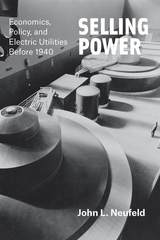 Selling Power: Economics, Policy, and Electric Utilities Before 1940
John L. Neufeld
University of Chicago Press, 2016 We remember Thomas Edison as the inventor of the incandescent light bulb, but he deserves credit for something much larger, an even more singular invention that profoundly changed the way the world works: the modern electric utility industry. Edison’s light bulb was the first to work within a system where a utility generated electricity and distributed it to customers for lighting. The story of how electric utilities went within one generation from prototype to an indispensable part of most Americans’ lives is a story about the relationships between political and technological change.
John L. Neufeld offers a comprehensive historical treatment of the economics that shaped electric utilities. Compared with most industries, the organization of the electric utility industry is not—and cannot be—economically efficient. Most industries are kept by law in a state of fair competition, but the capital necessary to start an electric company—generators, transmission and distribution systems, and land and buildings—is so substantial that few companies can enter the market and compete. Therefore, the natural state of the electric utility industry since its inception has been a monopoly subject to government oversight. These characteristics of electric utilities—and electricity’s importance—have created over time sharp political controversies, and changing public policies have dramatically changed the industry’s structure to an extent matched by few other industries. Neufeld outlines the struggles that shaped the industry’s development, and shows how the experience of electric utilities provides insight into the design of economic institutions, including today’s new large-scale markets.
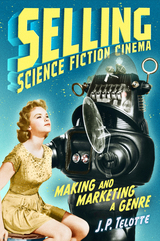 Selling Science Fiction Cinema: Making and Marketing a Genre
J. P. Telotte
University of Texas Press, 2023 How science fiction films in the 1950s were marketed and helped create the broader genre itself.
For Hollywood, the golden age of science fiction was also an age of anxiety. Amid rising competition, fluid audience habits, and increasing government regulation, studios of the 1950s struggled to make and sell the kinds of films that once were surefire winners. These conditions, the leading media scholar J. P. Telotte argues, catalyzed the incredible rise of science fiction. Though science fiction films had existed since the earliest days of cinema, the SF genre as a whole continued to resist easy definition through the 1950s. In grappling with this developing genre, the industry began to consider new marketing approaches that viewed films as fluid texts and audiences as ever-changing. Drawing on trade reports, film reviews, pressbooks, trailers, and other archival materials, Selling Science Fiction Cinema reconstructs studio efforts to market a promising new genre and, in the process, shows how salesmanship influenced what that genre would become. Telotte uses such films as The Thing from Another World, Forbidden Planet, and The Blob, as well as the influx of Japanese monster movies, to explore the shifting ways in which the industry reframed the SF genre to market to no-longer static audience expectations. Science fiction transformed the way Hollywood does business, just as Hollywood transformed the meaning of science fiction.
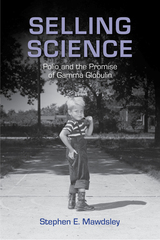 Selling Science: Polio and the Promise of Gamma Globulin
Mawdsley, Stephen E
Rutgers University Press, 2016 Today, when many parents seem reluctant to have their children vaccinated, even with long proven medications, the Salk vaccine trial, which enrolled millions of healthy children to test an unproven medical intervention, seems nothing short of astonishing. In Selling Science, medical historian Stephen E. Mawdsley recounts the untold story of the first large clinical trial to control polio using healthy children—55,000 healthy children—revealing how this long-forgotten incident cleared the path for Salk’s later trial. Mawdsley describes how, in the early 1950s, Dr. William Hammon and the National Foundation for Infantile Paralysis launched a pioneering medical experiment on a previously untried scale. Conducted on over 55,000 healthy children in Texas, Utah, Iowa, and Nebraska, this landmark study assessed the safety and effectiveness of a blood component, gamma globulin, to prevent paralytic polio. The value of the proposed experiment was questioned by many prominent health professionals as it harbored potential health risks, but as Mawdsley points out, compromise and coercion moved it forward. And though the trial returned dubious results, it was presented to the public as a triumph and used to justify a federally sanctioned mass immunization study on thousands of families between 1953 and 1954. Indeed, the concept, conduct, and outcome of the GG study were sold to health professionals, medical researchers, and the public at each stage. At a time when most Americans trusted scientists, their mutual encounter under the auspices of conquering disease was shaped by politics, marketing, and at times, deception.
Drawing on oral history interviews, medical journals, newspapers, meeting minutes, and private institutional records, Selling Science sheds light on the ethics of scientific conduct, and on the power of marketing to shape public opinion about medical experimentation.
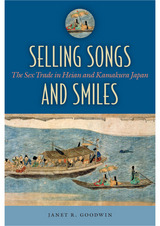 Selling Songs and Smiles: The Sex Trade in Heian and Kamakura Japan
Janet R. Goodwin
University of Hawaii Press, 2007 Selling Songs and Smiles explores female sexual entertainment ("songs and smiles") during Japan’s Heian and Kamakura periods, examining the gradual construction of a transgressive identity ("prostitute") for women engaged in the sex trade. Over some four hundred years, the character and public image of sexual entertainment was shaped by growing restrictions on female sexual activity and increasingly negative views of the female body—themselves the result of socioeconomic change in society at large. Although it is possible to paint a picture of the general decline in the status of women in the sex trade, there were also ambiguities in how they were regarded by society in the very oldest extant references to them in historical sources. Using essays, diaries, legal documents, stories, and illustrated works, this original and distinctive study unravels social attitudes toward female sexual entertainers and examines changes in their trade and the treatment they received at the hands of the court, the bakufu, and religious institutions.
Compellingly argued and stylishly written, Selling Songs and Smiles challenges several prevailing interpretations, most notably the organic connection posed by scholars between shamans and sexual entertainers. Based on her exhaustive research into multiple types of primary sources, Janet Goodwin views women involved in the sex trade neither as entirely social marginals nor artisans situated within normal societal bounds. What emerges from her study is the complex and often contradictory nature of the Heian and Kamakura discourse on sexual entertainment.
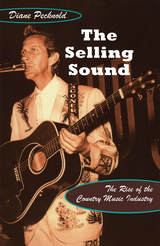 The Selling Sound: The Rise of the Country Music Industry
Diane Pecknold
Duke University Press, 2007 Few expressions of popular culture have been shaped as profoundly by the relationship between commercialism and authenticity as country music has. While its apparent realism, sincerity, and frank depictions of everyday life are country’s most obvious stylistic hallmarks, Diane Pecknold demonstrates that commercialism has been just as powerful a cultural narrative in its development. Listeners have long been deeply invested in the “business side” of country. When fans complained in the mid-1950s about elite control of the mass media, or when they expressed their gratitude that the Country Music Hall of Fame served as a physical symbol of the industry’s power, they engaged directly with the commercial apparatus surrounding country music, not with particular songs or stars. In The Selling Sound, Pecknold explores how country music’s commercialism, widely acknowledged but largely unexamined, has affected the way it is produced, the way it is received by fans and critics, and the way it is valued within the American cultural hierarchy. Pecknold draws on sources as diverse as radio advertising journals, fan magazines, Hollywood films, and interviews with industry insiders. Her sweeping social history encompasses the genre’s early days as an adjunct of radio advertising in the 1920s, the friction between Billboard and more genre-oriented trade papers over generating the rankings that shaped radio play lists, the establishment of the Country Music Association, and the influence of rock ‘n’ roll on the trend toward single-genre radio stations. Tracing the rise of a large and influential network of country fan clubs, Pecknold highlights the significant promotional responsibilities assumed by club organizers until the early 1970s, when many of their tasks were taken over by professional publicists.
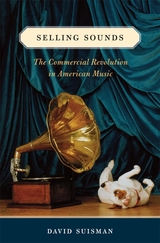 Selling Sounds: The Commercial Revolution in American Music
David Suisman
Harvard University Press, 2009 From Tin Pan Alley to grand opera, player-pianos to phonograph records, David Suisman’s Selling Sounds explores the rise of music as big business and the creation of a radically new musical culture. Around the turn of the twentieth century, music entrepreneurs laid the foundation for today’s vast industry, with new products, technologies, and commercial strategies to incorporate music into the daily rhythm of modern life. Popular songs filled the air with a new kind of musical pleasure, phonographs brought opera into the parlor, and celebrity performers like Enrico Caruso captivated the imagination of consumers from coast to coast.
Selling Sounds uncovers the origins of the culture industry in music and chronicles how music ignited an auditory explosion that penetrated all aspects of society. It maps the growth of the music business across the social landscape—in homes, theaters, department stores, schools—and analyzes the effect of this development on everything from copyright law to the sensory environment. While music came to resemble other consumer goods, its distinct properties as sound ensured that its commercial growth and social impact would remain unique.
Today, the music that surrounds us—from iPods to ring tones to Muzak—accompanies us everywhere from airports to grocery stores. The roots of this modern culture lie in the business of popular song, player-pianos, and phonographs of a century ago. Provocative, original, and lucidly written, Selling Sounds reveals the commercial architecture of America’s musical life.
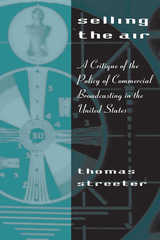 Selling the Air: A Critique of the Policy of Commercial Broadcasting in the United States
Thomas Streeter
University of Chicago Press, 1996 In this interdisciplinary study of the laws and policies associated with commercial radio and television, Thomas Streeter reverses the usual take on broadcasting and markets by showing that government regulation creates rather than intervenes in the market. Analyzing the processes by which commercial media are organized, Streeter asks how it is possible to take the practice of broadcasting—the reproduction of disembodied sounds and pictures for dissemination to vast unseen audiences—and constitute it as something that can be bought, owned, and sold.
With an impressive command of broadcast history, as well as critical and cultural studies of the media, Streeter shows that liberal marketplace principles—ideas of individuality, property, public interest, and markets—have come into contradiction with themselves. Commercial broadcasting is dependent on government privileges, and Streeter provides a searching critique of the political choices of corporate liberalism that shape our landscape of cultural property and electronic intangibles.
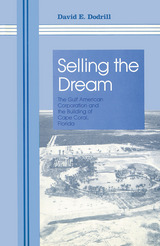 Selling The Dream: The Gulf American Corporation and the Building of Cape Coral, Florida
David Dodrill
University of Alabama Press, 1993 Gulf American Corporation’s heavy influence on the migration of people to Florida
The Gulf American Corporation played a significant role in the development and urbanization of the state of Florida, especially southwest Florida, during the late 1950s and 1960s. The Miami-based company promoted living in Florida to people residing throughout North America and in several foreign countries. It also enabled people of average incomes to purchase home sites in Florida on an installment basis. As a result, Gulf American had a heavy influence on the migration of people to Florida as early as 1957.
Leonard and Julius J. Rosen of Baltimore, Maryland, founded and controlled the corporation during its 12-year existence from 1957 to 1969. The sale and promotion of Florida real estate was an extension of their marketing style developed in previous years when they sold mail-order cosmetics and other products. Their innovative sales strategies ultimately resulted in conflicts with state and federal regulatory agencies in the mid 1960s over the firm’s aggressive sales methods. The struggle with the state of Florida over regulation, which degenerated into a personal conflict between Governor Claude Kirk and the Rosens, resulted in the Rosens’ selling the business to GAC Corporation of Allentown, Pennsylvania, in 1969. After a series of business setbacks and continuing accusations of misrepresentations by salespeople, GAC declared bankruptcy in 1975 and was eventually resurrected as Avatar Holding, Inc., in 1980.
Gulf American left a mixed legacy to the state of Florida by building several growing cities like Cape Coral and Golden Gate, while at the same time selling worthless underwater swampland near the Everglades. The building of their first development was planned by the company. In that sense, Cape Coral was designed to be the Rosens’ most elaborate sales tool.
Based on 31 personal interviews with former Gulf American Corporation, GAC/Avatar Holding company officials and supplemented by articles from 25 different newspapers, this book provides a comprehensive and fascinating look at the Gulf American Corporation—the largest land sales firm in the United States in the 1960s. In many ways the story of Gulf American is a rags-to-riches tale of Leonard and Julius (Jack) Rosen, complete with intrigue and the fluctuations of fortune that matched the rising tides that covered much of the land they sold.
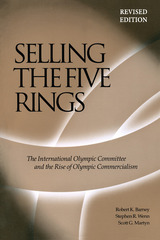 Selling The Five Rings: The IOC and the Rise of the Olympic Commercialism
Robert K Barney
University of Utah Press, 2004 The original scheme for the modern Olympic Games was hatched at an international sports conference at the Sorbonne in June 1894. At the time, few provisions were made for the financial underwriting of the project—providence and the beneficence of host cities would somehow take care of the costs. For much of the first century of modern Olympic history, this was the case, until the advent of television and corporate sponsorship transformed that idealism. Now, linking with the five-ring logo is good business. Advertising during the Olympic Games guarantees a global audience unmatched in size by any other sports audience in the world. However, if the image begins to tarnish and the corporate sector loses interest, television companies can’t sell advertising to business interests. This was the greatest threat posed by the scandal surrounding Salt Lake City’s bid. Selling the Five Rings outlines the rise of the Olympic movement from an envisioned instrument of peace and brotherhood, to a transnational commercial giant of imposing power and influence. Using primary source documents such as minutes of the IOC General Sessions, minutes and reports of various IOC sub-committees and commissions concerned with finance, reports of key marketing agencies, and the letters and memoranda written to and by the major figures in Olympic history, the authors track the history of a fascinating global institution.
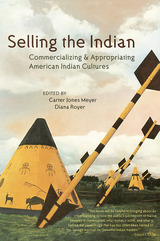 Selling the Indian: Commercializing and Appropriating American Indian Cultures
Carter Jones Meyer
University of Arizona Press, 2001 For more than a hundred years, outsiders enamored of the perceived strengths of American Indian cultures have appropriated and distorted elements of them for their own purposes—more often than not ignoring the impact of the process on the Indians themselves. This book contains eight original contributions that consider the selling of American Indian culture and how it affects the Native community. It goes beyond studies of “white shamanism” to focus on commercial ventures, challenging readers to reconsider how Indian cultures have been commercialized in the twentieth century. Some selections examine how Indians have been displayed to the public, beginning with a “living exhibit” of Cocopa Indians at the 1904 Louisiana Purchase Exposition and extending to contemporary stagings of Indian culture for tourists at Tillicum Village near Seattle. Other chapters range from the Cherokees to Puebloan peoples to Indians of Chiapas, Mexico, in an examination of the roles of both Indians and non-Indian reformers in marketing Native arts and crafts. These articles show that the commercialization and appropriation of American Indian cultures have been persistent practices of American society over the last century and constitute a form of cultural imperialism that could contribute to the destruction of American Indian culture and identity. They offer a means toward understanding this complex process and provide a new window on Indian-white interactions. CONTENTS Part I: Staging the Indian
1. The “Shy” Cocopa Go to the Fair, Nancy J. Parezo and John W. Troutman
2. Command Performances: Staging Native Americans at Tillicum Village, Katie N. Johnson and Tamara Underiner
3. Savage Desires: The Gendered Construction of the American Indian in Popular Media, S. Elizabeth Bird
4. “Beyond Feathers and Beads”: Interlocking Narratives in the Music and Dance of Tokeya Inajin (Kevin Locke), Pauline Tuttle Part II: Marketing the Indian
5. “The Idea of Help”: White Women Reformers and the Commercialization of Native American Women’s Arts, Erik Trump
6. Saving the Pueblos: Commercialism and Indian Reform in the 1920s, Carter Jones Meyer
7. Marketing Traditions: Cherokee Basketry and Tourist Economies, Sarah H. Hill
8. Crafts, Tourism, and Traditional Life in Chiapas, Mexico: A Tale Related by a Pillowcase, Chris Goertzen
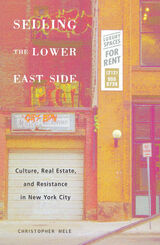 Selling The Lower East: Culture, Real Estate, and Resistance in New York City
Christopher Mele
University of Minnesota Press, 2000 Tracks the shifting views of the Lower East Side from ghetto to desirable urban niche. The Lower East Side of Manhattan is rich in stories-of poor immigrants who flocked there in the late nineteenth and early twentieth centuries; of beatniks, hippies, and artists who peopled it mid-century; and of the real estate developers and politicians who have always shaped what is now termed the "East Village." Today, the musical Rent plays on Broadway to a mostly white and suburban audience, MTV exploits the neighborhood’s newly trendy squalor in a film promotion, and on the Internet a cyber soap opera and travel-related Web pages lure members of the middle class to enjoy a commodified and sanitized version of the neighborhood. In this sweeping account, Christopher Mele analyzes the political and cultural forces that have influenced the development of this distinctive community. He describes late nineteenth-century notions of the Lower East Side as a place of entrenched poverty, ethnic plurality, political activism, and "low" culture that elicited feelings of revulsion and fear among the city’s elite and middle classes. The resulting-and ongoing-struggle between government and residents over affordable and decent housing has in turn affected real estate practices and urban development policies. Selling the Lower East Side recounts the resistance tactics used by community residents, as well as the impulse on the part of some to perpetuate the image of the neighborhood as dangerous, romantic, and bohemian, clinging to the marginality that has been central to the identity of the East Village and subverting attempts to portray it as "new and improved." Ironically, this very image of urban grittiness has been appropriated by a cultural marketplace hungry for new fodder. Mele explores the ways that developers, media executives, and others have coopted the area’s characteristics-analyzing the East Village as a "style provider" where what is being marketed is "difference." The result is a visionary look at how political and economic actions transform neighborhoods and at what happens when a neighborhood is what is being "consumed."A comprehensive web site for Selling the Lower East Side can be found at www.upress.umn.edu/sles.
Selling the Race: Culture, Community, and Black Chicago, 1940-1955
Adam Green
University of Chicago Press, 2006 In Selling the Race, Adam Green tells the story of how black Chicagoans were at the center of a national movement in the 1940s and ’50s, a time when African Americans across the country first started to see themselves as part of a single culture. Along the way, he offers fascinating reinterpretations of such events as the 1940 American Negro Exposition, the rise of black music and the culture industry that emerged around it, the development of the Associated Negro Press and the founding of Johnson Publishing, and the outcry over the 1955 lynching of Emmett Till. By presenting African Americans as agents, rather than casualties, of modernity, Green ultimately reenvisions urban existence in a way that will resonate with anyone interested in race, culture, or the life of cities.
 Selling the Silver Bullet: The Lone Ranger and Transmedia Brand Licensing
By Avi Santo
University of Texas Press, 2015 Originating as a radio series in 1933, the Lone Ranger is a cross-media star who has appeared in comic strips, comic books, adult and juvenile novels, feature films and serials, clothing, games, toys, home furnishings, and many other consumer products. In his prime, he rivaled Mickey Mouse as one of the most successfully licensed and merchandised children’s properties in the United States, while in more recent decades, the Lone Ranger has struggled to resonate with consumers, leading to efforts to rebrand the property. The Lone Ranger’s eighty-year history as a lifestyle brand thus offers a perfect case study of how the fields of licensing, merchandizing, and brand management have operated within shifting industrial and sociohistorical conditions that continue to redefine how the business of entertainment functions. Deciphering how iconic characters gain and retain their status as cultural commodities, Selling the Silver Bullet focuses on the work done by peripheral consumer product and licensing divisions in selectively extending the characters’ reach and in cultivating investment in these characters among potential stakeholders. Tracing the Lone Ranger’s decades-long career as intellectual property allows Avi Santo to analyze the mechanisms that drive contemporary character licensing and entertainment brand management practices, while at the same time situating the licensing field’s development within particular sociohistorical and industrial contexts. He also offers a nuanced assessment of the ways that character licensing firms and consumer product divisions have responded to changing cultural and economic conditions over the past eighty years, which will alter perceptions about the creative and managerial authority these ancillary units wield.
 Selling the Story: Transaction and Narrative Value in Balzac, Dostoevsky, and Zola
Jonathan Paine
Harvard University Press, 2019 A literary scholar and investment banker applies economic criticism to canonical novels, dramatically changing the way we read these classics and proposing a new model for how economics can inform literary analysis.
Every writer is a player in the marketplace for literature. Jonathan Paine locates the economics ingrained within the stories themselves, revealing how a text provides a record of its author’s attempt to sell the story to his or her readers.
An unusual literary scholar with a background in finance, Paine mines stories for evidence of the conditions of their production. Through his wholly original reading, Balzac’s The Splendors and Miseries of Courtesans becomes a secret diary of its author’s struggles to cope with the commercializing influence of serial publication in newspapers. The Brothers Karamazov transforms into a story of Dostoevsky’s sequential bets with his readers, present and future, about how to write a novel. Zola’s Money documents the rise of big business and is itself a product of Zola’s own big business, his factory of novels.
Combining close readings with detailed analyses of the nineteenth-century publishing contexts in which prose fiction first became a product, Selling the Story shows how the business of literature affects even literary devices such as genre, plot, and repetition. Paine argues that no book can be properly understood without reference to its point of sale: the author’s knowledge of the market, of reader expectations, and of his or her own efforts to define and achieve literary value.
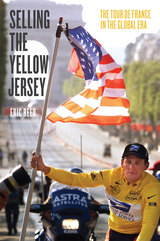 Selling the Yellow Jersey: The Tour de France in the Global Era
Eric Reed
University of Chicago Press, 2014 Yellow Livestrong wristbands were taken off across America in early 2013 when Lance Armstrong confessed to Oprah Winfrey that he had doped during the seven Tour de France races he won. But the foreign cycling world, which always viewed Armstrong with suspicion, had already moved on. The bellwether events of the year were Chris Froome’s victory in the Tour and the ousting of Pat McQuaid as director of the Union Cycliste Internationale. Even without Armstrong, the Tour will roll on— its gigantic entourage includes more than 200 racers, 450 journalists, 260 cameramen, 2,400 support vehicles carrying 4,500 people, and a seven-mile-long publicity caravan. It remains one of the most-watched annual sporting events on television and a global commercial juggernaut.
In Selling the Yellow Jersey, Eric Reed examines the Tour’s development in France as well as the event’s global athletic, cultural, and commercial influences. The race is the crown jewel of French cycling, and at first the newspapers that owned the Tour were loath to open up their monopoly on coverage to state-owned television. However, the opportunity for huge payoffs prevailed, and France tapped into global networks of spectatorship, media, business, athletes, and exchanges of expertise and personnel. In the process, the Tour helped endow world cycling with a particularly French character, culture, and structure, while providing proof that globalization was not merely a form of Americanization, imposed on a victimized world. Selling the Yellow Jersey explores the behind-the-scenes growth of the Tour, while simultaneously chronicling France’s role as a dynamic force in the global arena.
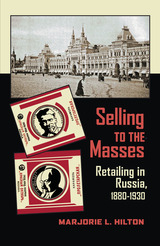 Selling to the Masses: Retailing in Russia, 1880–1930
Marjorie L. Hilton
University of Pittsburgh Press, 2012
Marjorie L. Hilton presents a captivating history of consumer culture in Russia from the 1880s to the early 1930s. She highlights the critical role of consumerism as a vehicle for shaping class and gender identities, modernity, urbanism, and as a mechanism of state power in the transition from tsarist autocracy to Soviet socialism.
Beginning in the late nineteenth century, Russia witnessed a rise in mass production, consumer goods, advertising, and new retail venues such as arcades and department stores. These mirrored similar developments in other European countries and reflected a growing quest for leisure activities, luxuries, and a modern lifestyle. As Hilton reveals, retail commerce played a major role in developing Russian public culture—it affected celebrations of religious holidays, engaged diverse groups of individuals, defined behaviors and rituals of city life, inspired new interpretations of masculinity and femininity, and became a visible symbol of state influence and provision.
Through monarchies, revolution, civil war, and monumental changes in the political sphere, Russia’s distinctive culture of consumption was contested and recreated. Leaders of all stripes continued to look to the “commerce of exchange” as a key element in appealing to the masses, garnering political support, and promoting a modern nation.
Hilton follows the evolution of retailing and retailers alike, from crude outdoor stalls to elite establishments; through the competition of private versus state-run stores during the NEP; and finally to a system of total state control, indifferent workers, rationing, and shortages under a consolidating Stalinist state.
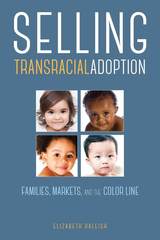 Selling Transracial Adoption: Families, Markets, and the Color Line
Elizabeth Raleigh
Temple University Press, 2017 While focused on serving children and families, the adoption industry must also generate sufficient revenue to cover an agency’s operating costs. With its fee-for-service model, Elizabeth Raleigh asks, How does private adoption operate as a marketplace? Her eye-opening book, Selling Transracial Adoption, provides a fine-grained analysis of the business decisions in the adoption industry and what it teaches us about notions of kinship and race. Adoption providers, Raleigh declares, are often tasked with pitching the idea of transracial adoption to their mostly white clientele. But not all children are equally “desirable,” and transracial adoption—a market calculation—is hardly colorblind. Selling Transracial Adoption explicitly focuses on adoption providers andemploys candid interviews with adoption workers, social workers, attorneys, and counselors, as well as observations from adoption conferences and information sessions, toillustrate how agencies institute a racial hierarchy—especially when the supply of young and healthy infants is on the decline. Ultimately, Raleigh discovers that the racialized practices in private adoption serve as a powerful reflection of race in America.
Selling War: The Role of the Mass Media in Hostile Conflicts from World War I to the "War on Terror"
Edited by Josef Seethaler, Matthias Karmasin, Gabriele Melischek, and Romy Wöhlert
Intellect Books, 2013 This book is the first collection of essays to explore the changing relationships between war, media, and the public from a multidisciplinary perspective and over an extended historical period. It is also the first textbook for students in this field, discussing a wide range of theoretical concepts and methodological tools for analyzing the nature of these relationships. Shedding new light on conflicts spanning from World War I through the so-called War on Terror, the contributors explore the roles of traditional media, war blogs, and eyewitness reporting; of war correspondents and embedded journalism; and of propaganda, wartime public relations, and information warfare.
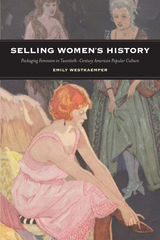 Selling Women's History: Packaging Feminism in Twentieth-Century American Popular Culture
Westkaemper, Emily
Rutgers University Press, 2017 Only in recent decades has the American academic profession taken women’s history seriously. But the very concept of women’s history has a much longer past, one that’s intimately entwined with the development of American advertising and consumer culture. Selling Women’s History reveals how, from the 1900s to the 1970s, popular culture helped teach Americans about the accomplishments of their foremothers, promoting an awareness of women’s wide-ranging capabilities. On one hand, Emily Westkaemper examines how this was a marketing ploy, as Madison Avenue co-opted women’s history to sell everything from Betsy Ross Red lipstick to Virginia Slims cigarettes. But she also shows how pioneering adwomen and female historians used consumer culture to publicize histories that were ignored elsewhere. Their feminist work challenged sexist assumptions about women’s subordinate roles. Assessing a dazzling array of media, including soap operas, advertisements, films, magazines, calendars, and greeting cards, Selling Women’s History offers a new perspective on how early- and mid-twentieth-century women saw themselves. Rather than presuming a drought of female agency between the first and second waves of American feminism, it reveals the subtle messages about women’s empowerment that flooded the marketplace.
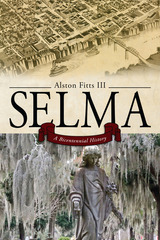 Selma: A Bicentennial History
Alston Fitts III
University of Alabama Press, 2017 In 1989, Alston Fitts published a brief history of the city of Selma, Alabama, from its founding through the aftermath of the civil rights movement. Selma: A Bicentennial History is a greatly revised and expanded version of Fitts’s history of the city, replete with a wealth of new, never-before-published illustrations, which further develops a number of significant events, corrects critical errors, and, most importantly, incorporates many new stories and materials that document Selma’s establishment, growth, and development.
Comprehensive, thoroughly researched, and nonpartisan, Fitts’s pleasantly accessible history addresses every major issue, movement, and trend from the city’s settlement in 1815 to the end of the twentieth century. Its commerce, institutions, governance, as well as its evolving racial, religious, and class composition are all treated with candor and depth. Selma’s transformative role within the state and the nation is fully explored, and most notable is a nuanced and complex discussion of race relations from the rise of the civil rights era to modern times.
Historians, scholars, and Alabamians will find great use for this updated and fully developed exploration of Selma’s rich, complex, and significant history.
 Selma and the Liuzzo Murder Trials: The First Modern Civil Rights Convictions
James P. Turner
University of Michigan Press, 2018 In 1965 the drive for black voting rights in the south culminated in the epic Selma to Montgomery Freedom March. After brutal state police beatings stunned the nation on “Bloody Sunday,” troops under federal court order lined the route as the march finally made its way to the State Capitol and a triumphant address by Dr. Martin Luther King, Jr. But within hours klan terror struck, claiming the life of one of the marchers, Viola Liuzzo, a Detroit mother of five. Turner offers an insider’s view of the three trials that took place over the following nine months—which finally resulted in the conviction of the killers. Despite eyewitness testimony by an FBI informant who was riding in the car with the killers, two all-white state juries refused to convict. It took a team of Civil Rights Division lawyers, led by the legendary John Doar, to produce the landmark jury verdict that klansmen were no longer above the law. This is must reading today, as the voting rights won in Selma come under renewed attack. Explore several court documents, including court transcripts, exhibits, and memoranda on Fulcrum.org.
Selma, Lord, Selma: Girlhood Memories of the Civil Rights Days
Sheyann Webb
University of Alabama Press, 1997 Sheyann Webb was eight years old and Rachel West was nine when Dr. Martin Luther King Jr. arrived in Selma, Alabama, on January 2, 1965. He came to organize non-violent demonstrations against discriminatory voting laws. Selma, Lord, Selma is their firsthand account of the events from that turbulent winter of 1965--events that changed not only the lives of these two little girls but the lives of all Alabamians and all Americans. From 1975 to 1979, award-winning journalist Frank Sikora conducted interviews with Webb and West, weaving their recollections into this luminous story of fear and courage, struggle and redemption that readers will discover is Selma, Lord, Selma.
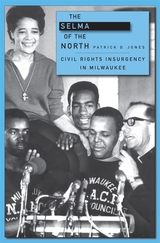 The Selma of the North: Civil Rights Insurgency in Milwaukee
Patrick D. Jones
Harvard University Press, 2010 Between 1958 and 1970, a distinctive movement for racial justice emerged from unique circumstances in Milwaukee. A series of local leaders inspired growing numbers of people to participate in campaigns against employment and housing discrimination, segregated public schools, the membership of public officials in discriminatory organizations, welfare cuts, and police brutality.
The Milwaukee movement culminated in the dramatic—and sometimes violent—1967 open housing campaign. A white Catholic priest, James Groppi, led the NAACP Youth Council and Commandos in a militant struggle that lasted for 200 consecutive nights and provoked the ire of thousands of white residents. After working-class mobs attacked demonstrators, some called Milwaukee “the Selma of the North.” Others believed the housing campaign represented the last stand for a nonviolent, interracial, church-based movement.
Patrick Jones tells a powerful and dramatic story that is important for its insights into civil rights history: the debate over nonviolence and armed self-defense, the meaning of Black Power, the relationship between local and national movements, and the dynamic between southern and northern activism. Jones offers a valuable contribution to movement history in the urban North that also adds a vital piece to the national story.
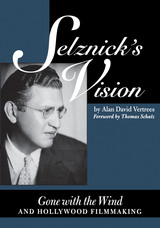 Selznick's Vision: Gone with the Wind and Hollywood Filmmaking
By Alan David Vertrees
University of Texas Press, 1997 Gone with the Wind has generated interest in every aspect of its production. Yet one crucial aspect has never been fully understood or appreciated—the vital shaping role played by executive producer David O. Selznick. In this book, Alan David Vertrees challenges the popular image of Selznick as a megalomaniacal meddler whose hiring and firing of directors and screenwriters created a patchwork film that succeeded despite his interference. Drawing on ten years of research in the Selznick archives, and examining the screenplay's successive drafts, dramatic continuity designs and "storyboard" sketches (many of which are reproduced here), and production correspondence and memoranda, Vertrees interprets the producer's actions as manipulation, not indecision, establishing Selznick's "vision" as the guiding intelligence behind the film's success. In his drive to create a cinematic monument, Selznick also reformed many key facets of studio filmmaking, inventing jobs such as "production designer" (inaugurated by William Cameron Menzies), which persist today. This book thus adds an important chapter to the story of classical Hollywood cinema and the making of the film that has been lauded variously as the "Sistine Chapel of movies" and the "single most beloved entertainment ever produced."
Semantic and Conceptual Development: An Ontological Perspective
Frank C. Keil
Harvard University Press, 1979 In Semantic and Conceptual Development, Frank Keil presents the firstpsychological investigation of thedeveloping child's ontological knowledge. Building on previous philosophical work, Keil shows that ontologicalcategories develop in a highly predictable progression. Moreover, Keil demonstrates that ontological development obeys a strong formal constrainton the relations among categories.Although there are many possibleontological systems, children appearto be inherently targeted to consider asystem of only one sort.
Keil's results represent exactly the sortof interdisciplinary study of thehuman mind which is graduallyemerging as the new field of cognitivescience. We are proud to publish hiswork as the first book in the CognitiveScience Series, which is designed tofoster major empirical and theoreticalcontributions to this new field.
The Semantic Conception of Theories and Scientific Realism
Frederick Suppe
University of Illinois Press, 1989 "An authoritative account of
the semantic conception of theories by one of its chief developers. Suppe has
always seen the semantic conception as providing a way of moving beyond empiricist
philosophies of science. This book provides the definitive account of his views
not only on the issue of realism, but also on a variety of other issues central
to the philosophy of science."
-- Ronald N. Giere, author of Explaining Science: A Cognitive Approach
Semantic Properties of Diagrams and Their Cognitive Potentials
Atsushi Shimojima
CSLI, 2015 Why are diagrams sometimes so useful, facilitating our understanding and thinking, while at other times they can be unhelpful and even misleading? Drawing on a comprehensive survey of modern research in philosophy, logic, artificial intelligence, cognitive psychology, and graphic design, Semantic Properties of Diagrams and Their Cognitive Potentials reveals the systematic reasons for this dichotomy, showing that the cognitive functions of diagrams are rooted in the characteristic ways they carry information. In analyzing the logical mechanisms behind the relative efficacy of diagrammatic representation, Atsushi Shimojima provides deep insight into the crucial question: What makes a diagram a diagram?
Semantics for Descriptions
François Rastier, Marc Cavazza, and Anne Abeillé
CSLI, 2001 In our multimedia age, text description presents many conceptual problems: texts, as cultural objects, cannot be interpreted without descriptions of genre, communicative conditions, and language, which positivist approaches have proved unable to provide. Semantics for Descriptions addresses itself as much to linguists as to computer scientists, arguing that rational hermeneutics can offer better descriptive methods by allowing the theoretical and practical conditions of text interpretation to be defined.
 The Semantics of Analogy: Rereading Cajetan's De Nominum Analogia
Joshua P. Hochschild
University of Notre Dame Press, 2010
The Semantics of Analogy is the first book-length interpretive study in English of Thomas de Vio Cajetan's (1469?-1534) classic treatise on analogy. Written in 1498, De Nominum Analogia (On the Analogy of Names) has long been treated as Cajetan's attempt to systematize Aquinas's theory of analogy. A traditional interpretation regarded it as the official Thomistic treatise on analogy, but current scholarly consensus holds that Cajetan misinterpreted Aquinas and misunderstood the phenomenon of analogy.
Both approaches, argues Joshua P. Hochschild, ignore the philosophical and historical context and fail to accurately assess Cajetan's work. In The Semantics of Analogy, Hochschild reinterprets De Nominum Analogia as a significant philosophical treatise in its own right. He addresses some of the most well-known criticisms of Cajetan's analogy theory and explicates the later chapters of De Nominum Analogia, which are usually ignored by commentators. He demonstrates that Cajetan was aware of the limits of semantic analysis, had a sophisticated view of the relationship between semantics and metaphysics, and expressed perceptive insights about concept formation and hermeneutics that are of continuing philosophical relevance.
"Cajetan's universally scorned doctrine on analogy of proportionality has for some time been ripe for rehabilitation. Given recent philosophical and scholarly work on the semantics of analogy, it is no accident that only now could a philosopher be found who is up to the task. Joshua Hochschild is certainly that. The Semantics of Analogywill make the Thomist and Scotist alike rethink his or her position on analogy, and Hochschild's sustained argument will challenge all to take seriously the way classical semantics deals with ambiguity. It is a masterful book." --David B. Twetten, Marquette University
"A reassessment of Cajetan's work on analogy is long overdue. As Joshua Hochschild shows, Cajetan's admirable and lucid little treatise on the topic deserves to be understood in its own right. Hochschild presents it to us convincingly as a treatise in which Cajetan focuses on a properly semantic question regarding the need for some common ratio in syllogistic reasoning (if such reasoning is to be saved from fallacies of equivocation)." --Philip L. Reynolds, Candler School of Theology, Emory University
"Cajetan's work on analogyis 'the' classic, systematic account of this logico-linguistic phenomenon and its far-reaching metaphysical and epistemological implications. While historians of philosophy, especially Thomists, tended to evaluate Cajetan's theory in terms of its faithfulness to Aquinas' intentions, Hochschild's work engages it from a systematic philosophical perspective, showing its relevance to contemporary theorizing about the subject, despite its historical and conceptual distance from contemporary research in the field. While always treating Cajetan's work in its proper historical context, Hochschild's down-to-earth philosophical style effortlessly closes the conceptual gap between Cajetan and us, breathing new life into Cajetan's difficult, rarefied philosophical prose." --Gyula Klima, Fordham University
The Semantics of Incorporation: From Argument Structure to Discourse Transparency
Donka F. Farkas and Henriëtte de Swart
CSLI, 2003 Distinguishing between discourse referents and thematic arguments, the analysis of incorporation proposed by Donka Farkas and Henriettë de Swart accounts for the relationship between morphological and semantic number, the contrasts between incorporated singulars and incorporated plurals, and various "shades" of discourse transparency. The framework of Discourse Representation Theory used is a theory well-suited for connecting sentence-level and discourse-level semantics.
The analysis presented in this book has important consequences for a cross-linguistic theory of anaphora. Linguists and logicians interested in discourse structure, cross-linguistic semantics, and the relationship between morpho-syntax and meaning will find this an engaging and innovative work.
 The Semantics of Syntax: A Minimalist Approach to Grammar
Denis Bouchard
University of Chicago Press, 1995 During the last thirty years, most linguists and philosophers have assumed that meaning can be represented symbolically and that the mental processing of language involves the manipulation of symbols. Scholars have assembled strong evidence that there must be linguistic representations at several abstract levels—phonological, syntactic, and semantic—and that those representations are related by a describable system of rules. Because meaning is so complex, linguists often posit an equally complex relationship between semantic and other levels of grammar.
The Semantics of Syntax is an elegant and powerful analysis of the relationship between syntax and semantics. Noting that meaning is underdetermined by form even in simple cases, Denis Bouchard argues that it is impossible to build knowledge of the world into grammar and still have a describable grammar. He thus proposes simple semantic representations and simple rules to relate linguistic levels. Focusing on a class of French verbs, Bouchard shows how multiple senses can be accounted for by the assumption of a single abstract core meaning along with background information about how objects behave in the world. He demonstrates that this move simplifies the syntax at no cost to the descriptive power of the semantics. In two important final chapters, he examines the consequences of his approach for standard syntactic theories.
The Semantics/Pragmatics Distinction
Edited by Claudia Bianchi
CSLI, 2005 The contributors to this volume tend to agree on one thing: semantic theory cannot retain its traditional purity, free of pragmatic contextual considerations. This claim provides the setting for various provocative approaches to a precise definition of pragmatics and its reconciliation with semantics—a collection of leading-edge work examining the semantics/pragmatics dispute in terms of a broad range of phenomena, showing how these issues reach from linguistics into a number of other fields, and examining the role of pragmatics in different forms of cross-cultural communication.
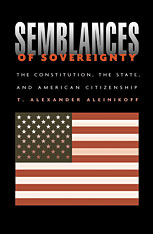 Semblances of Sovereignty: The Constitution, the State, and American Citizenship
T. Alexander Aleinikoff
Harvard University Press, 2002 In a set of cases decided at the end of the nineteenth century, the Supreme Court declared that Congress had "plenary power" to regulate immigration, Indian tribes, and newly acquired territories. Not coincidentally, the groups subject to Congress' plenary power were primarily nonwhite and generally perceived as "uncivilized." The Court left Congress free to craft policies of assimilation, exclusion, paternalism, and domination.
Despite dramatic shifts in constitutional law in the twentieth century, the plenary power case decisions remain largely the controlling law. The Warren Court, widely recognized for its dedication to individual rights, focused on ensuring "full and equal citizenship"--an agenda that utterly neglected immigrants, tribes, and residents of the territories. The Rehnquist Court has appropriated the Warren Court's rhetoric of citizenship, but has used it to strike down policies that support diversity and the sovereignty of Indian tribes.
Attuned to the demands of a new century, the author argues for abandonment of the plenary power cases, and for more flexible conceptions of sovereignty and citizenship. The federal government ought to negotiate compacts with Indian tribes and the territories that affirm more durable forms of self-government. Citizenship should be "decentered," understood as a commitment to an intergenerational national project, not a basis for denying rights to immigrants.
Semeia 47: Interpretation for Liberation
Katie Geneva Cannon
SBL Press, 1989 Semeia 47 is a groundbreaking collection of essays that presents early work by African American and Asian biblical scholars whose influence on biblical hermeneutics pushed the academy beyond historical critical methods toward readings that engaged struggles for justice, self-determination, and freedom. Katie Geneva Cannon, Kwok Pui Lan, and Vincent L. Wimbush explore theoretical frameworks for biblical interpretation. Cheryl Townsend Gilkes, Renita Weems, Clarice J. Martin, and Sheila Briggs’s readings of texts from Psalms, Hosea, Acts, and Philippians demonstrate liberating responses that challenge Euro-American interpretation and racial rhetoric.
Semeia 83/84: Slavery in Text and Interpretation
Allen Dwight Callahan
SBL Press, 2001 The classic essays in this volume address the usefulness of Orlando Patterson’s work on slavery to New Testament studies. Contributors approach the question of slavery from two directions. Part One examines the evidence for slavery in antiquity and attitudes toward it. Part Two considers specific receptions of Paul and slavery by persons of African descent in North America. Contributions to this essential collection pushed scholars toward a more complex, critical view of the Greek and Roman slave systems, and their work continues to influence New Testament studies today.
 Semi-custom IC Design and VLSI
P.J. Hicks
The Institution of Engineering and Technology, 1983 The contents of this book were first presented as a series of lectures at the first IEE Vacation School on Semi-Custom IC Design and VLSI held at the University of Edinburgh on 4-8 July 1983. The earlier chapters provide an introduction to silicon IC technology and include descriptions of the various processing techniques employed in the manufacture of microelectronic components. Different types of semi-custom IC are then reviewed and the factors that have to be considered in choosing a semi-custom technique are examined in detail. Logic design is next presented as an activity that is best carried out at a higher level of abstraction than the customary/logic gate level by using the algorithmic state machine (ASM) method. In the sections that follow, computer aids to design and design automation tools are introduced as essential requirements for the rapid and error-free design of semicustom ICs. Testing strategies and the need to design for testability are also covered in some detail.
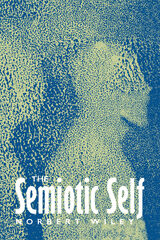 The Semiotic Self
Norbert Wiley
University of Chicago Press, 1994 In this book, Norbert Wiley offers a new interpretation of the nature of the self in society. Current theories of the self tend to either assimilate the self to a community or larger collective, or reduce the self to body. In distinct opposition to these theories, Wiley makes the case for an autonomous self, a human being who is a repository of rights, a free and equal agent in a democracy consisting of other selves.
Drawing on a fresh synthesis of the writings of Charles Sanders Peirce, George Herbert Mead, and others, Wiley argues that the self can be seen as an internal conversation, or a "trialogue" in which the present self ("I") talks to the future self ("you") about the past self ("me"). A distinctive feature of Wiley's view is that there is a mutually supportive relation between the self and democracy, and he traces this view through American history. In finding a way to decenter the self without eliminating it, Wiley supplies an alternative to current theories of postmodernism, a much-needed closure to classical pragmatism, and a new direction to neo-pragmatism.
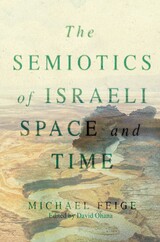 The Semiotics of Israeli Space and Time
Michael Feige
Sussex Academic Press, 2022 Analyses by the Israeli sociologist Michael Feige embraced every aspect of the State of Israel. He examined the ever-changing and complex identity of Israelis; how they remember and commemorate themselves; the long- and short-term conceptions of time of the left- and right-wing political movements; the spacial concept of the settlers; myths underlying the lives and deaths of its citizens; and the dialectical vicissitudes of the real and imagined Israel.
The book contains material from Professor Feige's literary output, contextualized in an Introduction by David Ohana. Chapters delve into the meaning of Israeli signs and symbols; the semiotics of secular spaces (sites of disasters and graves of political and religious leaders); the semiotics of historical time and daily existence; forms of commemoration (of figures like David Ben-Gurion, Yitzhak Rabin, airforce pilots, a female settler and a peace activist). Feige scrutinized communities formed around political cells, the processes of fragmentation and globalization in Israel, the traumas and scars from the Yom Kippur War, the evacuation of settlements, and the killing of Yitzhak Rabin. Feige's scrutiny illuminated Israeli
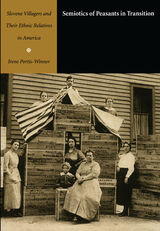 Semiotics of Peasants in Transition: Slovene Villagers and Their Ethnic Relatives in America
Irene Portis-Winner
Duke University Press, 2002 In Semiotics of Peasants in Transition Irene Portis-Winner examines the complexities of ethnic identity in a traditional Slovene village with unique ties to an American city. At once an investigation into a particular anthropological situation and a theoretical exploration of the semiotics of ethnic culture—in this case a culture permeated by transnational influences—Semiotics of Peasants in Transition describes the complex relationships that have existed between and among the villagers remaining in Slovenia and those who, throughout the nineteenth and twentieth centuries, emigrated to Cleveland, Ohio.
Describing a process of continuous and enduring interaction between these geographically separate communities, Portis-Winner explains how, for instance, financial assistance from the emigrants enabled their Slovenian hometown to survive the economic depressions of the 1890s and 1930s. She also analyzes the extent to which memories, rituals, myths, and traditional activities from Slovenia have sustained their Cleveland relatives. The result is a unique anthropological investigation into the signifying practices of a strongly cohesive—yet geographically split—ethnic group, as well as an illuminating application of semiotic analyses to communities and the complex problems they face.
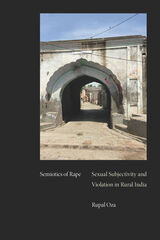 Semiotics of Rape: Sexual Subjectivity and Violation in Rural India
Rupal Oza
Duke University Press, 2023 In Semiotics of Rape, Rupal Oza follows the social life of rape in rural northwest India to reveal how rape is not only a violation of the body but a language through which a range of issues—including caste and gender hierarchies, control over land and labor, and the shape of justice—are contested. Rather than focus on the laws governing rape, Oza closely examines rape charges to show how the victims and survivors of rape reclaim their autonomy by refusing to see themselves as defined entirely by the act of violation. Oza also shows how rape cases become arenas where bureaucrats, village council members, caste communities, and the police debate women’s sexual subjectivities and how those varied understandings impact the status and reputations of individuals and groups. In this way, rape gains meaning beyond the level of the survivor and victim to create a social category. By tracing the shifting meanings of sexual violence and justice, Oza offers insights into the social significance of rape in India and beyond.
 Semiramide: Melodramma tragico in Two Acts, Libretto by Gaetano Rossi
Gioachino Rossini
University of Chicago Press, 2002 Semiramide brought Rossini's Italian career to a spectacular close in 1823. Its key scenes have great musical and dramatic impact, and in its expansive dimensions he attains masterful heights. Yet Semiramide remains true to neoclassical archetypes of style and form, with its preponderance of arias and duets. Proving gratifying to generations of fine singers, it was one of Rossini's last opere serie to disappear from the repertory and the first to be revived. Today it remains his most frequently performed Italian heroic opera. This critical edition is based on the autograph score, including the spartitino (for the wind and percussion instruments in large ensembles) recently discovered in the archives of Venice's La Fenice. More than a dozen contemporary manuscript copies and numerous early printed vocal scores were also consulted. An appendix includes Gossett's edition of Rossini's sketches for several numbers. Following the main score in three volumes, a fourth volume provides the original realization for the on-stage band.
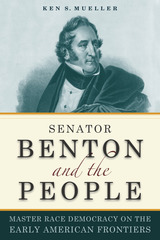 Senator Benton and the People: Master Race Democracy on the Early American Frontier
Ken S. Mueller
Northern Illinois University Press, 2014 Senator Thomas Hart Benton was a towering figure in Missouri politics. Elected in 1821, he was their first senator and served in Washington, DC, for more than thirty years. Like Andrew Jackson, with whom he had a long and complicated relationship, Benton came out of the developing western section of the young American Republic. The foremost Democratic leader in the Senate, he claimed to represent the rights of “the common man” against “monied interests” of the East. “Benton and the people,” the Missourian was fond of saying, “are one and the same”—a bit of bombast that reveals a good deal about this seasoned politician who was himself a mass of contradictions. He possessed an enormous ego and a touchy sense of personal honor that led to violent results on several occasions. Yet this conflation of “the people” and their tribune raises questions not addressed in earlier biographies of Benton.
Mueller provides a fascinating portrait of Senator Benton. His political character, while viewed as flawed by contemporary standards, is balanced by his unconditional devotion to his particular vision. Mueller evaluates Benton’s career in light of his attitudes toward slavery, Indian removal, and the Mexican borderlands, among other topics, and reveals Benton’s importance to a new generation of readers. He offers a more authentic portrait of the man than has heretofore been presented by either his detractors or his admirers.
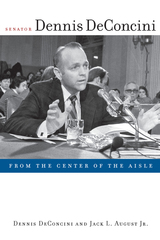 Senator Dennis DeConcini: From the Center of the Aisle
Dennis DeConcini and Jack L. August, Jr.
University of Arizona Press, 2006 Dennis DeConcini, a contemporary of Arizona greats like Sandra Day O’Connor, Barry Goldwater, and Rose Mofford, is an Arizona icon in his own right. Starting his public career as the Pima County Attorney, DeConcini orchestrated an unprecedented rise to a seat in the U.S. Senate, which he held for eighteen years. His political memoir, co-authored with historian Jack L. August Jr., reaches beyond typical reflections to provide the reader with penetrating and revealing insights into the inner workings and colorful characters of Arizona politics and the United States Senate.
A vigilant centrist, who got results by building coalitions on both sides of the aisle, Senator DeConcini’s approach was not bound to strict party alliances but was deeply rooted in the independent political environment of Arizona. During his career, he sponsored legislation limiting the sale of assault weapons, which provoked the National Rifle Association. He confounded Democratic Party regulars by supporting Clarence Thomas during the controversial confirmation hearings and again split with his party in his support for William Rehnquist’s nomination to Chief Justice. In 1980 he voted for Ronald Reagan, but in 1993 he cast the swing vote for President Bill Clinton’s tax bill, which was strongly opposed by Republicans in Arizona.
This political memoir will be of interest to anyone concerned with the inner workings of the U.S. Senate or Arizona politics and offers relevant insights into today’s political climate.
 Senator Howard Cannon of Nevada: A Biography
Michael Vernetti
University of Nevada Press, 2015 Howard Cannon (1912 - 2002) represented Nevada in the U.S. Senate from 1958 until 1982 and acquired a reputation as one of its most productive and influential members. Because he was a modest man more comfortable with hard work than self-aggrandizement, he was also one of its most under-appreciated. Nonetheless, Cannon influenced many major changes in American politics and policies during his time in office.
Born to a devout Mormon family in a small farming community in southwest Utah, Cannon served in the Army Air Force during World War II and emerged from the war as a hero. Soon he was part of the postwar migration of ambitious, adventurous Americans to the booming desert city of Las Vegas, where he practiced law and entered local politics. In 1958 he was elected to the U.S. Senate and joined a group of influential young Democratic senators who were to play a major role in shaping the country’s future. His service on the Aeronautical and Space Sciences Committee and the Armed Services Committee led to major changes in the air travel industry, including deregulation, and to increased support for national military preparedness.
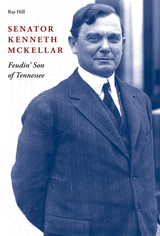 Senator Kenneth McKellar: Feudin' Son of Tennessee
Ray Hill
University of Tennessee Press, 2025 Kenneth McKellar may have been born in Reconstruction-era Alabama, but for most of his life, he was a Tennessean through and through. After graduating from the University of Alabama with bachelor’s, master’s, and law degrees, McKellar traveled to Memphis for what he expected to be a brief visit with his brothers. That visit was the genesis of a lifelong career and permanent home in West Tennessee. After successfully practicing law in Memphis, Kenneth McKellar kicked off his political career in the US House of Representatives in 1911, where he served until 1917 before becoming a US senator.
In his new biography of McKellar, Ray Hill traces the political career of Tennessee’s longest-serving senator and paints a colorful, nuanced portrait of the senator’s character and convictions. He chronicles McKellar's decades-long political contributions to Tennessee and the United States as a whole, from the beginnings of the Boss Crump political machine to McKellar’s historic victory as the first popularly elected US senator from Tennessee in 1916. Hill offers a balanced account of McKellar’s forty-two years in office, exploring his early Democratic successes under Woodrow Wilson and Franklin D. Roosevelt, his steadfast support for the Tennessee Valley Authority, and his fierce, unwavering commitment to Tennessee and its people.
As the only full-length biography of McKellar to date, Hill’s meticulously researched volume fills a significant gap in scholarship, shedding new light on the life and career of one of Tennessee’s most prominent political figures. Drawing on articles from more than one hundred US newspapers on McKellar’s life and politics, this biography will not only appeal to both scholars and students of US political science, but also offer a captivating story to all who love Tennessee and the state’s rich history.
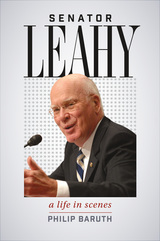 Senator Leahy: A Life in Scenes
Philip Baruth
University Press of New England, 2017 Having vaulted to a position in the United States Senate at the tender age of thirty-four, Patrick Leahy now claims the longest tenure of any member of that institution still serving—and he was third in line for the presidency when the Democrats held control. Few recent American lawmakers have watched history unfold so at such close range; fewer still have influenced it so powerfully. Philip Baruth brings a thriller-like intensity to the most spectacular of those scenes: the 9/11 attack on the US capital, the contentious drafting of the Patriot Act, the ensuing anthrax attacks, and the dramatic 2014 opening of diplomatic ties with Cuba. Throughout, the biography focuses in on Leahy’s meticulous image making, his cultivation of a “Top Cop” persona both in the media and at the ballot box. It is an approach that culminates in simultaneous roles for the lawmaker as chair of the Senate Judiciary Committee and as the tough-talking “distinguished gentleman” in Christopher Nolan’s acclaimed Dark Knight trilogy of Batman films. Leahy’s improbable success, Philip Baruth argues, in the end lies in his ability both to be and to play the top cop not only in post-Watergate Vermont, but in a post-9/11 America viciously divided between the red states and the blue.
 Senator Thomas J. Walsh of Montana: Law and Public Affairs, from TR to FDR
J. Leonard Bates
University of Illinois Press, 1999 This is the first comprehensive biography of Thomas J. Walsh, the Democratic senator from Montana from 1913 to 1933 who was best known for his role in uncovering the Teapot Dome scandal. J. Leonard Bates places Walsh in his colorful and tumultuous times, illuminating Montana history and politics as well as national movements including Progressivism, internationalism, Prohibition, war, and so-called normalcy.
Walsh fought throughout his long career against corruption and monopoly power. During his early years as a lawyer-politician in Helena, he was often in conflict with the "Copper Kings" and other powerful figures. As a senator, he became an internationalist, working throughout the 1920s for naval disarmament, the World Court, the St. Lawrence Seaway, and the Kellogg-Briand Pact for the "outlawry" of war.
In his most celebrated coup, breaking open the Teapot Dome scandal of 1923-24, Walsh revealed that the secretary of the interior had accepted "loans" from oil men in return for leases of U.S. naval oil reserves. Working through the Public Lands Committee of the Senate, Walsh enjoyed support for his investigation from members of both parties, and the Supreme Court endorsed his interpretation of the scandal in 1927. Shortly before his death, he presided over the Democratic National Convention that nominated Franklin Roosevelt and served for a brief time as a key figure in the new leader's circle.
Drawing on archival sources of unprecedented depth, including personal letters between Walsh and his first wife, Elinor McClements Walsh, Bates's expansive study paints a richly detailed portrait of an influential and principled figure whose political career spanned world war, depression, and the administrations of six presidents.
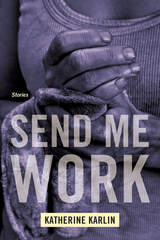 Send Me Work: Stories
Katherine Karlin
Northwestern University Press, 2011 Winner, 2011 Balcones Fiction Prize
Unlike the heroines of domestic fiction, Katherine Karlin's women face their biggest challenges outside of the house. The characters in this debut collection encompass a broad range of contemporary American experiences: a struggling young woman in post-Katrina New Orleans persuades a welder to teach her his trade; an orchestra oboist hears a confession from a beloved teacher; an idealistic aerobics instructor decamps for revolution- era Nicaragua to pick coffee on a farming collective.
In each of these stories, Karlin offers rare insight into the place of work in the lives of women, her narrators keenly observant and attuned to the humor that arises when life doesn't turn out as planned. But even more remarkable is the fullness with which she renders characters who make us wonder how they've escaped the notice of other writers. In unadorned prose that evokes complete worlds with deceptive ease, Karlin shows us people immersed in the negotiations of survival, just at the edge of being able to make sense of their lives.
 Send the Alabamians: World War I Fighters in the Rainbow Division
Nimrod T. Frazer
University of Alabama Press, 2014 Send the Alabamians recounts the story of the 167th Infantry Regiment of the WWI Rainbow Division from their recruitment to their valiant service on the bloody fields of eastern France in the climactic final months of World War I. To mark the centenary of World War I, Send the Alabamians tells the remarkable story of a division of Alabama recruits whose service Douglas MacArthur observed had not “been surpassed in military history.” The book borrows its title from a quip by American General Edward H. Plummer who commanded the young men during the inauspicious early days of their service. Impressed with their ferocity and esprit de corps but exasperated by their rambunctiousness, Plummer reportedly exclaimed:
In time of war, send me all the Alabamians you can get, but in
time of peace, for Lord’s sake, send them to somebody else!
The ferocity of the Alabamians, so apt to get them in trouble at home, proved invaluable in the field. At the climactic Battle of Croix Rouge, the hot-blooded 167th exhibited unflinching valor and, in the face of machine guns, artillery shells, and poison gas, sustained casualty rates over 50 percent to dislodge and repel the deeply entrenched and heavily armed enemy. Relying on extensive primary sources such as journals, letters, and military reports, Frazer draws a vivid picture of the individual soldiers who served in this division, so often overlooked but critical to the war’s success. After Gettysburg, the Battle of Croix Rouge is the most significant military engagement to involve Alabama soldiers in the state’s history. Families and genealogists will value the full roster of the 167th that accompanies the text. Richly researched yet grippingly readable, Nimrod T. Frazer’s Send the Alabamians will delight those interested in WWI, the World Wars, Alabama history, or southern military history in general. Historians of the war, regimental historians, military history aficionados, and those interested in previously unexplored facets of Alabama history will prize this unique volume as well.
 Senda Berenson: The Unlikely Founder of Women's Basketball
Ralph Melnick
University of Massachusetts Press, 2007 In the winter of 1892 the new instructor of physical training at Smith College, a diminutive young woman with a heavy accent, introduced her students to an adaptation of James Naismith's new game of Basket Ball. An immediate if unexpected success, the game spread to other women's schools across the country, and soon its founder, Senda Berenson (1868–1954), was called upon to codify its distinctive set of gender-specific rules. Emphasizing team passing and position over individual play, the version she instituted defined women's basketball for seventy years and eventually earned her the honor of being the first female elected to the Basketball Hall of Fame.
Yet as Ralph Melnick points out, Berenson's pioneering role in the history of women's athletics was more a matter of accident than destiny. A Jewish immigrant from Lithuania, prone to ill health throughout her childhood, she enrolled in the Boston Normal School for Gymnastics in the fall of 1890 with the hope of strengthening herself so that she could pursue a career as a pianist, dancer, or painter. Instead she soon became both a practitioner and a proponent of a new approach to women's physical education, one aimed at providing a "natural outlet of the play instinct," developing "endurance and physical courage" as well as "quickness of thought and action," and promoting through teamwork the "power of organization" women needed to achieve full social equality.
Extending her work into the factories and blighted urban tenements of America, Berenson later won the recognition of Jane Addams, Margaret Sanger, and other progressive reformers. Believing that "Americans have forgotten how to play," she wanted to teach others to live "joyfully—beautifully." For Berenson, the physical culture of exercise and games, played not for competition but for personal and social development as well as sheer enjoyment, was but another form of art.
This convergence of athletics and aesthetics was hardly surprising, Melnick explains, because the single most important influence on Senda Berenson's life was her brother, the renowned art critic and connoisseur Bernard Berenson. The two siblings wrote frequently to each other over the course of their lives, and the author draws heavily on their correspondence throughout the book to create an intimate and insightful portrait of a remarkable American woman.
Sender: A Play
Ike Holter
Northwestern University Press, 2019 Ike Holter’s Sender thrives on the contrast between order and chaos and the tensions that emerge as we leave childhood and adolescence behind to contend with the demands of “adulting.” In this comedy, Holter presents us with four millennial friends wrestling with these issues. While each is at a different stage of “growing up,” one of the friends has disappeared and has been presumed dead. Yet, at the beginning of the play, he returns and completely upends the balance established in his absence. This witty, foul mouthed, and razor-sharp play asks: “What does growing up mean . . . and is it even desired in this day and age?” Sender is one of seven plays in Holter’s Rightlynd Saga, all to be published by Northwestern University Press. Holter’s plays are set in Chicago’s fictional fifty-first ward. The other plays in the cycle are Exit Strategy, Lottery Day, Prowess, Red Rex, Rightlynd, and The Wolf at the End of the Block.
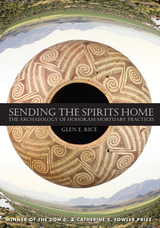 Sending the Spirits Home: The Archaeology of Hohokam Mortuary Practices
Glen E. Rice
University of Utah Press, 2015 Winner of the Don D. and Catherine S. Fowler Prize
This data-rich monograph provides new and stimulating perspectives on the Hohokam people and their mortuary practices. It breaks new ground by using the knowledge of descendent peoples to generate archaeologically testable hypotheses; demonstrating the need for mortuary analyses conducted at a regional scale; and synthesizing of the interaction of beliefs, ideology, social organization, and ecology in determining Hohokam mortuary practices. Various chapters discuss body treatment, mortuary furniture and goods, mortuary architecture, and cemeteries, and numerous figures help document the variability of Hohokam practices.
The study synthesizes data from various excavations, applied archaeology, and cultural resource management projects. With its review of past research and ethnographic accounts along with line drawings of mortuary features and artifacts, Sending the Spirits Home provides tools for the adoption of standardized protocols needed to facilitate cross-project comparisons on which future regional syntheses can be based. Although written for archaeologists, the book does not require a specialist’s knowledge to appreciate its insights into these early people of the Southwest.
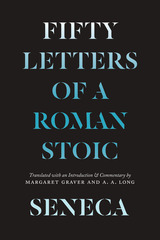 Seneca: Fifty Letters of a Roman Stoic
Lucius Annaeus Seneca
University of Chicago Press, 2021 A selection of Seneca’s most significant letters that illuminate his philosophical and personal life.
“There is only one course of action that can make you happy. . . . rejoice in what is yours. What is it that is yours? Yourself; the best part of you.”
In the year 62, citing health issues, the Roman philosopher Seneca withdrew from public service and devoted his time to writing. His letters from this period offer a window onto his experience as a landowner, a traveler, and a man coping with the onset of old age. They share his ideas on everything from the treatment of enslaved people to the perils of seafaring, and they provide lucid explanations for many key points of Stoic philosophy.
This selection of fifty letters brings out the essentials of Seneca’s thought, with much that speaks directly to the modern reader. Above all, they explore the inner life of the individual who proceeds through philosophical inquiry from a state of emotional turmoil to true friendship, self-determination, and personal excellence.
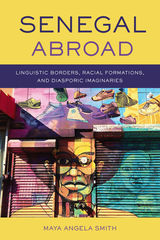 Senegal Abroad: Linguistic Borders, Racial Formations, and Diasporic Imaginaries
Maya Angela Smith
University of Wisconsin Press, 2020 Senegal Abroad explores the fascinating role of language in national, transnational, postcolonial, racial, and migrant identities. Capturing the experiences of Senegalese in Paris, Rome, and New York, it depicts how they make sense of who they are—and how they fit into their communities, countries, and the larger global Senegalese diaspora. Drawing on extensive interviews with a wide range of emigrants as well as people of Senegalese heritage, Maya Angela Smith contends that they shape their identity as they purposefully switch between languages and structure their discourse.
The Senegalese are notable, Smith suggests, both in their capacity for movement and in their multifaceted approach to language. She finds that, although the emigrants she interviews express complicated relationships to the multiple languages they speak and the places they inhabit, they also convey pleasure in both travel and language. Offering a mix of poignant, funny, reflexive, introspective, and witty stories, they blur the lines between the utility and pleasure of language, allowing a more nuanced understanding of why and how Senegalese move.
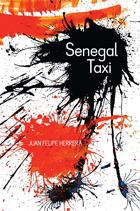 Senegal Taxi
Juan Felipe Herrera
University of Arizona Press, 2013 “I wish I could find the words to tell you the story of our village after you were killed.” So begins Senegal Taxi, the new work by one of contemporary poetry’s most vibrant voices, Juan Felipe Herrera. Known for his activism and writings that bring attention to oppression and injustice, Herrera turns to stories of genocide and hope in Sudan. Senegal Taxi offers the voices of three children escaping the horrors of war in Africa.
Unflinching in its honesty, brutality, and beauty, the collection fiercely addresses conflict and childhood, inviting readers to engage in complex and often challenging issues. Senegal Taxi weaves together verse, dialogue, and visual art created by Herrera specifically for the book. Stylistically genre-leaping, these many layers are part of the collection’s innovation. Phantom-like televisions, mud drawings, witness testimonies, insects, and weaponry are all storytellers that join the siblings for a theatrical crescendo. Each poem is told from a different point of view, which Herrera calls “mud drawings,” referring to the evocative symbols of hope the children create as they hide in a cave on their way to Senegal, where they plan to catch a boat to the United States.
This collection signals a poignant shift for Herrera as he continues to use his craft to focus attention on global concerns. In so doing, he offers an acknowledgment that the suffering of some is the suffering of all.
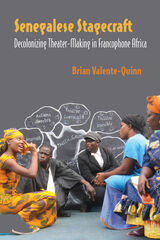 Senegalese Stagecraft: Decolonizing Theater-Making in Francophone Africa
Brian Valente-Quinn
Northwestern University Press, 2021 Senegalese Stagecraft explores the theatrical stage in Senegal as a site of poetic expression, political activism, and community engagement. In their responses to the country’s colonial heritage, as well as through their innovations on the craft of theater‑making, Senegalese performers have created an array of decolonizing stage spaces that have shaped the country’s theater history. Their work has also addressed a global audience, experimenting with international performance practices while proposing new visions of the role of culture and stagecraft in society.
Through a study of the innovative work of Senegalese theater-makers from the 1930s onward, Senegalese Stagecraft explores a wide range of historical contexts and themes, including French colonial education, cultural Pan‑Africanism, West African Sufism, uses of television and mass media, and popular theater and activism. Using a multidisciplinary approach that includes field, archival, and literary methods, Valente‑Quinn offers a fresh look at performance cultures of West Africa and the Global South in a book that will interest students and scholars in African, Francophone, and performance studies.
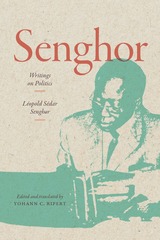 Senghor: Writings on Politics
Léopold Sédar Senghor. Edited and translated by Yohann C. Ripert
Duke University Press, 2025 Senghor: Writings on Politics brings Léopold Sédar Senghor’s most vital essays, speeches, and political writings to English-language readers for the first time. Spanning the colonial and postcolonial years between 1937 and 1971, this volume captures Senghor’s evolution from a pioneering poet and cofounder of Négritude to the president of Senegal as he grappled with the complexities of postcolonial identity, governance, and cultural hybridity. Senghor’s reflections on topics ranging from federalism and decolonization to Francophonie reveal his commitment to weaving African and European cultural threads into a vision of global solidarity in ways that resonate with contemporary debates on race, culture, and politics. Inviting readers to engage with a seminal figure whose legacy continues to inspire new ways of thinking about freedom, independence, and coexistence, this landmark book furthers our understanding of one of the twentieth century’s most influential cultural thinkers.
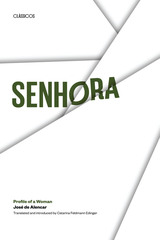 Senhora: Profile of a Woman
By José de Alencar
University of Texas Press, 1994 "It is a truth universally acknowledged . . ." that a single woman in possession of a good character but no fortune must be in want of a wealthy husband—that is, if she is the heroine of a nineteenth-century novel. Senhora, by contrast, turns the tables on this familiar plot. Its strong-willed, independent heroine Aurélia uses newly inherited wealth to "buy back" and exact revenge on the fiancé who had left her for a woman with a more enticing dowry. This exciting Brazilian novel, originally published in 1875 and here translated into English for the first time, raises many questions about traditional gender relationships, the commercial nature of marriage, and the institution of the dowry. While conventional marital roles triumph in the end, the novel still offers realistic insights into the social and economic structure of Rio de Janeiro in the mid-1800s. With its unexpected plot, it also opens important new perspectives on the nineteenth-century Romantic novel.
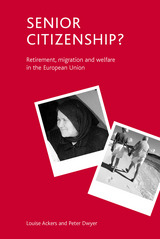 Senior citizenship?: Retirement, migration and welfare in the European Union
Louise Ackers and Peter Dwyer
Bristol University Press, 2002 This book charts the development of mobility and welfare rights for those citizens exercising their right to move or return home on retirement under the Free Movement of Persons provisions and explores their experiences of international mobility. It is set within the context of 'Citizenship of the Union'. Senior citizenship? draws on substantial primary research material to: combine detailed analysis of the framework of EU rights shaping social with in-depth qualitative interviews involving retired migrants across six member states (Greece, Portugal, Italy, the United Kingdom, Sweden and Ireland);·[vbTab]describe and evaluate an innovative approach to comparative enquiry that combines biographical interviews with legal and qualitative analysis;·[vbTab]highlight the diverse nature of retirement migration encompassing the experiences of returning workers, migrating retirees and post retirement returnees.·[vbTab]Topics are explored thematically in the context of comparative social policy, raising important and topical issues around the future of social citizenship and the implications of the exercise of agency, in an increasingly global and mobile world.
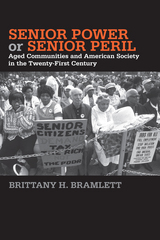 Senior Power or Senior Peril: Aged Communities and American Society in the Twenty-First Century
Brittany H Bramlett
Temple University Press, 2015 As the Baby Boomer generation ages, the number of senior citizens as a proportion of the overall electorate is going to reach record numbers. This fact prompted Brittany Bramlett to ask: When senior citizens make up a large proportion of the local population, are they politically more powerful, or are they perhaps more powerless?
In Senior Power or Senior Peril, Bramlett examines the assertions that the increasing number of older adult-concentrated communities across the United States form a growing bloc of senior power that will influence the redistribution of particularized welfare benefits to older adults at the expense of younger people. However, others suggest that political influence declines with old age. Bramlett uses interviews and on-site research at various senior communities to explore what qualities make an aged community politically unique, and the impact of the local aged context on residents' political knowledge, safety-net policy attitudes, efficacy, and political activity.
This path-breaking book identifies the political behaviors, attitudes, and political consciousness of both older and younger residents as it recounts the perceived and actual political power of seniors.
In the series The Social Logic of Politics, edited by Scott McClurg
Seniors in Casino Land: Tough Luck for Older Americans
Amy Ziettlow
American Philanthropic, 2014 In 2012, over 50 percent of those patronizing a casino were over 50 years of age. Have casinos become today's senior center? Come with Amy Ziettlow as she travels through America's casinos, eating at the buffets, playing the slots, and talking to as many seniors as she can. A stark picture emerges.
Now that the goverment is the biggest sponsor of casino gaming, all of us--even those who never visit casinos--have to ask: Are we turning a blind eye to a government-sponsored predator that creates false community, drains personal finances, and undermines dignity for those most vulnerable among us? Read this first-hand report from the glitzy, senior-filled trenches of "Casino Land."
Sennacherib, King of Assyria
Josette Elayi
SBL Press, 2018 A critical resource for students and scholars of the ancient Near East and the Bible
Josette Elayi’s Sennacherib, King of Assyria is the only biography of Sargon II’s famous son.
Elayi traces the reign of Sennacherib in context in order to illuminate more fully the life and contributions of this warlord, builder, innovator, and social reformer—a unique figure among the Assyrian kings. Elayi offers both an evaluation of this royal figure and an assessment of the Assyrian Empire by interpreting the historical information surrounding the decisive events of his reign.
Features:
- Exploration of why Sennacherib did not seize Jerusalem or remove Hezekiah from the throne
- An extensive investigation of annals, royal inscriptions, letters, palace reliefs, clay tablets, and excavation reports
- Maps and tables
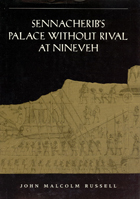 Sennacherib's "Palace without Rival" at Nineveh
John Malcolm Russell
University of Chicago Press, 1991 Best known today from biblical accounts of his exploits and ignominious end, the Assyrian king Sennacherib (704-681 B.C.) was once the ruler of all western Asia. In his capital at Nineveh, in what is now northern Iraq, he built what he called the "Palace without Rival." Though only scattered traces of this magnificent structure are visible today, contemporary written descriptions and surviving wall reliefs permit a remarkably detailed reconstruction of the appearance and significance of the palace.
An art historian trained in ancient Near East philology, archaeology, and history, John Malcolm Russell marshals these resources to investigate the meaning and political function of the palace of Sennacherib. He contends that the meaning of the monument cannot be found in images or texts alone; nor can these be divorced from architectural context. Thus his study combines discussions of the context of inscriptions in Sennacherib's palace with reconstructions of its physical appearance and analyses of the principles by which the subjects of Sennacherib's reliefs were organized to express meaning. Many of the illustrations are published here for the first time, notably drawings of palace reliefs made by nineteenth-century excavators and photographs taken in the course of the author's own excavations at Nineveh.
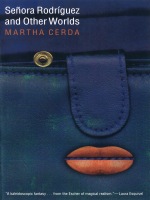 Señora Rodríguez and Other Worlds
Martha Cerda
Duke University Press, 1997 Señora Rodríguez dips into her purse and there’s no telling what she’ll come up with—a sticky lollipop, a phone bill, or a rosary; a reminder of daily life, a bit of family history, a personal talisman, or . . . who knows? . . . a token into another world altogether. Such are the surprises and possibilities, the unpredictability and warm familiarity of Martha Cerda’s magical novel. Señora Rodriguez and her family are placed shoulder-to-shoulder and page-to-page with strangers, acquaintances, and a host of importune, if not impertinent, stories: the profound distortions wrought in a woman’s life by the oppressive presence of her maid; the furor caused by a premenstrual pimple; the flashbacks and chaotic grief Judas Iscariot experiences at the moment of his death; the disruption surrounding the appearance of a supposed member of the Los Angeles Dodgers.
A bestselling writer widely celebrated in her native Mexico, Martha Cerda defines her own turn along the path of Latin American magical realism. In this novel the feminine, the practical, and the earthy blend with the fantastic and phantasmagoric. Tragedy and playfulness, sophistication and naiveté mingle. What is at once a comedy of manners, a delightful collection of loosely related anecdotes, stories, sketches, and epiphanies, is also an artful entree into several literary and philosophical questions—the relationship between language and reality and the power of one to create and alter the other; the link between chaos and different forms of organization that pass for order.
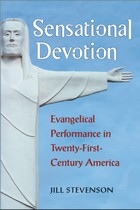 Sensational Devotion: Evangelical Performance in Twenty-First-Century America
Jill Stevenson
University of Michigan Press, 2015 Sensational Devotion examines contemporary Passion plays, biblical theme parks, Holy Land recreations, creationist museums, and megachurches in order to understand how they serve their evangelical believer-users while also shaping larger cultural and national dialogues. Jill Stevenson explores how performative media support specific theologies and core beliefs by creating sensual, live experiences for those who use them. The book explores evangelical performance across a range of media and sites, including film, television, theater, tourist attractions, museums, and places of worship. Using historical research coupled with firsthand experiences, it critically examines these spaces and events within their specific religious, cultural, and national contexts, while placing them within a long devotional tradition to suggest how they cultivate religious belief by generating vivid, sensual, affectively oriented, and individualized experiences. Stevenson’s analysis builds upon existing work on performance and cognition, as well as theories of affect, as it contributes to existing scholarship on American evangelicalism and evangelical Christian media.
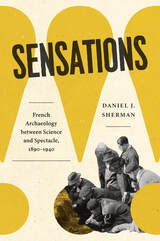 Sensations: French Archaeology between Science and Spectacle, 1890–1940
Daniel J. Sherman
University of Chicago Press, 2025 Delves into two controversies from the French archaeological world to illuminate the tension between the discipline’s scientific ambitions and its hunger for media attention.
For well over a century, from Heinrich Schliemann’s sensational discoveries at Troy in the 1880s, through the Tutankhamun excavations of the 1920s, to the recent LIDAR-aided uncovering of lost Maya cities, archaeology has made headlines. In this new history of archaeology and its archival traces, Daniel J. Sherman treats the friction between science and spectacle as constitutive of the field. By exploring two long-running controversies that roiled the French archaeological world and its wider public in the first third of the twentieth century, he gives the science/media relationship a unique place in the history of archaeology—and its present.
The first controversy involves a dispute over the conduct of excavations at Carthage in Tunisia, then under French colonial rule. In the second, accusations of forgery clouded what seemed to be a stunning Neolithic find at a hamlet called Glozel, in the Auvergne region in central France. The affair divided the scholarly community and attracted enormous media attention across Europe and North America. Both controversies occurred at a transitional moment between what has been called the heroic age of archaeology, dominated by explorers and adventurers with little specialized training, and the beginnings of its professionalization. As Sherman shows, the two affairs put the methods, procedures, and networks of archaeology in the spotlight and profoundly shaped its history.
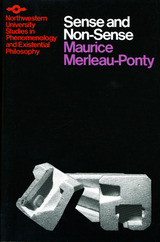 Sense and Non-Sense
Maurice Merleau-Ponty
Northwestern University Press, 1992 Written between 1945 and 1947, the essays in Sense and Non-Sense provide an excellent introduction to Merleau-Ponty's thought. They summarize his previous insights and exhibit their widest range of application-in aesthetics, ethics, politics, and the sciences of man. Each essay opens new perspectives to man's search for reason.
The first part of Sense and Non-Sense, "Arts," is concerned with Merleau-Ponty's concepts of perception, which were advanced in his major philosophical treatise, Phenomenology of Perception. Here the analysis is focused and enriched in descriptions of the perceptual world of Cezanne, the encounter with the Other as expressed in the novels of Simone de Beauvoir and Sartre, and the gestalt quality of experience brought out in the film art form. In the second part, "Ideas," Merleau-Ponty shows how the categories of the phenomenology of perception can be understood as an outgrowth of the behavioral sciences and how a model of existence based on perception sensitizes us to the insights and limitations of previous philosophies and suggests constructive criticisms of contemporary philosophy. The third part, "Politics," clarifies the political dilemmas facing intellectuals in postwar France.
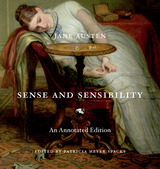 Sense and Sensibility: An Annotated Edition
Jane Austen
Harvard University Press, 2013 “Jane Austen lovers worldwide will cherish these books...Prepare yourself for a major treat.”
—Christian Science Monitor
When you fall in love with this book, it will be forever.
Sense and Sensibility, published anonymously in 1811: “By A Lady,” marked Jane Austen’s début as a novelist. Austen’s real name has since become as familiar as Shakespeare’s, and this tale of sisterly devotion and romantic trials has lost none of its power to enchant. As the Dashwood sisters’ struggles give way to grounded, perhaps richer happiness, the novel offers shrewd commentary on the conditions of women in early nineteenth-century England. Experience their lives and love anew with this extraordinary, annotated edition.
For beginners and experts alike—immerse yourself in Jane Austen’s world: For the modern reader, our annotations provide clear explanations and illuminating context for period language and references (who are nabobs, anyway?). For the enthusiast, they offer fresh, exciting analysis—a passionate friend in the margins.
A work of art—the ideal gift: Perfect for gifting, collecting, and cherishing, this grand hardcover (9” x 9.5”) brims with hundreds of full-color illustrations that vividly recreate Austen’s world—its fashions, carriages, libraries, and estates.
The story: When their father dies, the Dashwood sisters' inheritance passes to their stepbrother, leaving them with greatly reduced means and uncertain futures. Passionate Marianne falls for the dashing but mysterious Willoughby despite the warnings of her ever-practical sister Elinor. Meanwhile, Elinor struggles to conceal her own attachment to Edward Ferrars—even as a shocking secret threatens her hopes. Through their experiences of love and loss, both sisters discover that neither sense nor sensibility can guarantee happiness—only the wisdom to know when each has its place.
 Sense and Spectacle in the Age of Philip IV: Performing Empire in Word, Music, and Image
Mary Quinn
Amsterdam University Press, 2024 This book accounts for the outpouring of celebrations in the Habsburg Empire upon the 1657 birth of Felipe Próspero, heir to Philip IV of Spain. These celebrations allow us to interrogate the shifting uses of performance in the empire’s center and periphery. Such spectacles could work to contain and manipulate public sentiment, but at other moments they questioned sanctioned power structures. A study of zarzuela texts, opera libretti, notated music, paintings, poems, and historical documents shows that an array of people took advantage of this festive moment to question the empire’s policies in surprising ways. Sensorial experience played a crucial role during these celebrations. For its part, the Crown engaged a variety of senses, especially sight, sound, and smell, in order to augment the impact of royal spectacles. But simultaneously, those who questioned the Crown also did so through an engagement of the sensorial world.
 Sense and Uncertainty: A Phenomenology of Rational Actions in an Uncertain World
Esteban Marín-Ávila
Ohio University Press, 2025 Sense and Uncertainty presents a phenomenological account of the possibility of rational action amid the challenges posed by violence, volatile conditions, uncertain outcomes, and social dependence. The book asks us to consider the following: - We are often forced through violence to do things that do not make sense for us except to avoid retaliations, punishments, or the various evils that others might inflict on us.
- We inhabit a world that escapes our control. This involves living in uncertainty concerning the things that we might suffer and do, that is, the things that might happen to us and the results of our actions.
- We are dependent on others and collaborate with them in ways that make it impossible to fully understand the sense of our own actions and practical intentions.
Rationality involves insightful thinking about the world and our emotional responses to it, something we do in our everyday lives, whether consciously or without awareness. Sense and Uncertainty attempts to make explicit and to clarify the implications of this conceptually neglected aspect of our rationality: namely, that it involves paying attention to our emotions and values. An ethical life in which we can act meaningfully in the face of violence and uncertainty, and in which we can make sense of our vulnerability and dependence on others, demands that we think about and seek insight into how we love, why we hope, and in whom or in what we trust. The phenomenological ethics presented in Sense and Uncertainty draws on the works of Western canonical philosophers like Edmund Husserl, Max Scheler, Simone de Beauvoir, Anthony Steinbock, and José Ortega y Gasset, as well as on those of Latin American thinkers such as Luis Villoro, Rita Segato, and Augusto Salazar Bondy, among others.
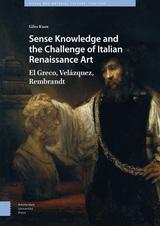 Sense Knowledge and the Challenge of Italian Renaissance Art: El Greco, Velázquez, Rembrandt
Giles Knox
Amsterdam University Press, 2019 Giles Knox examines how El Greco, Velaìzquez, and Rembrandt, though a disparate group of artists, were connected by a new self-consciousness with respect to artistic tradition. In particular, Knox considers the relationship of these artists to the art of Renaissance Italy, and sets aside nationalist art histories in order to see the period as one of fruitful exchange. Across Europe during the seventeenth century, artists read Italian-inspired writings on art and these texts informed how they contemplated their practice. Knox demonstrates how these three artists engaged dynamically with these writings, incorporating or rejecting the theoretical premises to which they were exposed. Additionally, this study significantly expands our understanding of how paintings can activate the sense of touch. Knox discusses how Velaìzquez and Rembrandt, though in quite different ways, sought to conjure for viewers thoughts about touching that resonated directly with the subject matter they depicted.
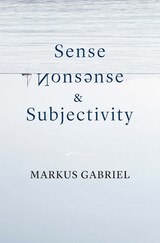 Sense, Nonsense, and Subjectivity
Markus Gabriel
Harvard University Press, 2024 A leading German philosopher offers his most ambitious work yet on the nature of knowledge, arguing that being wrong about things defines the human condition.
For millennia, philosophers have dedicated themselves to advancing understanding of the nature of truth and reality. In the process they have amassed a great deal of epistemological theory—knowledge about knowledge. But negative epistemological phenomena, such as ignorance, falsity, illusion, and delusion, are persistently overlooked. This is surprising given that we all know how fallible humans are.
Sense, Nonsense, and Subjectivity replies with a theory of false thought, demonstrating that being wrong about things is part and parcel of subjectivity itself. For this reason, knowledge can never be secured without our making claims that can always, in principle, be wrong. Even in successful cases, where we get something right and thereby gain knowledge, the possibility of failure lingers with us. Markus Gabriel grounds this argument in a novel account of the relationship between sense, nonsense, and subjectivity—phenomena that hang together in the temporal unfolding of our cognitive lives.
While most philosophers continue to theorize subjectivity in terms of conscious self-representation and the supposedly infallible grip we have on ourselves as thinkers, Sense, Nonsense, and Subjectivity addresses the age-old Platonic challenge to understand situations in which we do not get reality right. Adding a stimulating perspective on epistemic failures to the work of New Realism, Gabriel addresses long-standing ontological questions in an age where the line between the real and the fake is increasingly blurred.
 A Sense of Arrival
Kevin Adonis Browne
Duke University Press, 2024 In A Sense of Arrival, Kevin Adonis Browne blends literary, visual, and material forms to present a narrative of Caribbean blackness. Arguing that the story of Caribbeanness cannot be told through words alone, Browne interweaves essays, memoir, autotheory, and narrative verse with documentary photography, portraiture, Rorschach blots, and images of his own sculptures and art installations. Browne labels this multimodal approach and rhetorical form “Caribbean nonfiction,” and he uses it to conceptualize arrival as a theory of being. Arrival is practiced through forms of status, return, belonging, nomadism, self-exile, love, loss, presence, and haunting, each of which expresses the vast complexity and urgency of Caribbeanness. At the same time, arrival emphasizes and extends Caribbean ways of being, knowing, and doing. Throughout, Browne challenges readers to follow the archipelagic sensibilities of the Caribbean to look beyond black death and apprehend the inherent optimism and beauty of arrival. A singular meditation on the art and process of Caribbeanness, A Sense of Arrival is a statement on how the black Caribbean self comes to be.
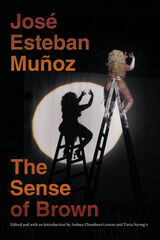 The Sense of Brown
José Esteban Muñoz. Edited and with an Introduction by Joshua Chambers-Letson and Tavia Nyong'o
Duke University Press, 2020 The Sense of Brown is José Esteban Muñoz's treatise on brownness and being as well as his most direct address to queer Latinx studies. In this book, which he was completing at the time of his death, Muñoz examines the work of playwrights Ricardo Bracho and Nilo Cruz, artists Nao Bustamante, Isaac Julien, and Tania Bruguera, and singer José Feliciano, among others, arguing for a sense of brownness that is not fixed within the racial and national contours of Latinidad. This sense of brown is not about the individualized brown subject; rather, it demonstrates that for brown peoples, being exists within what Muñoz calls the brown commons—a lifeworld, queer ecology, and form of collectivity. In analyzing minoritarian affect, ethnicity as a structure of feeling, and brown feelings as they emerge in, through, and beside art and performance, Muñoz illustrates how the sense of brown serves as the basis for other ways of knowing and being in the world.
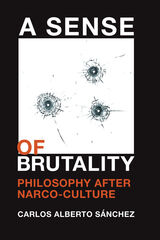 A Sense of Brutality: Philosophy after Narco-Culture
Carlos Alberto Sánchez
Amherst College Press, 2020 Contemporary popular culture is riddled with references to Mexican drug cartels, narcos, and drug trafficking. In the United States, documentary filmmakers, journalists, academics, and politicians have taken note of the increasing threats to our security coming from a subculture that appears to feed on murder and brutality while being fed by a romanticism about power and capital. Carlos Alberto Sánchez uses Mexican narco-culture as a point of departure for thinking about the nature and limits of violence, culture, and personhood. A Sense of Brutality argues that violent cultural modalities, of which narco-culture is but one, call into question our understanding of “violence” as a concept. The reality of narco-violence suggests that “violence” itself is insufficient to capture it, that we need to redeploy and reconceptualize “brutality” as a concept that better captures this reality. Brutality is more than violence, other to cruelty, and distinct from horror and terror—all concepts that are normally used interchangeably with brutality, but which, as the analysis suggests, ought not to be. In narco-culture, the normalization of brutality into everyday life is a condition upon which the absolute erasure or derealization of people is made possible.
"The study is original, bringing a wide range of voices into dialogue to present a problem that is pressing and deserving of careful analysis. The study will contribute to the field of Latin American philosophy in important ways... This is the only book by a philosopher on the topic of narco-culture, and I think it’s an important contribution to a topic that should be addressed by philosophers." —Elizabeth Millán, DePaul University
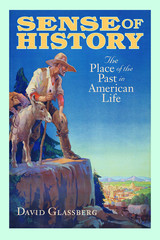 Sense of History: The Place of the Past in American Life
David Glassberg
University of Massachusetts Press, 2001 As Americans enter the new century, their interest in the past has never been greater. In record numbers they visit museums and historic sites, attend commemorative ceremonies and festivals, watch historically based films, and reconstruct family genealogies. The question is, Why? What are Americans looking for when they engage with the past? And how is it different from what scholars call "history"? In this book, David Glassberg surveys the shifting boundaries between the personal, public, and professional uses of the past and explores their place in the broader cultural landscape. Each chapter investigates a specific encounter between Americans and their history: the building of a pacifist war memorial in a rural Massachusetts town; the politics behind the creation of a new historical festival in San Francisco; the letters Ken Burns received in response to his film series on the Civil War; the differing perceptions among black and white residents as to what makes an urban neighborhood historic; and the efforts to identify certain places in California as worthy of commemoration. Along the way, Glassberg reflects not only on how Americans understand and use the past, but on the role of professional historians in that enterprise. Combining the latest research on American memory with insights gained from Glassberg's more than twenty years of personal experience in a variety of public history projects, Sense of History offers stimulating reading for all who care about the future of history in America.
The Sense of Immortality
Philip Cabot
Harvard University Press Mr. Cabot here gives expression to what has become the fundamental conviction of his life, forced upon him by a remarkable personal experience. Seldom has the belief in immortality been more cogently set forth; seldom have words been compelled to carry such depth of meaning. In a day of religious indifference, Mr. Cabot is a new prophet, his lips touched with coals from the divine altar, his whole heart aflame with his message. Such faith will not only bring deeper satisfaction to those who already believe: it must carry unusual weight and suggestion to the hesitant who are still debating the question of immortality.
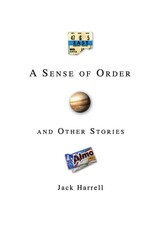 A Sense of Order: And Other Stories
Jack Harrell
Signature Books, 2010 The author asks a big question: Who is responsible? One person in need of this information is Lon, who wonders why his marriage is falling apart. Lon thought his wife would re-initiate intimacy at some point. She doesn’t, and he sets out to find the man he thinks stands between them but only finds an apparition—and he still can’t fix his marriage.
In another story, the LDS prophet is drawn to s simpler time when he could wander out unnoticed and buy a candy bar. Church Security won’t let him outside on his own and Public Relations won’t let him wear anything but a suit and tie. Still, the impulse to be a regular guy for an afternoon is compelling. Can’t he make his own decisions? He can, but what are the consequences?
And then there’s Jerry, who passes three men in suits who are talking and laughing at the loading dock behind an LDS temple. One of them looks up, drops a cigarette and crushes it, then slips into a nearby car. Another man—someone who has made Jerry’s life miserable—taunts him, saying: “Jerry, your goodness is your enemy …and tell all your friends.” Who is responsible? Maybe it’s the author’s reverie that’s to blame, but his stories have a way of getting deep inside the psyche and haunting us.
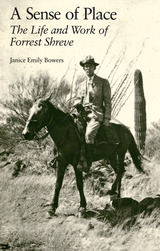 A Sense of Place: The Life and Work of Forrest Shreve
Janice Emily Bowers
University of Arizona Press, 1988 Forrest Shreve (1878-1950) was an internationally known plant ecologist who spent most of his career at the Carnegie Institution's Desert Laboratory in Tucson, Arizona. Shreve's contributions to the study of plant ecology laid the groundwork for modern studies and several of his works came to be regarded as classics by ecologists worldwide. This first full-length study of Shreve's life and work demonstrates that he was more than a desert ecologist. His early work in Maryland and Jamaica gave him a breadth of expertise matched by few of his ecological contemporaries, and his studies of desert plant demography, the physiological ecology of rain-forest plants, and vegetational gradients on southwestern mountain ranges anticipated by decades recent trends in ecology.
Tracing Shreve's development from student to scientist, Bowers evokes the rigors and delights of fieldwork in the first half of this century and shows how Shreve's sense of place informed his scientific thought—making him, in his own words, "not an exile from some better place, but a man at home in an environment to which his life can be adjusted without physical or intellectual loss."
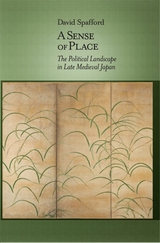 A Sense of Place: The Political Landscape in Late Medieval Japan
David Spafford
Harvard University Press, 2013 A Sense of Place examines the vast Kanto region as a locus of cultural identity and an object of familial attachment during the political and military turmoil of the late fifteenth and early sixteenth centuries in Japan. Through analysis of memoirs, letters, chronicles, poetry, travelogues, lawsuits, land registers, and archeological reports, David Spafford explores the relationships of the eastern elites to the space they inhabited: he considers the region both as a whole, in its literary representations and political and administrative dimensions, and as an aggregation of discrete locales, where struggles over land rights played out alongside debates about the meaning of ties between families and their holdings. Spafford also provides the first historical account in English of medieval castle building and the castellan revolution of the late fifteenth century, which militarized the countryside and radically transformed the exercise of authority over territory.
Simultaneously, the book reinforces a sense of the eastern elite's anxieties and priorities, detailing how, in their relation to land and place, local elites displayed a preference for past precedent and inherited wisdom. Even amidst the changes wrought by war, this inclination, although quite at odds with their conventional reputation for ruthless pragmatism and forward thinking, prevailed.
 The Sense of Sound, Volume 22
Rey Chow
Duke University Press Sound has given rise to many rich theoretical reflections, but when compared to the study of images, the study of sound continues to be marginalized. How is the “sense” of sound constituted and elaborated linguistically, textually, technologically, phenomenologically, and geologically, as well as acoustically? How is sound grasped as an object? Considering sound both within and beyond the scope of the human senses, contributors from literature, film, music, philosophy, anthropology, media and communication, and science and technology studies address topics that range from Descartes’s resonant subject to the gendering of hearing physiology in the nineteenth century, Cold War politics and the opera Nixon in China, sounds from the Mediterranean, the poetics of signal processing, and the acousmatic voice in the age of MP3s. In the interpretive challenges posed by voice, noise, antinoise, whispering, near inaudibility, and silence and in the frequent noncoincidence of emission and reception, sound confronts us with what might be called its inhuman qualities—its irreducibility to meaning, to communication, to information, and even to recognition and identification. Rey Chow is Anne Firor Scott Professor of Literature at Duke University. She is the author of The Age of the World Target and Modern Chinese Literary and Cultural Studies in the Age of Theory, both published by Duke University Press. James A. Steintrager is Professor and Chair of English at the University of California, Irvine.
Contributors: Caroline Bassett, Eugenie Brinkema, Iain Chambers, Michel Chion, Rey Chow, Mladen Dolar, Veit Erlmann, Evan Johnson, Christopher Lee, Mara Mills, John Mowitt, Dominic Pettman, Tara Rodgers, Nicholas Seaver, James A. Steintrager, Jonathan Sterne,
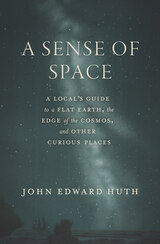 A Sense of Space: A Local’s Guide to a Flat Earth, the Edge of the Cosmos, and Other Curious Places
John Edward Huth
University of Chicago Press, 2025 From global navigation to natal charts to memory palaces and beyond, a thrilling journey through humanity’s visualization of new spaces.
When you give directions, do you tell someone to go straight ahead and turn left? Or do you suggest that they head north before moving west? Your answer reveals more than you might think.
In A Sense of Space, writer and physicist John Edward Huth uses these two kinds of navigation—either centered on or independent of people—to help readers chart a path through evolving spatial models. In doing so, he offers an astonishing exploration of how changing scientific models of space alter our social perceptions, and vice versa. New visions of space can emanate from human considerations, he argues, and those new visions can in turn spawn new cultural phenomena. With accessible introductions to topics including mental maps, astrology, astronomy, particle physics, and Einstein’s relativity, Huth makes clear that, although our minds have evolved to comprehend space in terrestrial distances, we routinely extend this understanding to realms far removed from our everyday experiences, from cosmological to subatomic scales.
Taking us across the eons from the myth of a flat earth to the mysteries of the multiverse, A Sense of Space is an energetic, thoughtful guide to how we orient ourselves in our world—and beyond.
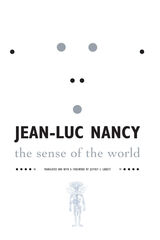 The Sense of the World
Nancy, Jean-Luc
University of Minnesota Press, 1998 An essential exploration of sense and meaning.
Is there a “world” anymore, let alone any “sense” to it? Acknowledging the lack of meaning in our time, and the lack of a world at the center of meanings we try to impose, Jean-Luc Nancy presents a rigorous critique of the many discourses-from philosophy and political science to psychoanalysis and art history-that talk and write their way around these gaping absences in our lives.
In an original style befitting his search for a new mode of thought, Nancy offers fragmentary readings of writers such as Nietzsche, Hegel, Marx, Lévinas, Lacan, Derrida, and Deleuze insofar as their work reflects his concern with sense and the world. Rather than celebrate or bemoan the loss of meaning or attempt to install a new one, his book seeks to reposition both sense and the world between the presence and absence of meaning, between objectivity and subjectivity. Nancy’s project entails a reconception of the field of philosophy itself, a rearticulation of philosophical practice. Neither recondite nor abstract, it is concerned with the existence and experience of freedom-the actuality of existence as experienced by contemporary communities of citizens, readers, and writers.
Combining aesthetic, political, and philosophical considerations to convey a sense of the world between meaning and reality, ideal content and material form, this book offers a new way of understanding-and responding to-“the end of the world.”
Jean-Luc Nancy teaches at the University of Human Sciences in Strasbourg. His books in English include The Literary Absolute (with Philip Lacoue-Labarthe, 1988), The Inoperative Community (Minnesota, 1991), The Birth to Presence (1993), The Experience of Freedom (1993), and The Muses (1996).
Jeffrey S. Librett is associate professor of modern languages and literatures at Loyola University of Chicago.
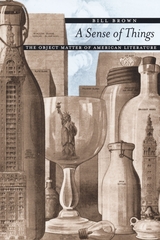 A Sense of Things: The Object Matter of American Literature
Bill Brown
University of Chicago Press, 2003 In May 1906, the Atlantic Monthly commented that Americans live not merely in an age of things, but under the tyranny of them, and that in our relentless effort to sell, purchase, and accumulate things, we do not possess them as much as they possess us. For Bill Brown, the tale of that possession is something stranger than the history of a culture of consumption. It is the story of Americans using things to think about themselves.
Brown's captivating new study explores the roots of modern America's fascination with things and the problem that objects posed for American literature at the turn of the century. This was an era when the invention, production, distribution, and consumption of things suddenly came to define a national culture. Brown shows how crucial novels of the time made things not a solution to problems, but problems in their own right. Writers such as Mark Twain, Frank Norris, Sarah Orne Jewett, and Henry James ask why and how we use objects to make meaning, to make or remake ourselves, to organize our anxieties and affections, to sublimate our fears, and to shape our wildest dreams. Offering a remarkably new way to think about materialism, A Sense of Things will be essential reading for anyone interested in American literature and culture.
A Sense of Urgency: How the Climate Crisis Is Changing Rhetoric
Debra Hawhee
University of Chicago Press, 2023 A study of how the climate crisis is changing human communication from a celebrated rhetorician.
Why is it difficult to talk about climate change? Debra Hawhee argues that contemporary rhetoric relies on classical assumptions about humanity and history that cannot conceive of the present crisis. How do we talk about an unprecedented future or represent planetary interests without privileging our own species? A Sense of Urgency explores four emerging answers, their sheer novelty a record of both the devastation and possible futures of climate change. In developing the arts of magnitude, presence, witness, and feeling, A Sense of Urgency invites us to imagine new ways of thinking with our imperiled planet.
Senseless Women
Sarah Harris Wallman
University of Massachusetts Press, 2020 Exploring the darker side of optimism, Sarah Harris Wallman's debut collection shows women attempting to build durable havens from reality, struggling to keep relationships intact, and reinventing themselves. A lonely music teacher at a Nashville Christian academy awaits the miracle of love; a Jane Doe recalls the affair that sustained, and ended, her; a new mother brings life into the world during a bleak election party; young girls are exploited by a nightclub owner in death, as in life. Alone or in weird sisterhood, some of these women are senseless because they refuse to feel, others because they've been deprived of stimuli and attention. As these twelve stories prove, there's no sensible way to fall in love, raise children, or escape. This is Senseless Women.
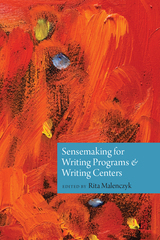 Sensemaking for Writing Programs and Writing Centers
Rita Malenczyk
Utah State University Press, 2023 In this collection writing program and writing center administrators from a range of academic institutions come together to explore their work through the lens of sensemaking. Sensemaking is an organizational theory concept that enables institutions, supervisors, teachers, tutors, and others to better understand the work they do by using narrative, metaphor, and other theoretical lenses.
The book is divided into two sections: Sensemaking with Tutors and Teachers, and Sensemaking and Institutional Structures. Chapter authors employ several theoretical approaches to sensemaking, ranging from individual experience to institutional history to document design, providing readers with ideas for how to administer and teach within their programs more effectively; how to advocate for their programs within larger university contexts; and how to positively influence the lives and careers of those they work with.
Sensemaking for Writing Programs and Writing Centers theorizes daily experiences from working lives and suggests problem-solving strategies. Writing program administrators, writing department chairs, and writing center directors, tutors, and staff will find value in its pages.
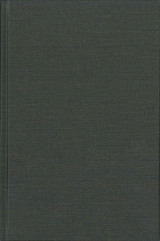 The Senses of Democracy: Perception, Politics, and Culture in Latin America
By Francine R. Masiello
University of Texas Press, 2018 In The Senses of Democracy, Francine R. Masiello traces a history of perceptions expressed in literature, the visual arts, politics, and history from the start of the nineteenth century to the present day. A wide transnational landscape frames the book along with an original and provocative thesis: when the discourse on democracy is altered—when nations fall into crisis or the increased weight of modernity tests minds and nerves—the representation of our sensing bodies plays a crucial role in explaining order and rebellion, cultural innovation, and social change. Taking a wide arc of materials—periodicals, memoirs, political proclamations, and travel logs, along with art installations and fiction—and focusing on the technologies that supplement and enhance human perception, Masiello looks at the evolution of what she calls “sense work” in cultural texts, mainly from Latin America, that wend from the heights of romantic thought to the startling innovations of modernism in the early twentieth century and then to times of posthuman experience when cyber bodies hurtle through globalized space and human senses are reproduced by machines. Tracing the shifting debates on perceptions, The Senses of Democracy offers a new paradigm with which to speak of Latin American cultural history and launches a field for the comparative study of bodies, experience, pleasure, and pain over the continental divide. In the end, sense work helps us to understand how culture finds its location.
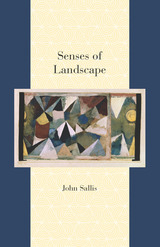 Senses of Landscape
John Sallis
Northwestern University Press, 2015 Beginning with the assertion that earth is the elemental place that grants an abode to humans and to other living things, in Senses of Landscape the philosopher John Sallis turns to landscapes, and in particular to their representation in painting, to present a powerful synthetic work. Senses of Landscape proffers three kinds of analyses, which, though distinct, continually intersect in the course of the book. The first consists of extended analyses of distinctive landscapes from four exemplary painters, Paul Cezanne, Caspar David Friedrich, Paul Klee, and Guo Xi. Sallis then turns to these artists’ own writings—treatises, essays, and letters—about art in general and landscape painting in particular, and he sets them into a philosophical context. The third kind of analysis draws both on Sallis’s theoretical writings and on the canonical texts in the philosophy of art (Kant, Schelling, Hegel, and Heidegger). These analyses present for a wide audience a profound sense of landscape and of the earthly abode of the human.
Senses of Style: Poetry before Interpretation
Jeff Dolven
University of Chicago Press, 2017 In an age of interpretation, style eludes criticism. Yet it does so much tacit work: telling time, telling us apart, telling us who we are. What does style have to do with form, history, meaning, our moment’s favored categories? What do we miss when we look right through it? Senses of Style essays an answer. An experiment in criticism, crossing four hundred years and composed of nearly four hundred brief, aphoristic remarks, it is a book of theory steeped in examples, drawn from the works and lives of two men: Sir Thomas Wyatt, poet and diplomat in the court of Henry VIII, and his admirer Frank O’Hara, the midcentury American poet, curator, and boulevardier. Starting with puzzle of why Wyatt’s work spoke so powerfully to O’Hara across the centuries, Jeff Dolven ultimately explains what we talk about when we talk about style, whether in the sixteenth century, the twentieth, or the twenty-first.
The Senses of Walden: An Expanded Edition
Stanley Cavell
University of Chicago Press, 1992 Stanley Cavell, one of America's most distinguished philosophers, has written an invaluable companion volume to Walden, a seminal book in our cultural heritage. This expanded edition includes two essays on Emerson.
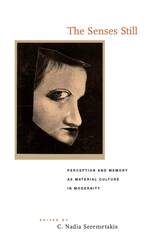 The Senses Still
C. Nadia Seremetakis
University of Chicago Press, 1996 What has happened to regional experiences that identify and shape culture? Regional foods are disappearing, cultures are dissolving, and homogeneity is spreading. Anthropologist and award-winning author of The Last Word: Women, Death, and Divination in Inner Mani, C. Nadia Seremetakis brings together essays by five scholars concerned with the senses and the anthropology of everyday life. Covering a wide range of topics—from film to food, from nationalism to the evening news—the authors describe ways in which sensory memories have preserved cultures otherwise threatened by urbanism and modernity.
The contributors are Susan Buck-Morss, Allen Feldman, Jonas Frykman, C. Nadia Seremetakis, and Paul Stoller.
C. Nadia Seremetakis is Advisor to the Minister of Public Health in Greece and visiting professor at the National School of Public Heath in Athens. She is the author of The Last Word: Women, Death, and Divination in Inner Mani, available from the University of Chicago Press.
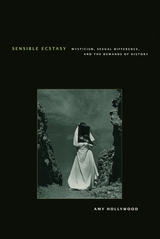 Sensible Ecstasy: Mysticism, Sexual Difference, and the Demands of History
Amy Hollywood
University of Chicago Press, 2001 Sensible Ecstasy investigates the attraction to excessive forms of mysticism among twentieth-century French intellectuals and demonstrates the work that the figure of the mystic does for these thinkers. With special attention to Georges Bataille, Simone de Beauvoir, Jacques Lacan, and Luce Irigaray, Amy Hollywood asks why resolutely secular, even anti-Christian intellectuals are drawn to affective, bodily, and widely denigrated forms of mysticism.
What is particular to these thinkers, Hollywood reveals, is their attention to forms of mysticism associated with women. They regard mystics such as Angela of Foligno, Hadewijch, and Teresa of Avila not as emotionally excessive or escapist, but as unique in their ability to think outside of the restrictive oppositions that continue to afflict our understanding of subjectivity, the body, and sexual difference. Mystics such as these, like their twentieth-century descendants, bridge the gaps between action and contemplation, emotion and reason, and body and soul, offering new ways of thinking about language and the limits of representation.
The Sensible Stage: Staging and the Moving Image
Edited by Bridget Crone
Intellect Books, 2017 Exploring the use of live performance and the moving image in contemporary art practice, The Sensible Stage brings together essays that examine how elements from theater and cinema are integrated into art, often in order to question the boundaries and mediations between the body and the image. Opening with a discussion between prominent philosopher Alain Badiou and Elie During, this book offers a unique mixture of theoretical, creative, and discursive reflections on the meeting of stage and screen.
This revised and expanded edition includes two new chapters that offer an updated look at how these ideas continue to develop in contemporary art practice.
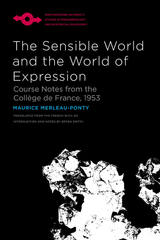 The Sensible World and the World of Expression: Course Notes from the Collège de France, 1953
Maurice Merleau-Ponty, Translated from the French with an introduction and notes by Bryan Smyth
Northwestern University Press, 2020 The Sensible World and the World of Expression was a course of lectures that Merleau-Ponty gave at the Collège de France after his election to the chair of philosophy in 1952. The publication and translation of Merleau-Ponty’s notes from this course provide an exceptional view into the evolution of his thought at an important point in his career.
In these notes, we see that Merleau-Ponty’s consideration of the problem of the perception of movement leads him to make a self-critical return to Phenomenology of Perception in order to rethink the perceptual encounter with the sensible world as essentially expressive, and hence to revise his understanding of the body schema accordingly in terms of praxical motor possibilities. Sketching out an embodied dialectic of expressive praxis that would link perception with art, language, and other cultural and intersubjective phenomena, up to and including truth, Merleau-Ponty’s notes for these lectures thus afford an exciting glimpse of how he aspired to overcome the impasse of ontological dualism.
Situated midway between Phenomenology of Perception and The Visible and the Invisible, these notes mark a juncture of crucial importance with regard to Merleau-Ponty’s later efforts to work out the ontological underpinnings of phenomenology in terms of a new dialectical conception of nature and history.
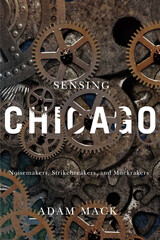 Sensing Chicago: Noisemakers, Strikebreakers, and Muckrakers
Adam Mack
University of Illinois Press, 2015 A hundred years ago and more, a walk down a Chicago street invited an assault on the senses. Untiring hawkers shouted from every corner. The manure from thousands of horses lay on streets pooled with molasses and puddled with kitchen grease. Odors from a river gelatinous and lumpy with all manner of foulness mingled with the all-pervading stench of the stockyard slaughterhouses. In Sensing Chicago, Adam Mack lets fresh air into the sensory history of Chicago in the nineteenth and early twentieth centuries by examining five case studies: the Chicago River, the Great Fire, the 1894 Pullman Strike, the publication of Upton Sinclair's The Jungle, and the rise and fall of the White City amusement park. His vivid recounting of the smells, sounds, and tactile miseries of city life reveals how input from the five human senses influenced the history of class, race, and ethnicity in the city. At the same time, he transports readers to an era before modern refrigeration and sanitation, when to step outside was to be overwhelmed by the odor and roar of a great city in progress.
 Sensing Health: Bodies, Data, and Digital Health Technologies
Mikki Kressbach
University of Michigan Press, 2024 In the age of Apple Watches and Fitbits, the concept of “health” emerges through an embodied experience of a digital health device or platform, not simply through the biomedical data it provides. Sensing Health: Bodies, Data, and Digital Health Technologies analyzes popular digital health technologies as aesthetic experiences to understand how these devices and platforms have impacted the way individuals perceive their bodies, behaviors, health, and well-being. By tracing design alongside embodied experiences of digital health, Kressbach shows how these technologies aim to quantify, track and regulate the body, while at the same time producing moments that bring the body’s affordances and relationship to the fore. This mediated experience of “health” may offer an alternative to biomedical definitions that define health against illness.
To capture and analyze digital health experiences, Kressbach develops a method that combines descriptive practices from Film and Media Studies and Phenomenology. After examining the design and feedback structures of digital health platforms and devices, the author uses her own first-person accounts to analyze the impact of the technology on her body, behaviors, and perception of health. Across five chapters focused on different categories of digital health—menstrual trackers, sexual wellness technologies, fitness trackers, meditation and breathing technologies, and posture and running wearables—Sensing Health demonstrates a method of analysis that acknowledges and critiques the biomedical structures of digital health technology while remaining attentive to the lived experiences of users. Through a focus on the intersection of technological design and experience, this method can be used by researchers, scholars, designers, and developers alike.
Sensing Qualia: Solving the Hard Problem of Consciousness
Paul G. Skokowski
University of Chicago Press A new, naturalistic theory of consciousness and sensory experience.
Philosophers of mind and neuroscientists often debate what they call the hard problem of consciousness, that is, how we might account for qualia—our subjective experiences of phenomena like color, taste, pain, smell, and more. In Sensing Qualia, Paul G. Skokowski surveys the most influential theories of mind since Descartes in order to establish a new theory he calls sensory naturalism, which recognizes the senses as natural detectors of physical properties in the world.
Drawing on neuroscience, physics, and philosophy, Skokowski provides a naturalistic framework for studying qualia in the physical world and explores the limits of qualia in androids and AI. The result is a compelling explanation of qualia for anyone curious about the nature of conscious experience in humans and AI.
 Sensing Sound: Singing and Listening as Vibrational Practice
Nina Sun Eidsheim
Duke University Press, 2016 In Sensing Sound Nina Sun Eidsheim offers a vibrational theory of music that radically re-envisions how we think about sound, music, and listening. Eidsheim shows how sound, music, and listening are dynamic and contextually dependent, rather than being fixed, knowable, and constant. She uses twenty-first-century operas by Juliana Snapper, Meredith Monk, Christopher Cerrone, and Alba Triana as case studies to challenge common assumptions about sound—such as air being the default medium through which it travels—and to demonstrate the importance a performance's location and reception play in its contingency. By theorizing the voice as an object of knowledge and rejecting the notion of an a priori definition of sound, Eidsheim releases the voice from a constraining set of fixed concepts and meanings. In Eidsheim's theory, music consists of aural, tactile, spatial, physical, material, and vibrational sensations. This expanded definition of music as manifested through material and personal relations suggests that we are all connected to each other in and through sound. Sensing Sound will appeal to readers interested in sound studies, new musicology, contemporary opera, and performance studies.
 Sensing the City through Television: Urban Identities in Fictional Drama
Peter Billingham
Intellect Books, 2000 How do fictional representations of the city contribute to our sense of identity? Does this feed back into how we see cities and their cultures? This in-depth analysis with five case studies provides the basis for a critique on the political, sociological and cultural implications of this strand of popular programming. The book features: Queer as Folk The Cops Holding On Homicide-Life on the Street Armistead Maupin's Tales of the City Each programme is discussed in terms of structure, content, characterisation, and narrative, and each is placed within a specific ideological context. The case studies represent a broad range of British and American cities and city sub-cultures, while the book draws on the author's exclusive interviews with Tony Garnett, Tony Marchant, and David Snodin. The author further extends his analysis to investigate the intrinsic issues related to the implications of popular and high drama and culture. As one of the first substantial investigations of the city in television drama, this book reflects and contributes to a growing general interest in the politics of representation. This is suitable for accommodation into the popular academic courses on drama and film/media studies both as a textbook and for supplementary reading.
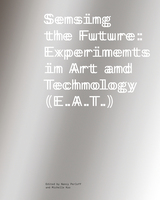 Sensing the Future: Experiments in Art and Technology (E.A.T.)
Nancy Perloff
J. Paul Getty Trust, The, 2024 In the 1960s and '70s, collaborations between artists and engineers led to groundbreaking innovations in multisensory performance art that continue to resonate today.
In 1966, Billy Klüver and Fred Waldhauer, engineers at Bell Labs in Murray Hill, New Jersey, teamed up with artists Robert Rauschenberg and Robert Whitman to form a nonprofit organization, Experiments in Art and Technology (E.A.T.). E.A.T.’s debut event, 9 Evenings: Theatre & Engineering, integrated art, theater, and groundbreaking technology in a series of performances at the 69th Regiment Armory in Manhattan. Its second major event, the Pepsi Pavilion at Expo ’70 in Osaka, Japan, presented a multisensory environment for the first world exposition held in Asia. At these events, and in the hundreds of collaborations E.A.T. facilitated in between, the participants—including John Cage, Lucinda Childs, Deborah Hay, Steve Paxton, Yvonne Rainer, and David Tudor—imagined innovative ways for art and science to intersect and enrich society.
Sensing the Future tells the story of these collaborations between artists and engineers and how they led to new installations and technology-based artworks. Through the examination of films, photographs, diagrams, and artists’ records from the E.A.T. archive at the Getty Research Institute, this volume provides a new perspective on multimedia art in the 1960s and ’70s and highlights the ways E.A.T. pushed the role of the artist beyond the traditional art world.
This volume is published to accompany an exhibition on view at the Getty Research Institute at the Getty Center from September 10, 2024, to February 23, 2025.
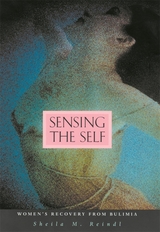 Sensing the Self: Women's Recovery from Bulimia
Sheila M. Reindl
Harvard University Press, 2001 Hearing about the destructive compulsion of bulimia nervosa, outsiders may wonder, "How could you ever start?" Those suffering from the eating disorder ask themselves in despair, "How can I ever stop?" How do you break the cycle of bingeing, vomiting, laxative abuse, and shame? While many books describe the descent into eating disorders and the resulting emotional and physical damage, this book describes recovery.
Psychologist Sheila Reindl has listened intently to women's accounts of recovering. Reindl argues compellingly that people with bulimia nervosa avoid turning their attention inward to consult their needs, desires, feelings, and aggressive strivings because to do so is to encounter an annihilating sense of shame. Disconnected from internal, sensed experience, bulimic women rely upon external gauges to guide their choices. To recover, bulimic women need to develop a sense of self--to attune to their physical, psychic, and social self-experience. They also need to learn that one's neediness, desire, pain, and aggression are not sources of shame to be kept hidden but essential aspects of humanity necessary for zestful life. The young women with whom Reindl speaks describe, with great feeling, their efforts to know and trust their own experience.
Perceptive, lucid, and above all humane, this book will be welcomed not only by professionals but by people who struggle with an eating disorder and by those who love them.
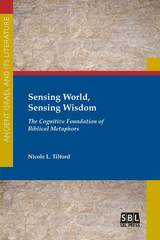 Sensing World, Sensing Wisdom: The Cognitive Foundation of Biblical Metaphors
Nicole L. Tilford
SBL Press, 2017 Examine new insights into the conceptual worldview of biblical
wisdom communities
The Bible is full of metaphors. On the surface, these metaphors seem like simple literary flourishes that have been added to the text for artistic effect. This book, however, argues that biblical metaphors reflect more basic, prelinguistic cognitive structures. These conceptual metaphors developed out of common concrete experiences and only gradually developed into the complex metaphors that one finds within biblical texts. This book explores how common sensory activities like seeing, hearing, touching, eating, breathing, and walking developed into the abstract metaphors for wisdom that one finds in Proverbs, Job, and Qohelet. Because it traces the cognitive development of a set of related metaphors across several congruent texts, it provides a model by which scholars can trace the cognitive development of biblical metaphors more generally in the Hebrew Bible and other early Jewish and Christian texts.
Features:
- A synthesis of conceptual metaphor theory that provides a workable theory for examining biblical texts
- An analytical framework for studying sensory experience and sensory metaphors in biblical texts
- Diagrams
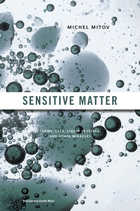 Sensitive Matter: Foams, Gels, Liquid Crystals, and Other Miracles
Michel Mitov
Harvard University Press, 2012 Life would not exist without sensitive, or soft, matter. All biological structures depend on it, including red blood globules, lung fluid, and membranes. So do industrial emulsions, gels, plastics, liquid crystals, and granular materials. What makes sensitive matter so fascinating is its inherent versatility. Shape-shifting at the slightest provocation, whether a change in composition or environment, it leads a fugitive existence.
Physicist Michel Mitov brings drama to molecular gastronomy (as when two irreconcilable materials are mixed to achieve the miracle of mayonnaise) and offers answers to everyday questions, such as how does paint dry on canvas, why does shampoo foam better when you “repeat,” and what allows for the controlled release of drugs? Along the way we meet a futurist cook, a scientist with a runaway imagination, and a penniless inventor named Goodyear who added sulfur to latex, quite possibly by accident, and created durable rubber.
As Mitov demonstrates, even religious ritual is a lesson in the surprising science of sensitive matter. Thrice yearly, the reliquary of St. Januarius is carried down cobblestone streets from the Cathedral to the Church of St. Clare in Naples. If all goes as hoped—and since 1389 it often has—the dried blood contained in the reliquary’s largest vial liquefies on reaching its destination, and Neapolitans are given a reaffirming symbol of renewal.
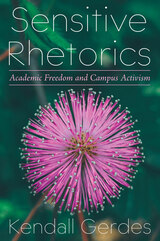 Sensitive Rhetorics: Academic Freedom and Campus Activism
Kendall Gerdes
University of Pittsburgh Press, 2024 Claims that students are too sensitive are familiar on and around college campuses. The ideas of cancel culture, safe spaces, and political correctness are used to shut down discussion and prevent students from being recognized as stakeholders in higher education and as advocates for their own interests. Further, universities can claim that student activists threaten academic freedom. In Sensitive Rhetorics, Kendall Gerdes puts these claims and common beliefs into conversation with rhetorical theory to argue that critiques of sensitivity reveal a deep societal discomfort with the idea that language is a form of action. Gerdes poses important questions: What kind of harm can language and representation actually do, and how? What responsibilities do college and university teachers bear toward their students? Sensitive Rhetorics explores the answers by surfacing submerged assumptions about higher education, the role of instructors and faculty, and the needs of an increasingly diverse student body.
Sensorimotor Integration
Edited by Carl Gans and Philip S. Ulinski
University of Chicago Press, 1992 The third of a planned group of volumes dealing with reptilian nervous systems, Sensorimotor Integration focuses chiefly on visual and sensorimotor aspects of reptilian neurobiology. Chapters examine data for numerous species, drawing together the most current work and thinking on each topic and emphasizing results from recent studies.
"This volume would be a valuable addition to any comparative anatomist's bookshelf, and one that should be of great interest to comparative neurobiologists and neuroanatomists alike."—Katherine V. Fite, Quarterly Review of Biology
Sensors, Actuators, and their Interfaces: A multidisciplinary introduction
Nathan Ida
The Institution of Engineering and Technology, 2014 As sensors and actuators are normally not (and have not been) treated in academic curricula as a subject in its own right; many students and current professionals often find themselves limited in their knowledge and dealing with topics and issues based on material they may have never encountered. Until now.
Sensors, Actuators, and Their Interfaces: A multidisciplinary introduction
Nathan Ida
The Institution of Engineering and Technology, 2020 Sensors and actuators are used daily in countless applications to ensure more accurate and reliable workflows and safer environments. Many students and young engineers with engineering and science backgrounds often come prepared with circuits and programming skills but have little knowledge of sensors and sensing strategies and their interfacing.
Sensors for Ranging and Imaging
Graham Brooker
The Institution of Engineering and Technology, 2022 Sensors for Ranging and Imaging is a comprehensive textbook and professional reference that provides a solid background in active sensing technology. This new edition has been comprehensively updated and expanded to include the latest radar technologies.
Sensors in the Age of the Internet of Things: Technologies and applications
Octavian Adrian Postolache
The Institution of Engineering and Technology, 2019 The IoT is the inter-networking of connected and smart devices, buildings, vehicles and other items which are embedded with electronics, software, sensors, actuators, and network connectivity that enable these objects to collect and exchange data. A sensor is a detection device that measures, records, or responds to a physical property. Sensors represent the front end of information processing. Progress in communication technologies is part of the multi-factorial advances in electronics, sensors, embedded computing, signal processing and machine learning methods that has led to the development of new capabilities in the IoT.
 The Sensory Child of Contemporary Cinema: Sight, Sound, Touch
Nonie May
Amsterdam University Press, 2025 The Sensory Child: Sight, Sound, Touch examines a poetic film form evident in contemporary cinema that seems intent on capturing the textures, the materials, and the sensations of childhood. These films foreground the child’s point of view, construct a child’s gaze, and mobilise an aesthetic that evokes a sensory recollection of childhood. This complex arrangement of aesthetic modes is intended to address the adult spectator bodily, and evoke the vivid, sensory memories of childhood. The Sensory Child rethinks a gap in contemporary film theory created by a seeming hiatus between psychoanalytic and phenomenological approaches to the cinema. The book examines key instances of this aesthetic of childhood in the films Aftersun (2022), The Fits (2015), What Maisie Knew (2013), and Moonlight (2016). May argues that psychoanalytic theory can elucidate the significance of such tactile moments, offering insight into the meaning evoked for the spectator by this sensory, poetic film form.
 Sensory Design
Joy Monice Malnar
University of Minnesota Press, 2004 What if we designed for all of our senses? Suppose for a moment that sound, touch, and odor were treated as the equals of sight, and emotion considered as important as cognition. What would our built environment be like if sensory response, sentiment, and memory were critical design factors, the equals of structure and program? In Sensory Design, Joy Monice Malnar and Frank Vodvarka explore the nature of our responses to spatial constructs—from various sorts of buildings to gardens and outdoor spaces, to constructions of fantasy. To the degree that this response can be calculated, it can serve as a typology for the design of significant spaces, one that would sharply contrast with the Cartesian model that dominates architecture today.In developing this typology, the authors consult the environmental sciences, anthropology, psychology, and architectural theory, as well as the spatial analysis found in literary depiction. Finally, they examine the opportunities that CAVE™ and other immersive virtual reality technologies present in furthering a new, sensory-oriented design paradigm. The result is a new philosophy of design that both celebrates our sensuous occupation of the built environment and creates more humane design.Joy Monice Malnar, AIA, is associate professor of architecture at the University of Illinois, Urbana-Champaign. Frank Vodvarka is associate professor of fine arts at Loyola University Chicago. They are coauthors of The Interior Dimension: A Theoretical Approach to Enclosed Space (1992).
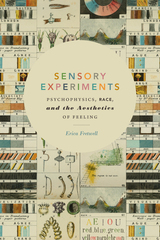 Sensory Experiments: Psychophysics, Race, and the Aesthetics of Feeling
Erica Fretwell
Duke University Press, 2020 In Sensory Experiments, Erica Fretwell excavates the nineteenth-century science of psychophysics and its theorizations of sensation to examine the cultural and aesthetic landscape of feeling in nineteenth-century America. Fretwell demonstrates how psychophysics—a scientific movement originating in Germany and dedicated to the empirical study of sensory experience—shifted the understandings of feeling from the epistemology of sentiment to the phenomenological terrain of lived experience. Through analyses of medical case studies, spirit photographs, perfumes, music theory, recipes, and the work of canonical figures ranging from Kate Chopin and Pauline Hopkins to James Weldon Johnson and Emily Dickinson, Fretwell outlines how the five senses became important elements in the biopolitical work of constructing human difference along the lines of race, gender, and ability. In its entanglement with social difference, psychophysics contributed to the racialization of aesthetics while sketching out possibilities for alternate modes of being over and against the figure of the bourgeois liberal individual. Although psychophysics has largely been forgotten, Fretwell demonstrates that its importance to shaping social order through scientific notions of sensation is central to contemporary theories of new materialism, posthumanism, aesthetics, and affect theory.
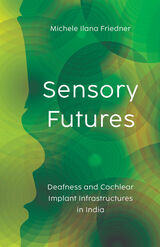 Sensory Futures: Deafness and Cochlear Implant Infrastructures in India
Michele Ilana Friedner
University of Minnesota Press, 2022 Revealing inequalities and sensory hierarchies embedded in the latest medical technologies and global biotechnical markets What happens when cochlear implants, heralded as the first successful bionic technologies, make their way around the globe and are provided by both states and growing private markets? As Sensory Futures follows these implants from development to domestication and their unequal distribution in India, Michele Ilana Friedner explores biotechnical intervention in the realm of disability and its implications for state politics in the Global South. A signing and speaking deaf bilateral cochlear implant user, Friedner weaves personal reflections into this fine-grained ethnography of everyday negotiations, activist aspirations, and the space of the family. She places sensory anthropology in conversation with disability studies to analyze how normative sensoria are cultivated and the pursuit of listening and speaking capability is enacted. She argues that the conditions of potentiality that have emerged through cochlear implantation have, in fact, resulted in ever narrower understandings of future life possibilities. Rejecting sensory hierarchies that privilege audition, Friedner calls for multisensory, multimodal, and multipersonal ways of relating to the world. Sensory Futures explores deaf people’s desires to create habitable worlds and grapple with what their futures might look like, in India and beyond, amid a surge in both biotechnical interventions and disability rights activism. With implications for a broad range of disability experiences, this sensitive, in-depth research focuses on the specific experiences of deaf people, both children and adults, and the structural, political, and social possibilities offered by both biotechnological and social “cures.”
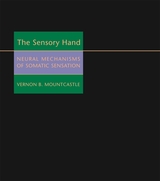 The Sensory Hand: Neural Mechanisms of Somatic Sensation
Vernon B. Mountcastle
Harvard University Press, 2005 The hand is an organ of considerable capability. With it we feel, point, and reach, we determine the texture and shape of objects we palpate, we emit and receive signs of approval, compassion, condolence, and encouragement, and, on a different register, rejection, threat, dislike, antagonism, and attack.
Vernon Mountcastle has devoted his career to studying the neurophysiology of sensation--the extended sensory surface, consisting of skin and subcutaneous tissue--in the hand. In The Sensory Hand Mountcastle provides an astonishingly comprehensive account of the neural underpinnings of the rich and complex tactile experiences evoked by stimulation of the hand. Mountcastle focuses attention on the nerve pathways linking the hand to central neural structures, structures that play a role in several other aspects of somatic sensation. His new book thus becomes a sequel to his earlier volume, Perceptual Neuroscience, in which he offered a detailed analysis of the role of the distributed systems of the neocortex in perception generally.
Written by one of the giants of modern neuroscience and the first single-authored book-length treatment of the subject, The Sensory Hand is a major work of scholarship that will be essential reading for anyone interested in how the brain registers sensation and perception.
The Sensory Order: An Inquiry into the Foundations of Theoretical Psychology
F. A. Hayek
University of Chicago Press, 1952 The Sensory Order, first published in 1952, sets forth F. A. Hayek's classic theory of mind in which he describes the mental mechanism that classifies perceptions that cannot be accounted for by physical laws. Hayek's substantial contribution to theoretical psychology has been addressed in the work of Thomas Szasz, Gerald Edelman, and Joaquin Fuster.
"A most encouraging example of a sustained attempt to bring together information, inference, and hypothesis in the several fields of biology, psychology, and philosophy."—Quarterly Review of Biology
F. A. Hayek (1899-1992), recipient of the Medal of Freedom in 1991 and co-winner of the Nobel Memorial Prize in Economics in 1974, taught at the University of London, the University of Chicago, and the University of Freiburg.
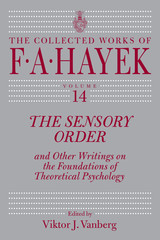 The Sensory Order and Other Writings on the Foundations of Theoretical Psychology
F. A. Hayek
University of Chicago Press, 2017 F. A. Hayek (1899–1992) was one of the leading voices in economic and social theory, but he also wrote on theoretical psychology, including in the landmark book The Sensory Order. Although The Sensory Order was not widely engaged with by either psychologists or social scientists at the time of publication, it is seen today as essential for fully understanding Hayek’s more well-known work.
The latest addition to the University of Chicago Press’s Collected Works of F. A. Hayek series, The Sensory Order and Other Writings on the Foundations of Theoretical Psychology pairs the book, originally published in 1952, with additional essays related to The Sensory Order’s key themes, including a student paper from 1920 in which Hayek outlined the basic ideas he fully developed in the 1952 book. Rounding out the volume is an insightful introduction by editor Viktor Vanberg that sketches out the central problems Hayek was grappling with when he wrote The Sensory Order and the influential role this early thinking on theoretical psychology would play over the next six decades of his career. The book also features ample footnotes and citations for further reading, making this an essential contribution to the series.
Sensory Systems for Robotic Applications
Ravinder Dahiya
The Institution of Engineering and Technology, 2022 Robots have come a long way thanks to advances in sensing and computer vision technologies and can be found today in healthcare, medicine and industry. Researchers have been looking at providing them with senses such as the ability to see, smell, hear and perceive touch in order to mimic and interact with humans and their surrounding environments.
Sensual Relations: Engaging the Senses in Culture and Social Theory
David Howes
University of Michigan Press, 2003 With audacious dexterity, David Howes weaves together topics ranging from love and beauty magic in Papua New Guinea to nasal repression in Freudian psychology and from the erasure and recovery of the senses in contemporary ethnography to the specter of the body in Marx. Through this eclectic and penetrating exploration of the relationship between sensory experience and cultural expression, Sensual Relations contests the conventional exclusion of sensuality from intellectual inquiry and reclaims sensation as a fundamental domain of social theory.
David Howes is Professor of Anthropology, Concordia University, Montreal, Quebec.
 The Sensuous Cinema of Wong Kar-wai: Film Poetics and the Aesthetic of Disturbance, Second Edition
Gary Bettinson
Hong Kong University Press, 2025 More than just mood: how Wong Kar-wai reshapes storytelling through sensation and style.
The widely acclaimed films of Wong Kar-wai are characterized by their sumptuous yet complex visual and sonic style. This study of Wong’s filmmaking techniques uses a poetics approach to examine how form, music, narration, characterization, genre, and other artistic elements work together to produce certain effects on audiences. Bettinson argues that Wong’s films are permeated by an aesthetic of sensuousness and “disturbance” achieved through techniques such as narrative interruptions, facial masking, opaque cuts, and other complex strategies. The effect is to jolt the viewer out of complete aesthetic absorption. Each of the chapters focuses on a single aspect of Wong’s filmmaking.
This tenth-anniversary edition of The Sensuous Cinema of Wong Kar-wai includes a substantial new afterword bringing the story of Wong’s career up to date (including reflections on the Mainland Chinese drama Blossoms Shanghai). Bettinson revisits and extends the arguments of the first edition, surveys the recent key debates on Wong’s filmmaking, and introduces fresh lines of critical investigation. The book will appeal to all who are interested in authorship and aesthetics in film studies, to scholars in Asian studies, media, and cultural studies, and to anyone with an interest in Hong Kong cinema in general, and Wong’s films in particular.
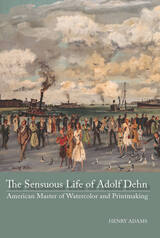 The Sensuous Life of Adolf Dehn: American Master of Watercolor and Printmaking
Henry Adams
University of Missouri Press, 2020 Adolf Dehn belongs to a group of distinguished midcentury American artists who were eclipsed by Abstract Expressionism and the following movements in American art. His lithographs of the Roaring Twenties introduced a note of social satire into American printmaking. He was one of the most gifted and innovative printmakers of the American Scene movement of the 1930s and one of the most significant American watercolorists.
In this wide-ranging biography, Henry Adams explores how a once central figure can come to be forgotten. Noting that Dehn’s watercolor Spring in Central Park has been widely reproduced on calendars, postcards, and other Metropolitan Museum of Art souvenirs, Adams asks why it is that some artists are celebrated as key figures while others, even those who created images that form an integral part of our visual culture, are relatively unknown. With his account of the life of the prolific and influential Dehn, and a look at the circles of artists and writers in which Dehn moved, Adams helps to fill in what he calls the “secret or subterranean history of art.”
 Sensus Communis: Vico, Rhetoric, and the Limits of Relativism
John D. Schaeffer
Duke University Press, 1990 The concept sensus communis—a term that means a great deal more than its English translation “common sense”—has served as a key principle in the theory of knowledge from the ancient Greeks through the Enlightenment philosophers. John D. Schaeffer shows how the seventeenth-century Italian philosopher Giambattista Vico synthesized Greek and Roman ideas of what sensus communis and what this synthesis implies for current discussions of rhetoric and hermeneutics. Arguments for ethical relativism emerge from divisions between sensus communis as an ethical judgment (a concept that Richard Rorty, Richard Bernstein, and others have tried to rescue) and as a linguistic consensus, a division against which Vico argued and which his own concept of sensus communis attempted to reconcile.
In extended commentaries on Gadamer, the Gadamer/Habermas debate, and Derrida, Schaeffer shows that Vico offers the possibility of analyzing social phenomena and constellations of power from within the humanist rhetorical tradition. Vico’s achievements have powerful implications for relating ethics and hermeneutics to the world of concrete social practice, particularly in an age in which the electronic media have replaced print as the primary means of communication and in which a “secondary orality” (a cast of mind similar to that of nonliterate peoples) is appearing within our literate civilization.
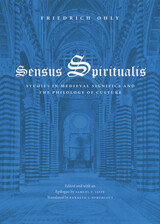 Sensus Spiritualis: Studies in Medieval Significs and the Philology of Culture
Friedrich Ohly
University of Chicago Press, 2005 Of the major figures in medieval studies, there are few whose influence is greater and for whom admiration is more widespread than Friedrich Ohly (1914-96). This book represents the long-awaited English-language edition of Ohly's most important writings.
Drawn from the entire career of this great medievalist, who, more clearly and in greater detail than anyone before him, articulated the singularly allegorical mentality of the Middle Ages, the essays in this collection show the tendency of medieval thinkers and writers to see nature as a diaphanous screen held against God's sacred mysteries, simultaneously illuminating and obscuring. Ohly's work on the hermeneutics of word and image, meanwhile, traces the way his thinking opened philology to new possibilities through the dual interpretation of textual and visual media.
Including penetrating essays on poetic inspiration, the nature of beauty, sacred and profane exegesis, history as typology, and art as both object and text, this volume will be of enormous value to scholars of comparative literature, the history of art, and religion during the Middle Ages and Renaissance.
Sentences
Howard Nemerov
University of Chicago Press, 1980 In Sentences, contemporary poet Howard Nemerov adds to his distinguished work a collection of gnomic verses, declarative poems, sonnets after other poets, and sustained lyrics.
"In [Sentences], not only has Nemerov continued to accommodate himself to the literary tradition without falling back on parody; he has also . . . extended the resources of blank verse beyond what any modern practitioner, himself included, has managed to. This extension comprises more than a mere prosodic advance; it is a rhetorical and imaginative advance. 'By Al Lebowitz's Pool,' 'The Makers,' 'Monet,' and 'A Christmas Storm,' for example, are dazzling in their very naturalness. . . . No one since Frost has done as much to move blank verse from where Wordsworth and Coleridge had left it."—Mary Kinzie, Poetry
The Sentences of Sextus
Walter T. Wilson
SBL Press, 2012 Described by Origen as a writing that “even the masses of believers have read,” the Sentences of Sextus offers unique insights into popular Christian thought during the late second century C.E. Although it draws extensively on canonical texts for the composition of its sayings, it is especially fascinating for the manner in which it integrates these texts with material derived from two generically similar collections of Pythagorean maxims. This volume provides a critical edition including evidence from the Greek, Latin, Syriac, and Coptic versions; a new translation; and the first commentary for the Sentences, an important document for investigating the history of early Christian wisdom, asceticism, and ethics.
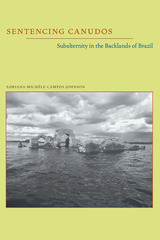 Sentencing Canudos: Subalternity in the Backlands of Brazil
Adriana Michele Campos Johnson
University of Pittsburgh Press, 2010
In the late nineteenth century, the Brazilian army staged several campaigns against the settlement of Canudos in northeastern Brazil. The colony’s residents, primarily disenfranchised former slaves, mestizos, landless farmers, and uprooted Indians, followed a man known as Antonio Conselheiro (“The Counselor”), who promoted a communal existence, free of taxes and oppression. To the fledgling republic of Brazil, the settlement represented a threat to their system of government, which had only recently been freed from monarchy. Estimates of the death toll at Canudos range from fifteen thousand to thirty thousand.
Sentencing Canudos offers an original perspective on the hegemonic intellectual discourse surrounding this monumental event in Brazilian history. In her study, Adriana Michele Campos Johnson offers a close examination of nation building and the silencing of “other” voices through the reinvisioning of history. Looking primarily to Euclides da Cunha’s Os Sertões, which has become the defining—and nearly exclusive—account of the conflict, she maintains that the events and people of Canudos have been “sentenced” to history by this work. Johnson investigates other accounts of Canudos such as local oral histories, letters, newspaper articles, and the writings of Cunha’s contemporaries, Afonso Arinos and Manoel Benício, in order to strip away political agendas. She also seeks to place the inhabitants and events of Canudos within the realm of “everydayness” by recalling aspects of daily life that have been left out of official histories.
Johnson analyzes the role of intellectuals in the process of culture and state formation and the ensuing sublimation of subaltern histories and populations. She echoes recent scholarship that posits subalternity as the product of discourse that must be disputed in order to recover cultural identities and offers a view of Canudos and postcolonial Latin America as a place to think from, not about.
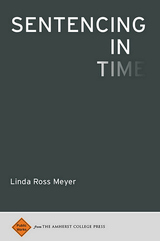 Sentencing in Time
Linda Ross Meyer
Amherst College Press, 2017 Exactly how is it we think the ends of justice are accomplished by sentencing someone to a term in prison? How do we relate a quantitative measure of time—months and years—to the objectives of deterring crime, punishing wrongdoers, and accomplishing justice for those touched by a criminal act? Linda Ross Meyer investigates these questions, examining the disconnect between our two basic modes of thinking about time—chronologically (seconds, minutes, hours), or phenomenologically (observing, taking note of, or being aware of the passing of time). In Sentencing in Time, Meyer asks whether—in overlooking the irreconcilability of these two modes of thinking about time—we are failing to accomplish the ends we believe the criminal justice system is designed to serve. Drawing on work in philosophy, legal theory, jurisprudence, and the history of penology, Meyer explores how, rather than condemning prisoners to an experience of time bereft of meaning, we might instead make the experience of incarceration constructively meaningful—and thus better aligned with social objectives of deterring crime, reforming offenders, and restoring justice.
 Sentencing without Guidelines
Rhys Hester
Temple University Press, 2024 Sentencing matters. Reform initiatives hope to impart more uniformity and fairness in sentencing. Tough-on-crime laws like “three strikes” and mandatory minimum provisions deprive judges of sentencing discretion. While sentencing guidelines have been adopted by approximately 20 states since the early 1980s, many judges operate without guidelines.
Sentencing without Guidelines is Rhys Hester’s deep dive into how South Carolina, which never passed sentencing guideline legislation, nonetheless created meaningful punishment reform. It achieved uniformity in sentencing with a traveling circuit of judges, informal norms among judges, and the unique phenomenon of the “Plea Judge” to manage cases.
Hester examines how prior convictions, race, and geographical differences impact sentences to explain why individuals get the criminal sentences they do. He also explores how legal reform mechanisms can influence punishment goals and policy. Sentencing without Guidelines shows the benefits and drawbacks South Carolina experienced as it met sentencing reform goals. These lessons can be translated into policy for other jurisdictions.
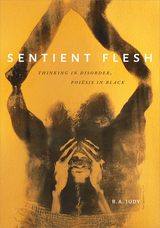 Sentient Flesh: Thinking in Disorder, Poiesis in Black
R. A. Judy
Duke University Press, 2020 In Sentient Flesh R. A. Judy takes up freedman Tom Windham’s 1937 remark “we should have our liberty 'cause . . . us is human flesh" as a point of departure for an extended meditation on questions of the human, epistemology, and the historical ways in which the black being is understood. Drawing on numerous fields, from literary theory and musicology, to political theory and phenomenology, as well as Greek and Arabic philosophy, Judy engages literary texts and performative practices such as music and dance that express knowledge and conceptions of humanity appositional to those grounding modern racialized capitalism. Operating as critiques of Western humanism, these practices and modes of being-in-the-world—which he theorizes as “thinking in disorder,” or “poiēsis in black”—foreground the irreducible concomitance of flesh, thinking, and personhood. As Judy demonstrates, recognizing this concomitance is central to finding a way past the destructive force of ontology that still holds us in thrall. Erudite and capacious, Sentient Flesh offers a major intervention in the black study of life.
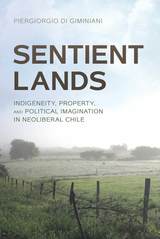 Sentient Lands: Indigeneity, Property, and Political Imagination in Neoliberal Chile
Piergiorgio Di Giminiani
University of Arizona Press, 2018 In 1990, when Augusto Pinochet’s 17-year military dictatorship ended, democratic rule returned to Chile. Since then, Indigenous organizations have mobilized to demand restitution of their ancestral territories seized over the past 150 years.
Sentient Lands is a historically grounded ethnography of the Mapuche people’s engagement with state-run reconciliation and land-restitution efforts. Piergiorgio Di Giminiani analyzes environmental relations, property, state power, market forces, and indigeneity to illustrate how land connections are articulated, in both landscape experiences and land claims. Rather than viewing land claims as simply bureaucratic procedures imposed on local understandings and experiences of land connections, Di Giminiani reveals these processes to be disputed practices of world making.
Ancestral land formation is set in motion by the entangled principles of Indigenous and legal land ontologies, two very different and sometimes conflicting processes. Indigenous land ontologies are based on a relation between two subjects—land and people—both endowed with sentient abilities. By contrast, legal land ontologies are founded on the principles of property theory, wherein land is an object of possession that can be standardized within a regime of value. Governments also use land claims to domesticate Indigenous geographies into spatial constructs consistent with political and market configurations.
Exploring the unexpected effects on political activism and state reparation policies caused by this entanglement of Indigenous and legal land ontologies, Di Giminiani offers a new analytical angle on Indigenous land politics.
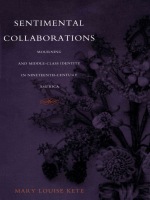 Sentimental Collaborations: Mourning and Middle-Class Identity in Nineteenth-Century America
Mary Louise Kete
Duke University Press, 2000 During the 1992 Democratic Convention and again while delivering Harvard University’s commencement address two years later, Vice President Al Gore shared with his audience a story that showed the effect of sentiment in his life. In telling how an accident involving his son had provided him with a revelation concerning the compassion of others, Gore effectively reconstructed himself as a typical, middle-class American for whom sympathy can lead to salvation. This contemporary reiteration of mid-nineteenth-century American sentimental discourse proves to be a fruitful point of departure for Mary Louise Kete’s argument that sentimentality has been an important and recurring form of cultural narrative that has helped to shape middle-class American life.
Many scholars have written about the sentimental novel as a primarily female genre and have stressed its negative ideological aspects. Kete finds that in fact many men—from writers to politicians—participated in nineteenth-century sentimental culture. Importantly, she also recovers the utopian dimension of the phenomenon, arguing that literary sentimentality, specifically in the form of poetry, is the written trace of a broad cultural discourse that Kete calls “sentimental collaboration”—an exchange of sympathy in the form of gifts that establishes common cultural or intellectual ground. Kete reads the work of Ralph Waldo Emerson, Henry Wadsworth Longfellow, Mark Twain, Harriet Beecher Stowe, and Lydia Huntley Sigourney with an eye toward the deployment of sentimentality for the creation of Americanism, as well as for political and abolitionist ends. Finally, she locates the origins of sentimental collaboration in the activities of ordinary people who participated in mourning rituals—writing poetry, condolence letters, or epitaphs—to ease their personal grief.
Sentimental Collaborations significantly advances prevailing scholarship on Romanticism, antebellum culture, and the formation of the American middle class. It will be of interest to scholars of American studies, American literature, cultural studies, and women’s studies.
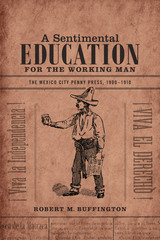 A Sentimental Education for the Working Man: The Mexico City Penny Press, 1900-1910
Robert M. Buffington
Duke University Press, 2015 In A Sentimental Education for the Working Man Robert Buffington reconstructs the complex, shifting, and contradictory ideas about working-class masculinity in early twentieth-century Mexico City. He argues that from 1900 to 1910, the capital’s satirical penny press provided working-class readers with alternative masculine scripts that were more realistic about their lives, more responsive to their concerns, and more representative of their culture than anything proposed by elite social reformers and Porfirian officials. The penny press shared elite concerns about the destructive vices of working-class men, and urged them to be devoted husbands, responsible citizens, and diligent workers; but it also used biting satire to recast negative portrayals of working-class masculinity and to overturn established social hierarchies. In this challenge to the "macho" stereotype of working-class Mexican men, Buffington shows how the penny press contributed to the formation of working-class consciousness, facilitated the imagining of a Mexican national community, and validated working-class men as modern citizens.
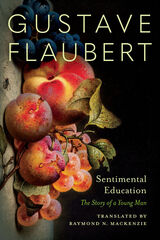 Sentimental Education: The Story of a Young Man
Gustave Flaubert
University of Minnesota Press, 2024 A fresh and vivid translation of Flaubert’s influential bildungsroman
Gustave Flaubert conceived Sentimental Education, his final complete novel, as the history of his own generation, one that failed to fulfill the promise of the Revolution of 1848. Published a few months before the start of the 1870 Franco–Prussian War, it offers both a sweeping panorama of French society over three decades and an intimate bildungsroman of a young man from a small town who arrives in Paris when protests against the monarchy are increasing.
The novel’s protagonist, Frédéric Moreau, alternates between aimlessness and ambition as he searches for a meaningful life through love affairs and republican politics. Flaubert’s narrative includes scenes of high drama, as scattered protests across Paris swell into revolution, and quiet moments of self-aware romanticism, crafting a story that possesses the sweep and scope of a historical novel combined with deep emotion and scandalous intimacy. Suffused with tragedy and the poignancy of lost chances and wasted lives, Sentimental Education is sharpened by satirical observations of what Flaubert condemned as the Second Empire’s endemic hypocrisy and willful blindness. This vibrant, new translation by Raymond N. MacKenzie includes an extensive critical introduction and annotations to help the modern reader appreciate Flaubert’s achievement. Sentimental Education intertwines the personal, the intimate, and the subjective with the political, social, and cultural, embedding Frédéric’s story in the larger arc of what Flaubert saw as France’s decline into mediocrity and imbecility in its politics and manners.
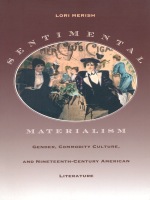 Sentimental Materialism: Gender, Commodity Culture, and Nineteenth-Century American Literature
Lori Merish
Duke University Press, 2000 In Sentimental Materialism Lori Merish considers the intricate relationship between consumption and womanhood in the late eighteenth and nineteenth centuries. Taking as her starting point a diversity of cultural artifacts—from domestic fiction and philosophical treatises to advice literature and cigars—Merish explores the symbolic functions they served and finds that consumption evolved into a form of personal expressiveness that indicated not only a woman’s wealth and taste but also her race, class, morality, and civic values. The discursive production of this new subjectivity—the feminine consumer—was remarkably influential, helping to shape American capitalism, culture, and nation building. The phenomenon of female consumption was capitalism’s complement to male production: It created what Merish calls the “Other Protestant Ethic,”a feminine and sentimental counterpart to Max Weber’s ethic of hard work, economic rationality, and self-control. In addition, driven by the culture’s effort to civilize the “cannibalistic” practices of ethnic, class, and national otherness, appropriate female consumerism, marked by taste and refinement, identified certain women and their families as proper citizens of the United States. The public nature of consumption, however, had curiously conflicting effects: While the achievement of cultured material circumstances facilitated women’s civic agency, it also reinforced stereotypes of domestic womanhood. Sentimental Materialism’s inquiry into middle-class consumption and accompanying ideals of womanhood will appeal to readers in a variety of disciplines, including American studies, cultural studies, feminist theory, and cultural history.
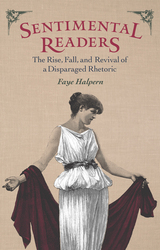 Sentimental Readers: The Rise, Fall, and Revival of a Disparaged Rhetoric
Faye Halpern
University of Iowa Press, 2013 How could novels like Uncle Tom’s Cabin change the hearts and minds of thousands of mid-nineteenth-century readers, yet make so many modern readers cringe at their over-the-top, tear-filled scenes? Sentimental Readers explains why sentimental rhetoric was so compelling to readers of that earlier era, why its popularity waned in the latter part of the nineteenth century, and why today it is generally characterized as overly emotional and artificial. But author Faye Halpern also does more: she demonstrates that this now despised rhetoric remains relevant to contemporary writing teachers and literary scholars.
Halpern examines these novels with a fresh eye by positioning sentimentality as a rhetorical strategy on the part of these novels’ (mostly) female authors, who used it to answer a question that plagued the male-dominated world of nineteenth-century American rhetoric and oratory: how could listeners be sure an eloquent speaker wasn’t unscrupulously persuading them of an untruth? The authors of sentimental novels managed to solve this problem even as the professional male rhetoricians and orators could not, because sentimental rhetoric, filled with tears and other physical cues of earnestness, ensured that an audience could trust the heroes and heroines of these novels. However, as a wider range of authors began wielding sentimental rhetoric later in the nineteenth century, readers found themselves less and less convinced by this strategy.
In her final discussion, Halpern steps beyond a purely historical analysis to interrogate contemporary rhetoric and reading practices among literature professors and their students, particularly first-year students new to the “close reading” method advocated and taught in most college English classrooms. Doing so allows her to investigate how sentimental novels are understood today by both groups and how these contemporary reading strategies compare to those of Americans more than a century ago. Clearly, sentimental novels still have something to teach us about how and why we read.
 Sentimental Republic: Chinese Intellectuals and the Maoist Past
Hang Tu
Harvard University Press, 2025 How does emotion shape the landscape of public intellectual debate? In Sentimental Republic, Hang Tu proposes emotion as a new critical framework to approach a post-Mao cultural controversy. As it entered a period of market reform, China did not turn away from revolutionary sentiments. Rather, the post-Mao period experienced a surge of emotionally charged debates about red legacies, ranging from the anguished denunciations of Maoist violence to the elegiac remembrances of socialist egalitarianism.
Sentimental Republic chronicles forty years (1978–2018) of bitter cultural wars about the Maoist past. It analyzes how the four major intellectual clusters in contemporary China—liberals, the Left, cultural conservatives, and nationalists—debated Mao’s revolutionary legacies in light of the postsocialist transition. Should the Chinese condemn revolutionary violence and “bid farewell to socialism”? Or would a return to revolution foster alternative visions of China’s future path? Tu probes the nexus of literature, thought, and memory, bringing to light the dynamic moral sentiments and emotional excess at work in these post-Mao ideological contentions. By analyzing how rival intellectual camps stirred up melancholy, guilt, anger, and resentment, Tu argues that the polemics surrounding the country’s past cannot be properly understood without reading the emotional trajectories of the post-Mao intelligentsia.
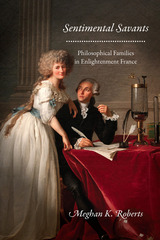 Sentimental Savants: Philosophical Families in Enlightenment France
Meghan K. Roberts
University of Chicago Press, 2016 Though the public may retain a hoary image of the lone scientific or philosophical genius generating insights in isolation, scholars discarded it long ago. In reality, the families of scientists and philosophers in the Enlightenment played a substantial role, not only making space for inquiry within the home but also assisting in observing, translating, calculating, and illustrating.
Sentimental Savants is the first book to explore the place of the family among the savants of the French Enlightenment, a group that openly embraced their families and domestic lives, even going so far as to test out their ideas—from education to inoculation—on their own children. Meghan K. Roberts delves into the lives and work of such major figures as Denis Diderot, Émilie Du Châtelet, the Marquis de Condorcet, Antoine Lavoisier, and Jérôme Lalande to paint a striking portrait of how sentiment and reason interacted in the eighteenth century to produce not only new kinds of knowledge but new kinds of families as well.
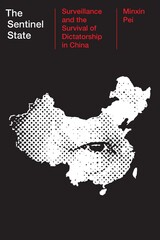 The Sentinel State: Surveillance and the Survival of Dictatorship in China
Minxin Pei
Harvard University Press, 2023 Countering recent hype around technology, a leading expert argues that the endurance of dictatorship in China owes less to facial recognition AI and GPS tracking than to the human resources of the Leninist surveillance state.
China watchers long argued that economic liberalization and prosperity would be harbingers of democracy. Instead, the Communist Party’s grip has strengthened. How? The answer lies in the effectiveness of the surveillance state. And the source of that effectiveness is not just facial recognition AI and phone tracking. Technology is important, but what matters more is China’s vast army of domestic spies.
Central government surveillance data is confidential, so Minxin Pei turned to local reports, police gazettes, leaked documents, and interviews with exiled dissidents to provide a detailed look at the evolution, organization, and tactics of the surveillance state. Following the 1989 Tiananmen uprising, the Party invested in a coercive apparatus operated by a small number of secret police capable of mobilizing millions of citizen informants. The Party’s Leninist bureaucratic structure—whereby officials and activists penetrate every sector of the economy and civil society, from universities to delivery companies to monasteries—ensures that Beijing’s eyes and ears are everywhere.
Rigorously empirical and rich in historical insight, The Sentinel State is a singular contribution to our knowledge about Chinese state coercion and, more generally, the survival strategies of authoritarian regimes.
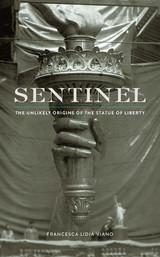 Sentinel: The Unlikely Origins of the Statue of Liberty
Francesca Lidia Viano
Harvard University Press, 2018 The story of the improbable campaign that created America’s most enduring monument.
The Statue of Liberty is an icon of freedom, a monument to America’s multiethnic democracy, and a memorial to Franco-American friendship. That much we know. But the lofty ideals we associate with the statue today can obscure its turbulent origins and layers of meaning. Francesca Lidia Viano reveals that history in the fullest account yet of the people and ideas that brought the lady of the harbor to life.
Our protagonists are the French sculptor Frédéric Auguste Bartholdi and his collaborator, the politician and intellectual Édouard de Laboulaye. Viano draws on an unprecedented range of sources to follow the pair as they chase their artistic and political ambitions across a global stage dominated by imperial rivalry and ideological ferment. The tale stretches from the cobblestones of northeastern France, through the hallways of international exhibitions in London and Paris, to the copper mines of Norway and Chile, the battlegrounds of the Franco-Prussian War, the deserts of Egypt, and the streets of New York. It features profound technical challenges, hot air balloon rides, secret “magnetic” séances, and grand visions of a Franco-American partnership in the coming world order. The irrepressible collaborators bring to their project the high ideals of liberalism and republicanism, but also crude calculations of national advantage and eccentric notions adopted from orientalism, freemasonry, and Saint-Simonianism.
As entertaining as it is illuminating, Sentinel gives new flesh and spirit to a landmark we all recognize but only dimly understand.
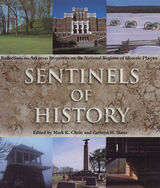 Sentinels of History: Reflections on Arkansas Properties on the National Register of Historic Places
Mark Christ
University of Arkansas Press, 2000 Sentinels of History was conceived of as a way to mark the turn of the millennium by the Arkansas Historic Preservation Program. This generously illustrated book contains thirty-nine essays, each of which showcases an important Arkansas site and is written by a noted authority. Also included is a location map for these sites and a full appendix providing location information, county by county, for the more than two thousand surviving properties in Arkansas (as of June 1999) that appear on the National Register. The essays are as wide-ranging as Roger Kennedy's placement of the Toltec Mounds at the time of Charlemagne, Donald Harington's sensitive look at the "bigeminal" architecture of the Wolf dogtrot cabin, and Neil Compton's egalitarian tribute to the Boxley Valley Historic District on the Buffalo National River. At least one current color photo of the site and one historic image are included with each essay. In addition, illustrations of the locations or structures listed in the appendix are scattered throughout sections. In all, Sentinels of History serves as a lavish inventory of historic properties in Arkansas at the end of the twentieth century.
 Separate and Unequal: The Inside Story of Israeli Rule in East Jerusalem
Amir S. Cheshin, Bill Hutman, and Avi Melamed
Harvard University Press, 1999 This vivid behind-the-scenes account of Israeli rule in Jerusalem details for the first time the Jewish state's attempt to lay claim to all of Jerusalem, even when that meant implementing harsh policies toward the city's Arab population.
The authors, Jerusalemites from the spheres of politics, journalism, and the military, have themselves been players in the drama that has unfolded in east Jerusalem in recent years and appears now to be at a climax. They have also had access to a wide range of official documents that reveal the making and implementation of Israeli policy toward Jerusalem. Their book discloses the details of Israel's discriminatory policies toward Jerusalem Arabs and shows how Israeli leaders mishandled everything from security and housing to schools and sanitation services, to the detriment of not only the Palestinian residents but also Israel's own agenda. Separate and Unequal is a history of lost opportunities to unite the peoples of Jerusalem.
A central focus of the book is Teddy Kollek, the city's outspoken mayor for nearly three decades, whose failures have gone largely unreported until now. But Kollek is only one character in a cast that includes prime ministers, generals, terrorists, European and American leaders, Arab shopkeepers, Israeli policemen, and Palestinian schoolchildren. The story the authors tell is as dramatic and poignant as the mosaic of religious and ethnic groups that call Jerusalem home. And coming at a time of renewed crisis, it offers a startling perspective on past mistakes that can point the way toward more equitable treatment of all Jerusalemites.
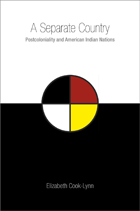 A Separate Country: Postcoloniality and American Indian Nations
Elizabeth Cook-Lynn
Texas Tech University Press, 2012 Elizabeth Cook-Lynn takes academia to task for its much-touted notion that “postcoloniality” is the current condition of Indian communities in the United States. She finds the argument neither believable nor useful—at best an ivory-tower initiative on the part of influential scholars, at worst a cruel joke. In this fin de career retrospective, Cook-Lynn gathers evidence that American Indians remain among the most colonized people in the modern world, mired in poverty and disenfranchised both socially and politically. Despite Native-initiated efforts toward seeking First Nationhood status in the U. S., Cook-Lynn posits, Indian lands remain in the grip of a centuries-old English colonial system—a renewable source of conflict and discrimination. She argues that proportionately in the last century, government-supported development of casinos and tourism—peddled as an answer to poverty—probably cost Indians more treaty-protected land than they lost in the entire nineteenth century. Using land issues and third-world theory to look at the historiography of the American Plains Indian experience, she examines colonization’s continuing assault on Indigenous peoples.
 Separate Destinations: Migration, Immigration, and the Politics of Places
James G. Gimpel
University of Michigan Press, 1999 Natives who change residence do not settle in the same places as immigrants. Separate Destinations argues that these distinct mobility patterns, coupled with record levels of immigration from impoverished third world nations, are balkanizing the American electorate. James G. Gimpel examines the consequences of different patterns of movement and settlement on the politics of the communities in which these different groups settle.
Newer immigrants are con-strained by a lack of education, money, English literacy, and information--and frequently by discrimination--to live in areas of coethnic settlement. Domestic, native-born migrants--predominantly Caucasian--free of discrimination and possessing more money and information, move where they wish, often to communities where immigrants are not welcome or cannot afford to live. Strong evidence suggests that spatially isolated immigrants are slower to naturalize and get involved in politics than domestic migrants.
Gimpel looks closely at states with very different patterns of migration and immigration: California, Colorado, Kansas, Kentucky, Florida, Pennsylvania, and New York. In these states, Gimpel shows the impact of population mobility on party registration, party votes, and voter turnout and asks whether population changes have changed the dominant party in a state or produced a political reaction from natives.
Separate Destinations contains a number of thematic maps detailing the settlement patterns of internal migrants and immigrants for both counties and census tracts. Blending insights from a number of social science disciplines, including economics, demography, sociology, political science, and anthropology, this book will be of interest to a wide and diverse readership of scholars, students, and policymakers.
James G. Gimpel is Associate Professor of Government, University of Maryland.
|
|
